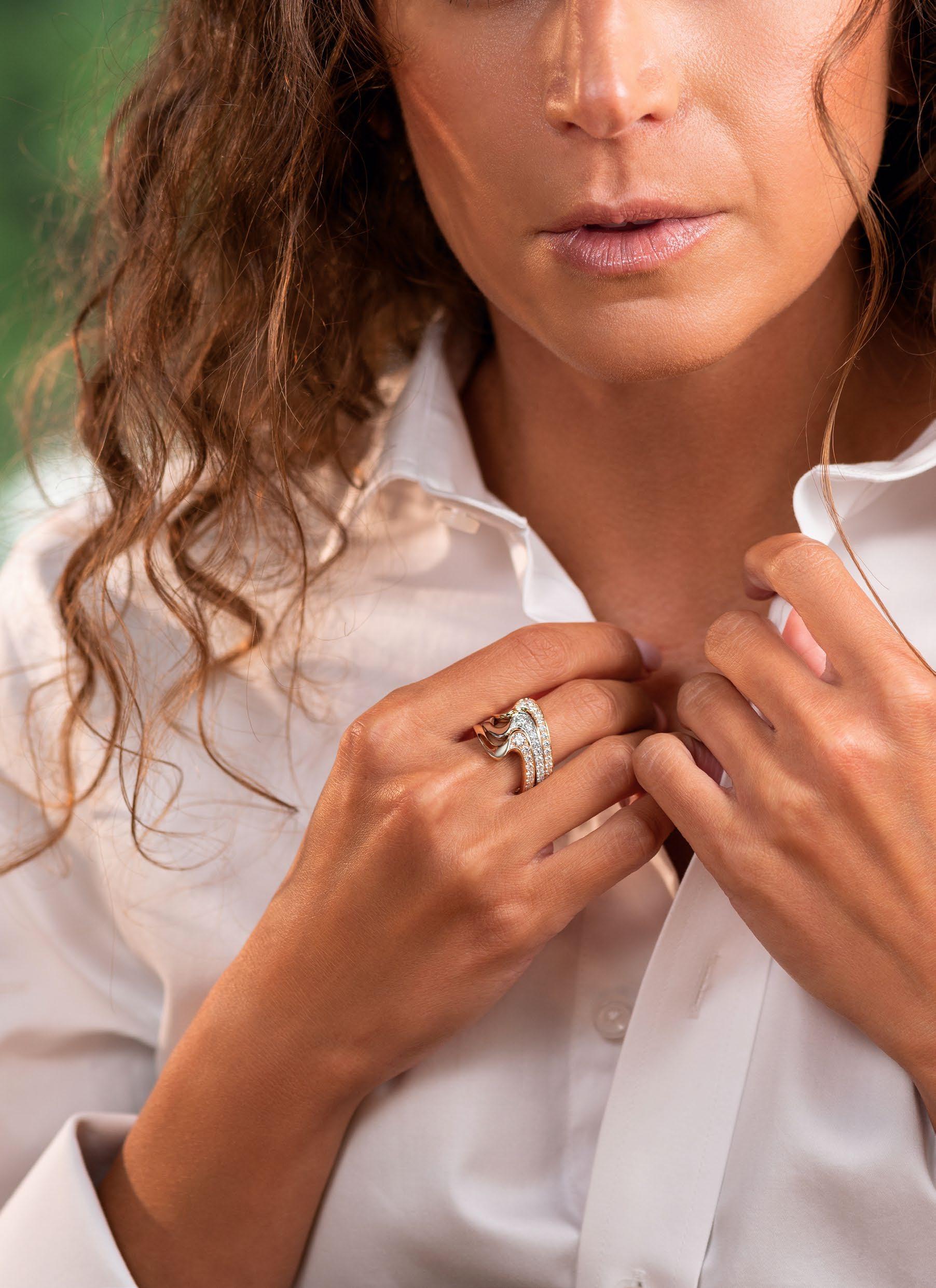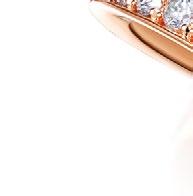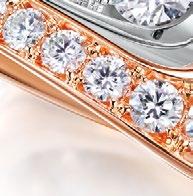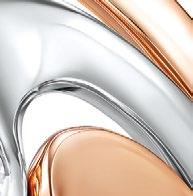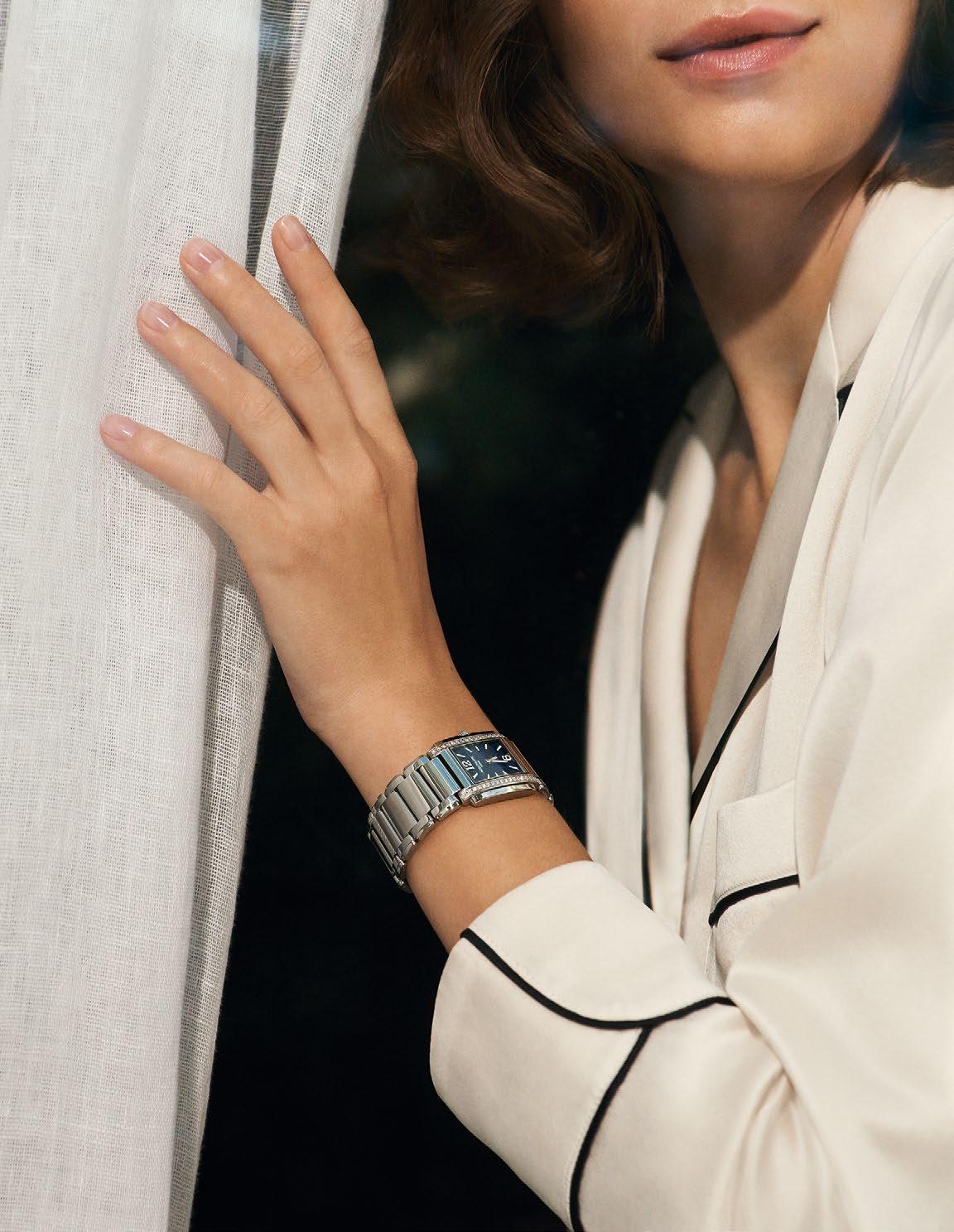












































































































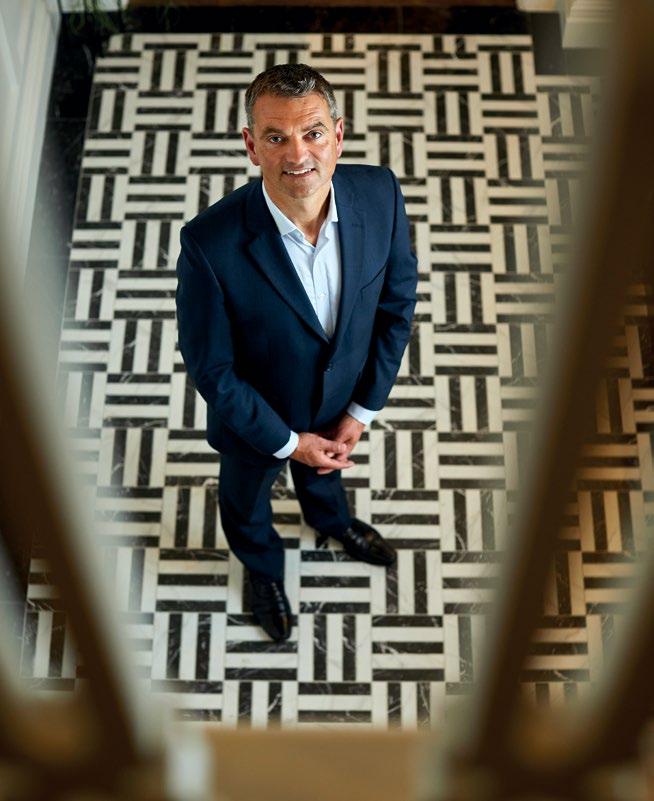
Welcome to the latest edition of Iconic magazine, your window on the world of Iconic Luxury Hotels. The hotels that make up the collection are our passion, each offering a unique sense of time and place. They are welcoming hives of warm and genuine hospitality, and we take pride in their hidden stories, their influences and character which is central to the DNA of Iconic.
Art and Royalty are warmly saluted through the stunning front cover of this year’s publication and we are indebted to artist Jonathan Yeo for kindly giving Iconic an exclusive insight into his portrait of our new King. You will also find a strong artistic connection with the 150-year-old creative revolution that happened in Broadway, home of The Lygon Arms, and we continue to cherish our privileged ties with one of the most beautiful art spaces in London, the Saatchi Gallery in Chelsea, as it celebrates 40 years. This issue features a cultural ‘road trip’ in the
company of our good friend, chef, and motoring aficionado James Martin, who brings his influence to bear on both The Lygon Arms and The Kitchen at Chewton Glen. We have a chat with the Chairman of the Henley Royal Regatta and the Chair of the All England Lawn Tennis Club at Wimbledon, explore what makes a National Trust garden, and delve into the secret of the beauty world’s new super-ingredient, the mushroom!
This year, we celebrate the opening of our first hotel in the US, the Palm House in Florida’s Palm Beach; we also embark on an exciting project to redesign the restaurant, lounges, bar, and several bedrooms of our very first Iconic property, Chewton Glen, as we count down to the hotel’s 60th anniversary in 2026.
We hope you enjoy the magazine and on behalf of myself and our thousand-strong team who make up the Iconic Luxury Hotels family, we look forward to welcoming you over the coming year.

ANDREW STEMBRIDGE EXECUTIVE DIRECTOR, ICONIC LUXURY HOTELS

22 LUXURY MEANS BUSINESS
Why the luxury sector is worth a fortune to the UK. By Poppy Day
26 JAMES MARTIN: CARS & CUISINE
Road trip from Chewton Glen to The Lygon Arms. By Tom Howard
32 NEW LUXURY FROM ANCIENT CRAFTS
The latest, and oldest, jewellery revolution. By Rachael Taylor
52 BY ROYAL APPOINTMENT
The protocol of the Royal Warrant
66 A NEW HORIZON Luxury yacht maker
Sunseeker partners with Iconic
88 THE DREAM FACTORY
McLaren’s barely believable 60-year Boy’s Own story
94 CHELSEA’S ROYAL LUXURY HUB
On the fabled lawns of Royal Hospital Chelsea
62 INVESTING IN A HANDBAG
Not just a fashion item but an investment. By Alexandra Carello
82 THE BRIDE WORE… WHAT SHE LIKED
The rise of the non-traditional wedding. By Rebecca Cope
14 A FLORIDA OASIS
Our new Palm Beach hotel
24 DIARY HIGHLIGHTS
The must-not-miss dates for your social calendar
39 GUARDIANS OF UK’S SPORTING JEWELS
Meet the heads of Henley and Wimbledon. By Lucy Higginson
58 THE LOVE OF BRITAIN’S GARDENS
What does it take to make a National Trust garden
79 HIDDEN STORIES BEAUTIFULLY TOLD
Meet Iconic’s Executive Director. By Fiona Duncan
Magazine Project Director Angela Day
Managing Director Richard Woolliams
Creative Director Gareth Evans
Editorial Director Fergus McShane
Managing Editor Greg Fountain
Art Editors Lindsay Price, Owen Moran
Commercial Director Gary Turner
Client Services Director Isobel Robson
Digital Development Director Dave Stone
Production & Operations Manager Alex Murphy
For media sales enquiries contact gary.turner@newhallpublishing.com
44 HEATING FOR THE SOUL
Embrace the magic of a fortified wine. By Ollie Smith
16 FORTY YEARS OF SAATCHI GALLERY
A milestone for contemporary art
48 THE KING AND I
Jonathan Yeo on his portrait of King Charles III
70 BROADWAY’S ART COLONY
A Victorian artistic revolution in a quaint Cotswolds village
54 THE SHROOM BOOM
Mushrooms are taking over the beauty world. By Susan d’Arcy
74 THE WELLNESS CONUNDRUM
If you have to work at wellness, can you relax? By Seán Williams
86 A HAIR REVOLUTION
Welcoming a gamechanger

Award-winning broadcaster and wine expert Olly is a regular on BBC’s Saturday Kitchen, hosts his own drinks podcast and writes for Daily Mail Weekend magazine. His recent book features cocktails from Iconic hotels.

Alexandra has more than 15 years’ experience in fashion industry PR, with Louis Vuitton, Burberry, Jimmy Choo and Net-a-Porter. She founded Alexandra Carello Consulting, and is chair of the Royal Marsden’s first official committee.

Rachael was the founding editor of Professional Jeweller and WatchPro magazines. She regularly contributes to a wealth of titles including The Financial Times, The Telegraph, The Independent, Spear’s, Retail Jeweller and Rapaport

Hotel expert Fiona has been writing about hotels since 1986. She has been The Telegraph’s hotels editor for 27 years and in 2006 began her column Hotel Guru for the Sunday Telegraph. She has written many books and travel guides.

Susan is the hotels and wellness editor for The Times and The Sunday Times Filthy work but someone has to do it, or so she tells her editor! She is a regular on television talking about travel and is also a hotel and wellness consultant.

Tom is founder of The Gentleman Racer, an independent media consultancy specialising in luxury lifestyle brands. He works with creatives to deliver an insightful look behind the scenes of the fashion and automotive world.

An award-winning journalist, Lucy became the first female editor of Horse & Hound in 2002. She now combines journalism with PR, marketing, research and brand development projects, and is an editor of The Good Schools Guide

Seán is senior lecturer in German and European cultural history at the University of Sheffield. For BBC Radio 3 he presented The Deluxe Edition, and Death in Trieste, a five-part essay uncovering an infamous murder.

Former Tatler digital director Rebecca has worked for Grazia and Harper’s Bazaar, and is now a freelance contributor to Vogue, ELLE, the Sunday Times Style, Sunday Times magazine, The Telegraph and the FT’s HTSI

The R410 music system has been designed for streaming. With Spotify, TIDAL, Apple AirPlay and Google Cast built-in. The perfect source of effortless listening pleasure, created for the way we live now. ruarkaudio.com

The first of our kind, Chewton Glen is an 18th century luxury country house with an emphasis on traditional English-style and comfort. Set in one of the UK’s most beautiful locations, bordering the New Forest – with 130 acres of Hampshire’s countryside as our playground – the hotel is just 10 minutes walk from the beaches of the South Coast. Indulge yourself in the five-star luxury of the hotel and spa, with exquisite cuisine including The Kitchen by James Martin. Alternatively, touch the skies in one of our private Treehouse Suites, complete with hot tub, concierge and mini kitchenette.
T: 01425 282212 E: reservations@chewtonglen.com W: chewtonglen.com
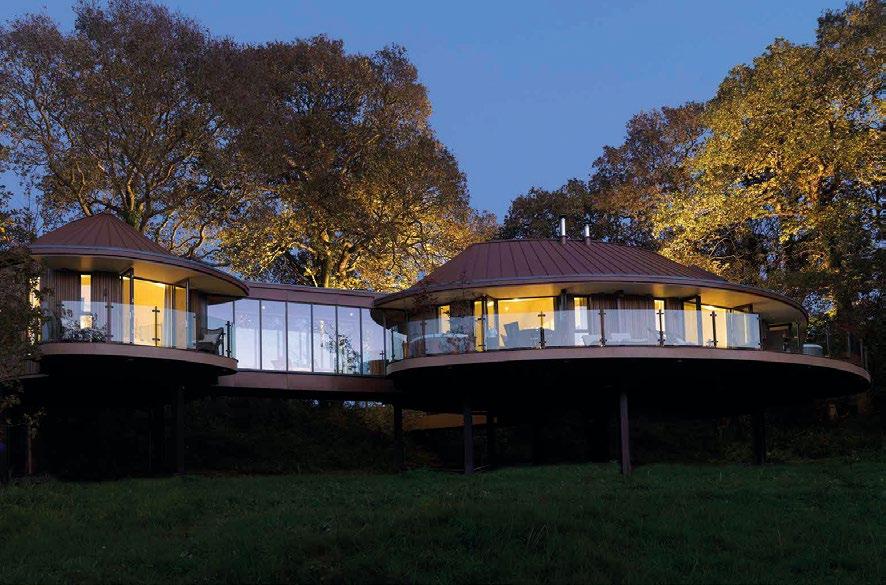
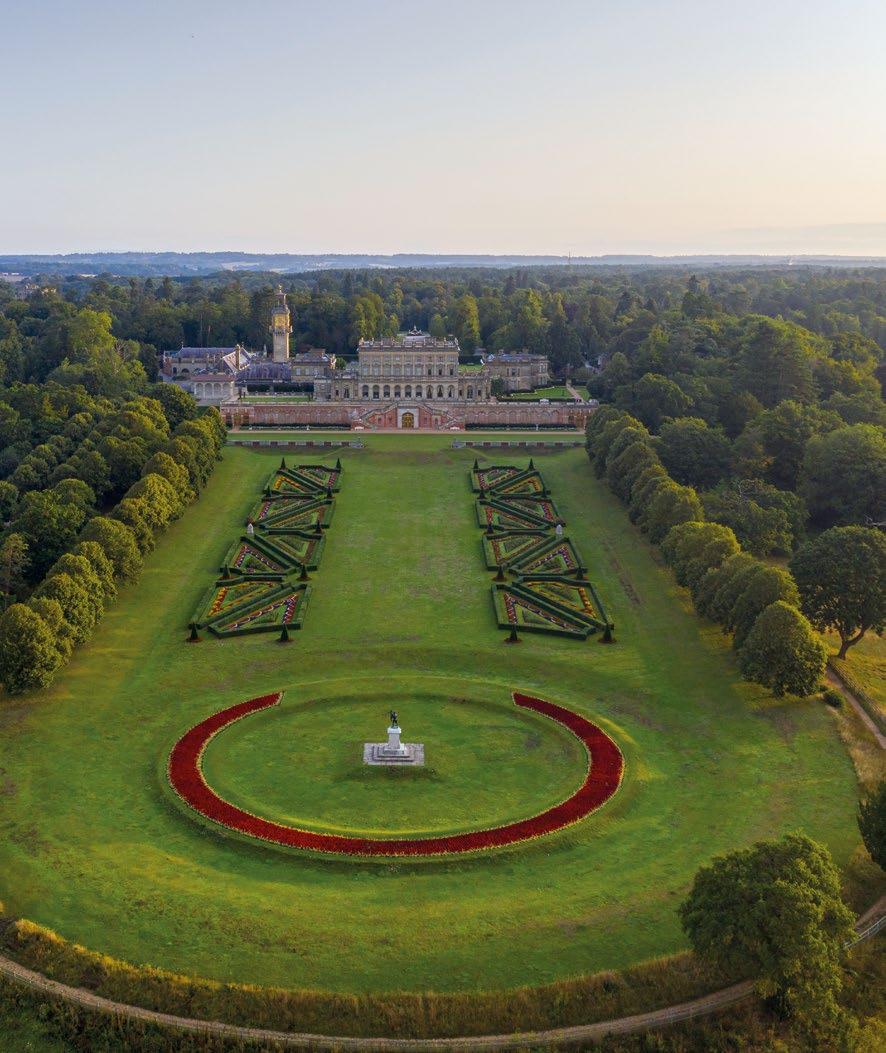
This magnificent National Trust country house, set in 376 acres of meticulously presented Grade I-listed grounds in the heart of beautiful Berkshire, is home to a five-star, award-winning hotel and spa. Built in 1666 by the second Duke of Buckingham as a gift for his mistress, the setting, architecture and interiors all speak eloquently of extravagance and refinement, and there is a palpable sense of history, for this is a house that for more than 350 years has been dedicated to pleasure, power and politics. Today, Cliveden House stands by to welcome you to create your own moment in its history, whether in a glorious guestroom, sumptuous suite or the seclusion of the stunning three-bedroom Spring Cottage.
T: 01628 607107 E: reservations@clivedenhouse.co.uk
W: clivedenhouse.co.uk
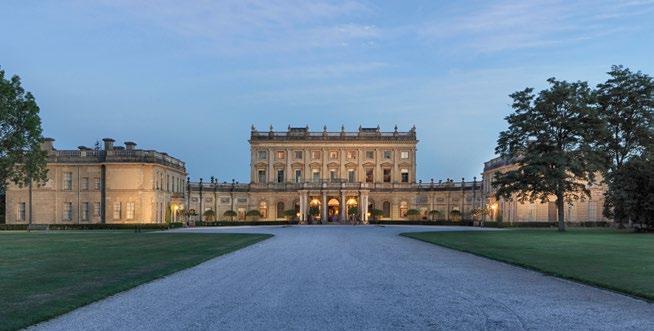
Located in the quintessentially English village of Broadway in the heart of the Cotswolds, The Lygon Arms is the perfect spot to switch off and relax (with or without your pampered pooch).
Steeped in over 600 years of fascinating history, this hotel has played host to both royalty and notable rebellious figures throughout the years. So much so that, if its honeyed walls could talk, they would tell stories of seven centuries of glamour and secrets. Nevertheless, staying true to its roots, this traditional building promises a warm welcome –with its cosy lounges, roaring log fires, and fantastic feasts in Grill by James Martin. Enjoy a relaxing spa and glorious guest rooms, including the famous Charles I suite.
T: 01386 852255
E: reservations@lygonarmshotel.co.uk
W: lygonarmshotel.co.uk

A place where the great and good have been meeting, celebrating and relaxing for over a century – and now it is your turn. To stay at 11 Cadogan Gardens is to experience the spirit of Chelsea. A five-star hotel where four grand townhouses are merged into one, the boutique 11 Cadogan Gardens is a most desirable address in the heart of London’s most fashionable district. With its quirky twists and playful vibe, the hotel offers the finest of the city’s culture right on the doorstep and immerses visitors in the relaxed village atmosphere of this beautiful and historic corner of the capital.
Sitting just across the hotel’s private garden square are six newly renovated, fully serviced apartments, each comprising an entire floor of a terracotta brick Victorian townhouse. With designer fittings, opulent living areas and multiple bedroom options, they are ideal for those searching for luxe-contemporary living and a longer stay.
T: 020 7730 7000 E: reservations@11cadogangardens.com W: 11cadogangardens.com
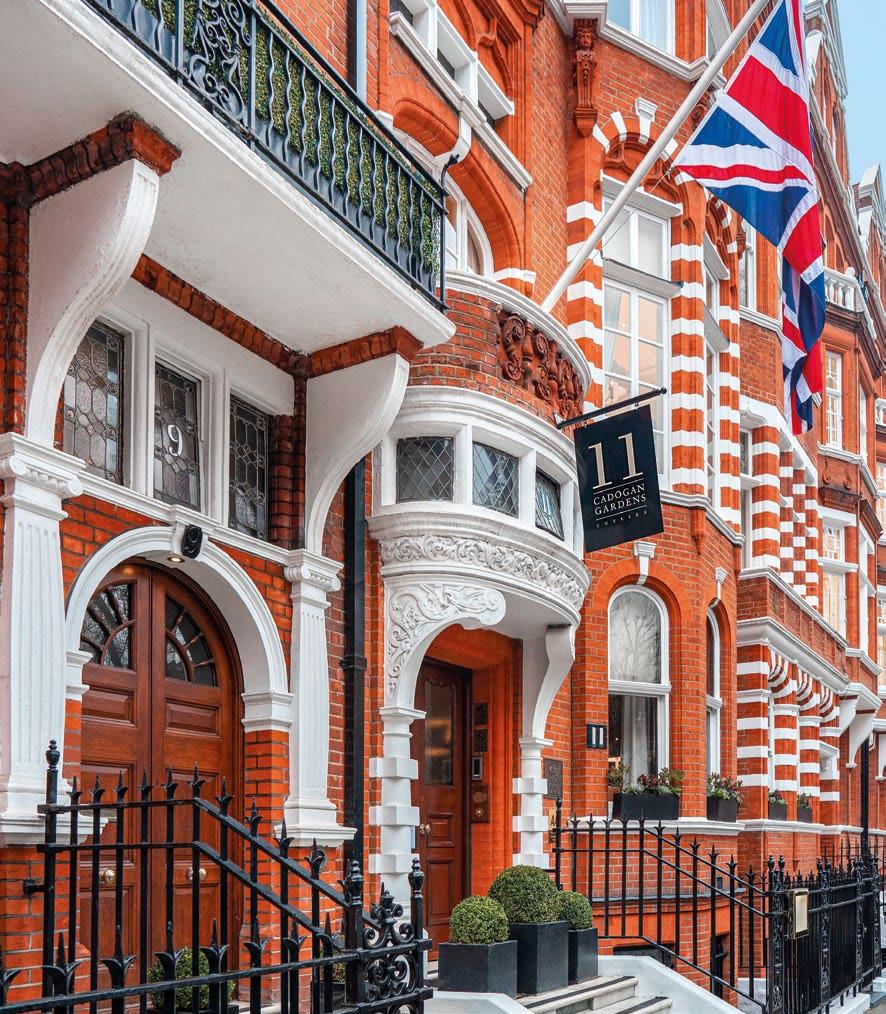
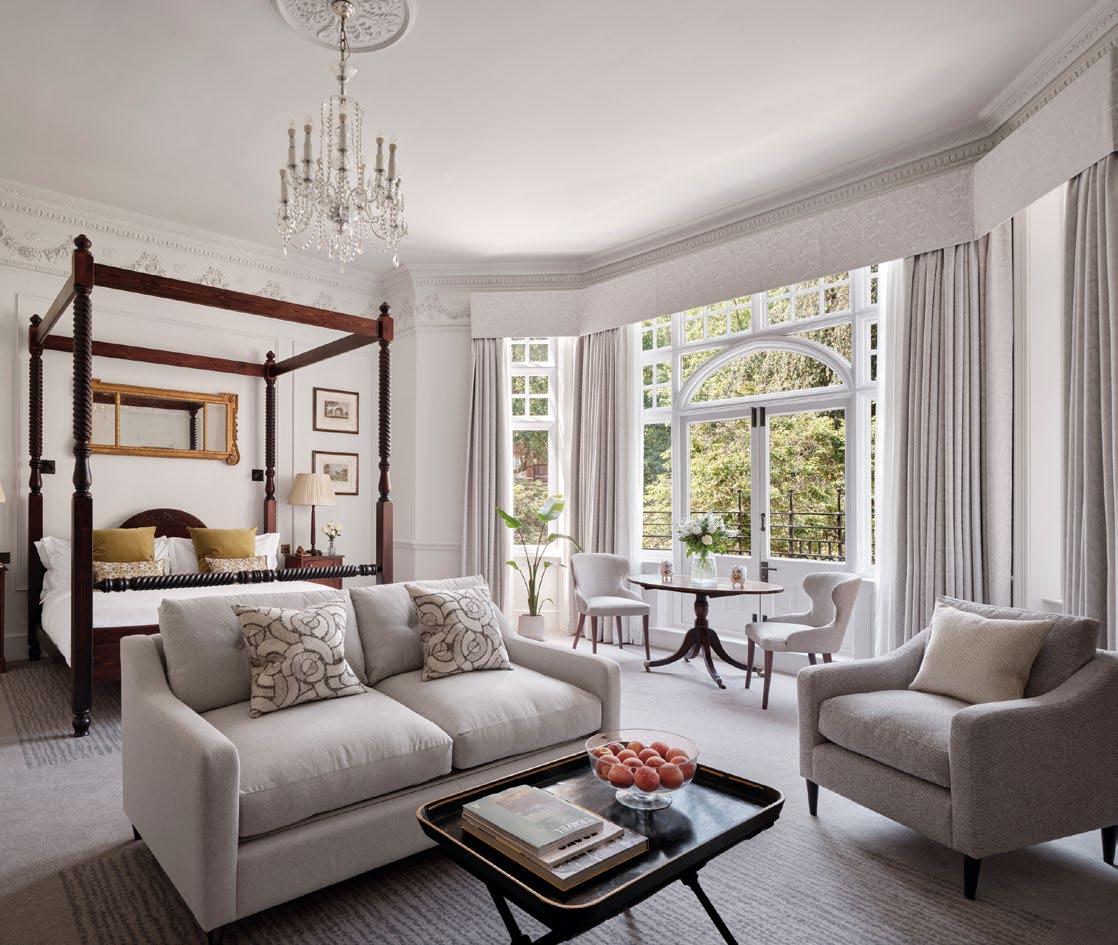
A peaceful Chelsea oasis nestled in the leafy serenity of Cadogan Gardens, a stone’s throw away from the vibrant Sloane Square, is the newest addition to the Iconic Luxury Hotels family in the UK. Do not let the stately façade of The Chelsea Townhouse fool you – behind its red-brick walls you will discover an elegantly understated, newly refurbished space, with an array of sophisticated rooms and suites overlooking the private garden square. Stay to enjoy the peace, explore the local village or venture into one of the capital’s most iconic neighbourhoods.
T: 020 7730 6466 E: reservations@ thechelseatownhouse.com W: thechelseatownhouse.com
Curious, engaging, witty and effortlessly intuitive, The Mayfair Townhouse is a new generation of lifestyle hotel delivering the unexpected. A stylish, imaginative home for the modern traveller, it redefines what it means to be a London hotel. Plus, access everything – including your room key – at the touch of a button with the brand-new Mayfair Townhouse app. Inspired by the whimsical characters of our past and present, the hotel is flamboyantly dressed yet carefully understated, delivering high-end services in a warm, convivial setting. Its rich heritage has been revived to create something memorable. Only steps away from Green Park, upscale shopping and several of London’s most acclaimed restaurants, The Mayfair Townhouse’s practical rooms and spacious suites offer a haven away from London’s bustling streets.
T: 020 8138 3400
E: reservations@themayfairtownhouse.com
W: themayfairtownhouse.com
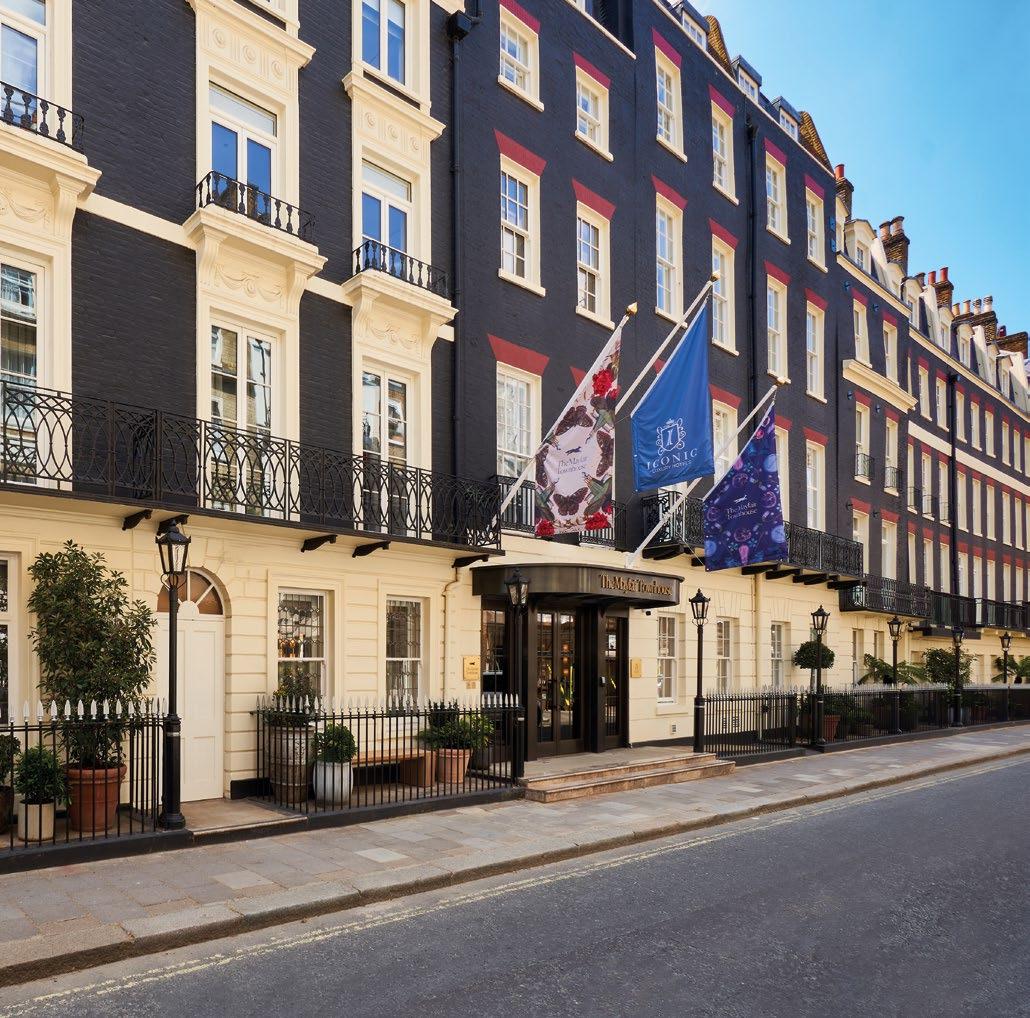
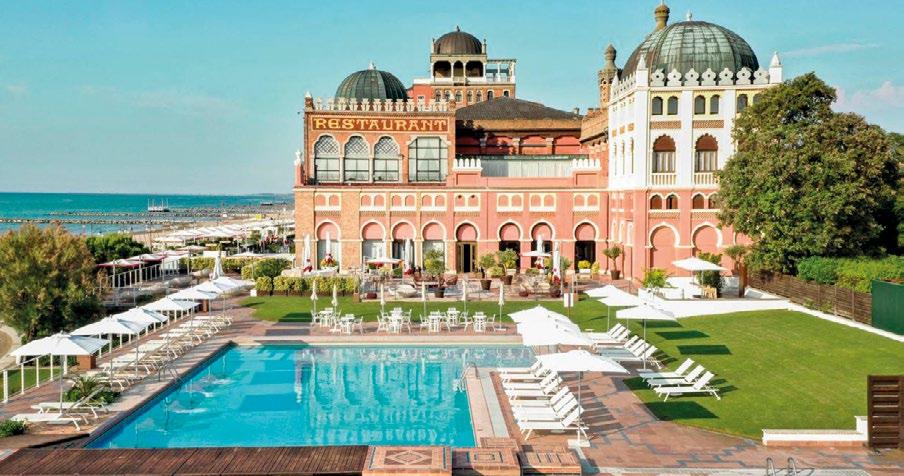

Just minutes from San Marco and fronted by a private beach, Hotel Excelsior brings a Moorish touch to the Venetian skyline. Its ornate domes and balustrades make a grand impression upon approach, promising a stay that is vibrant and serene in equal measure.
Its distinctive theme is echoed throughout the hotel’s 196 bedrooms, where Renaissance style and modern influences merge seamlessly. Diners at the resort can relax in the capable hands of executive chef Alessandro Ramella, who is renowned for his ability to fuse traditional Venetian cuisine with innovative culinary concepts.
Film fans may recognise Lido Island – upon which the Excelsior sits – as the venue of the Venice Film Festival. The hotel held the launch event for this cinematic celebration on its terrace in 1932.
T: +39 041 5260201
E: info@hotelexcelsiorvenezia.com
W: hotelexcelsiorvenezia.com
Iconic Luxury Hotels expands into the US with the opening of Palm House in Florida’s fashionable Palm Beach
Framed by its namesake trees, the seashell-pink exterior of the Palm House stretches along Royal Palm Way like a Florida sunrise.
Enter through the grand porte cochere and you will be greeted by a deliciously modern interior with more than a passing nod to vintage Palm Beach style.
Palm House is the first US property in the Iconic Luxury Hotels collection and is the vision of a design team led by US architects Cooper Carry, London-based interior designers Muza Lab and art consultant Minda Dowling.
The establishment opened its doors on 27 November 2024 and has been delighting visitors with the perfect balance of luxury and elegance since.
Leaving the tropical heat of Palm Beach outside, guests are treated to a showstopping first impression as they enter into the cool Palm Bar. Floor-to-ceiling windows admit a flood of white light while delicate, custom-made Murano-glass chandeliers cast a coral pink glow from the vaulted ceiling above.
Bartenders in white tuxedos grasp multi-coloured bottles from around
the globe, mixing classic cocktails and daring new drinks as guests relax with gourmet snacks.
Beyond this vibrant space is the airy lobby, decked out with plush, ruby-toned seating, reminiscent of a luxurious jewel box.
Palm House is just a short stroll from golden sands lapped by azure Atlantic waves.
The neighbourhood’s relaxing coastal vibe flows through the hotel’s décor, from textiles in fresh shades of coral and cream to a seashelladorned reception desk.
Carefully curated artwork


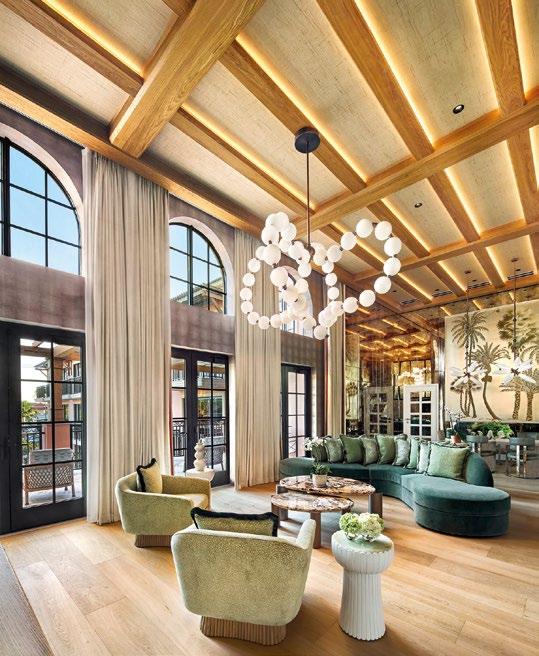
celebrates Palm Beach’s golden era, from Slim Aarons’ iconic photography celebrating the glamour of the 1950s to playful, contemporary images by photographers Tim MacPherson, Brad Walls and Dean West.
Two striking floor-to-ceiling seashell tapestries by West Palm Beach artist Christa Wilm create a surreal, eye-catching display, illustrating tropical fauna, fantastical flowers and fish against an iridescent cream abalone shell background.
The Palm House Dining Room, led by Executive Chef de Cuisine Jerry Ayala, offers an innovative menu that artfully fuses Japanese cuisine with Peruvian ingredients. Both inviting and sophisticated, guests and local residents can dine in style, surrounded by decorative oak walls and subtle, Japaneseinspired textures with vibrant turquoise accents.
A full food and beverage menu is available on the Sunset Pool Deck. This secluded sanctuary features a sunken heated pool, cabana beds and cushioned loungers – perfect for enjoying cool coastal breezes and that long-celebrated Florida sunshine.
Attentive pool butlers add special
“PALM HOUSE REPRESENTS THE BEST OF PALM BEACH – TIMELESS ELEGANCE, IMPECCABLE SERVICE AND A SENSE OF SERENITY”
touches such as Evian spritzes and sunglasses cleaning.
Palm House’s 58 guest rooms and 21 suites are among the largest in the area, averaging more than 550 square feet. Coastal allusions are borne throughout each space, with details such as coral-coloured headboards, custom-made woven sconces and antique mirrors.
The two-story Presidential Suite is the crown jewel of Palm House, offering nearly 2,000 square feet of sophisticated living space, breathtaking views and its own butler service.
With luxurious textures and calming tones of sandy beige and seafoam green, its plush furnishings and bespoke accents add an air of timeless opulence to the hotel’s beachy palette. The coffered ceiling of the living area is edged with palm-leaf embossing and a pendant light of delicate, golden metal palm leaves provides a stunning centrepiece.
The sweeping, second-floor
bedroom overlooks the living areas and boasts a 9’x9’ Alaskan King bed – the largest in Palm Beach.
General manager Natalie Le Clerc thrives on creating unforgettable experiences for guests, working alongside a passionate team dedicated to excellence.
“Each person who walks through the doors – whether staying with us overnight, experiencing our vibrant cocktail bar or enjoying a meal in our exquisite dining room – will feel as though they belong and are part of something truly special,” says Natalie. “It is incredibly fulfilling to be part of a team that brings Palm House’s unique vision to life and to see guests connect with the space in such a meaningful way.
“Palm House represents the best of Palm Beach – timeless elegance, impeccable service and a sense of serenity. It is exciting to bring fresh energy to a destination that holds such a special place in the hearts of travellers. I feel incredibly privileged to lead such a remarkable property.”
T: +1 561-858-1600 E: info@palmhouse.com W: palmhouse.com
London’s Saatchi Gallery turns 40 in 2025. It’s a milestone moment for contemporary art in the UK
Founded by Charles Saatchi in 1985, Saatchi Gallery emerged at a time when opportunities to experience new and innovative art were limited in London. Things have changed, in no small part down to the Gallery’s four decades of making contemporary art accessible to all, and providing a platform on which emerging talent could shine.
“We think contemporary art across all media – fashion, technology, street art, photography, any ways that creatives express themselves – is really important,” says Saatchi Gallery director Paul Foster.
“Contemporary art is underestimated and we are on a

mission to remind people how powerful and impactful it can be, and to encourage as many people to engage with it as possible, and then maybe to go and create art and be expressive themselves.
“The 40th anniversary is important to us. We do not want to just pat ourselves on the back, we want this to be a moment where we say art is important, seeing art is important. In our humble way, that’s the message. Hopefully people will buy into it.”
Saatchi Gallery was established to present the evolving Saatchi collection, and sought to make contemporary art more accessible to a wider audience. The vision of the Gallery was to showcase
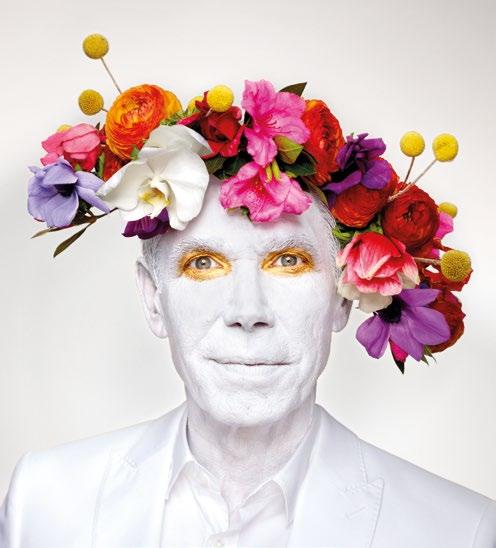
works that intrigued Charles, embodying his belief that “the more you like art, the more art you like.” This approach not only launched the careers of many emerging artists but also had a profound impact on contemporary art as a whole. Initially housed in an old paint factory in north London, the Gallery represented a bold new way of presenting contemporary art in the UK, becoming central to the booming art scene of the following decades. After a period at the old GLC building on the Embankment, it moved to its current location at the Duke of York’s Headquarters on King’s Road in Chelsea in 2009. Saatchi
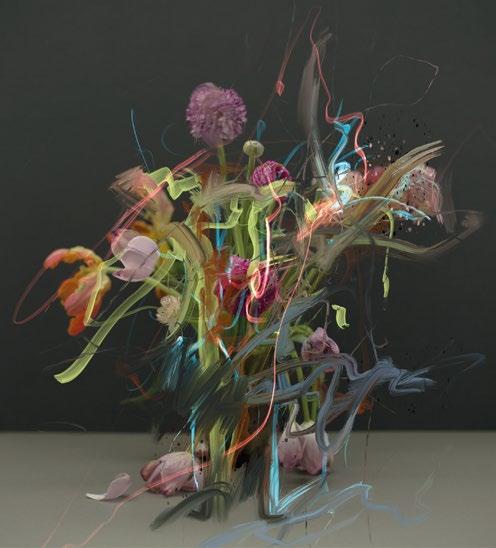
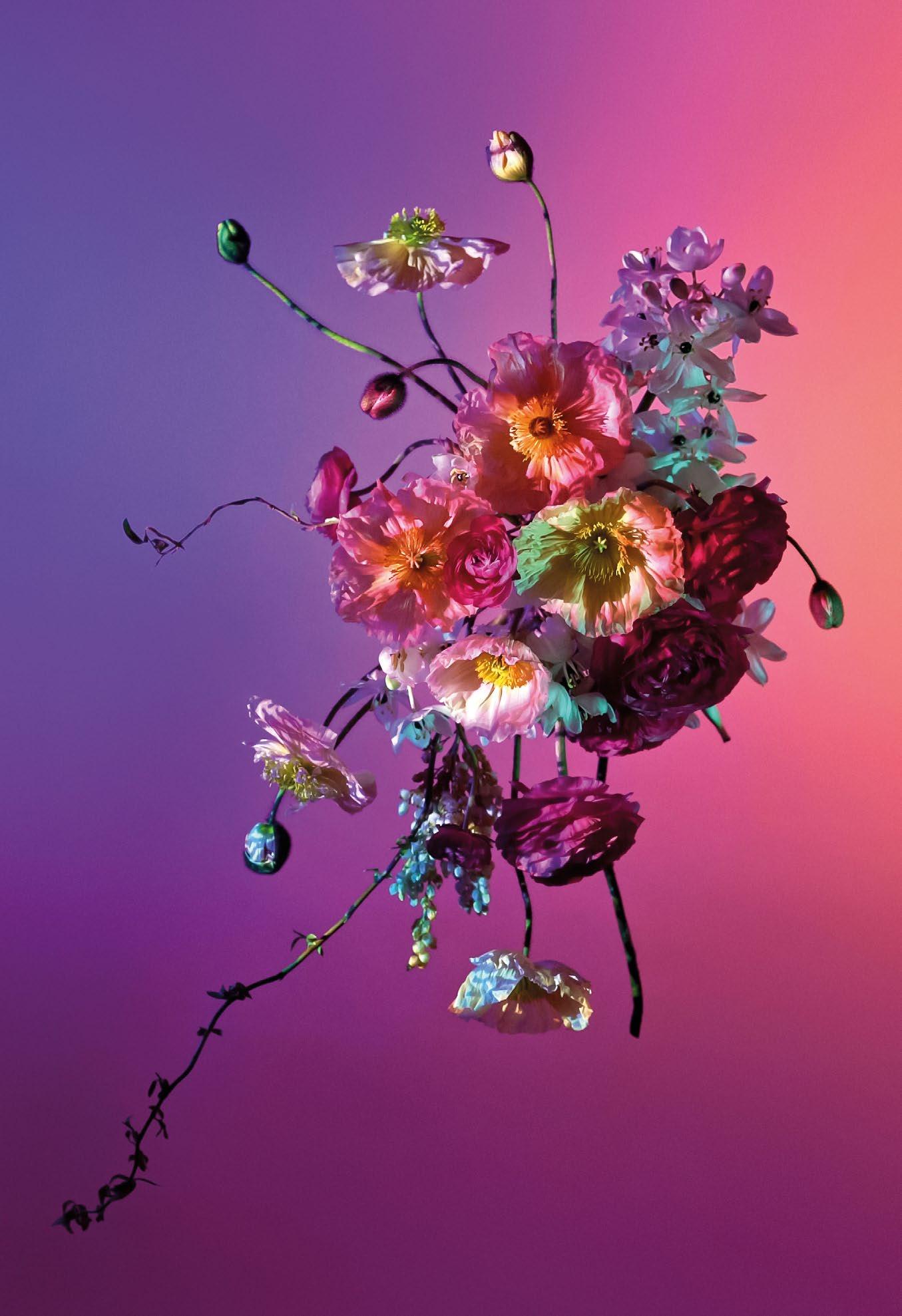
Gallery has since been hailed as one of London’s most beautiful art spaces, with accolades from The Observer as “one of the most beautiful art spaces in London,” CityAM as the “third most instagrammable gallery in the world,” and the New York Times calling it “Britain’s best-known and most popular gallery of cutting-edge contemporary art.”
In 2019, the Gallery transitioned from a private enterprise to a registered charity, introducing new trustees and management. This shift allowed it to move away from showcasing the Saatchi Collection, broadening its focus to present contemporary creativity in all its forms, particularly in the visual arts. This change solidified the Gallery’s commitment to supporting artists and making their work accessible to as wide an audience as possible, fostering cultural exchange and reflection through art.
“When we became a charity, we
really had to redefine ourselves,” says Paul Foster. “We had to ask ourselves who we are, what we do, and why we do it. We came up with a set of charitable goals, to make contemporary art as accessible as possible.”
One of the charity’s patrons is 11 Cadogan Gardens, and original art from Saatchi Gallery hangs on the walls of the hotel’s Chelsea Bar, refreshed with new work several times a year.
From the very beginning, Saatchi Gallery built its reputation on bold and fearless curation. Known for its daring approach, the Gallery broke from tradition by presenting movements and artists that were unfamiliar to many, such as American minimalism and abstraction from figures such as Cy Twombly and Brice Marden. The Gallery’s early exhibitions sparked conversations and controversy, contributing to the establishment of its enduring legacy.
Among the most iconic exhibitions in the 40-year history are Young British Artists (1992); Sensation (1997) held at Royal Academy of Arts and featuring works by 42 YBAs, including Damien Hirst, Tracey Emin, Marcus Harvey, Rachel Whiteread, Jake and Dinos Chapman, Chris Ofili, Ron Mueck, Jenny Saville and Sarah Lucas; and The Revolution Continues: New Art
From China at the Saatchi Gallery (2008). There are countless memorable stories reflecting the daring nature of the works through the years, such as the demolition of a caretaker’s flat and a wall in the Gallery to install Richard Serra’s monumental sculptures for his and Anselm Keifer’s first UK exhibition in 1986.
In 2019, alongside its transformation into a charity, the Gallery also marked the centenary of Howard Carter’s discovery of Tutankhamun’s tomb with the exhibition Tutankhamun:



“Known for its daring approach, the Gallery broke from tradition by presenting movements and artists that were unfamiliar to many”
Treasures of the Golden Pharaoh
In 2021, it welcomed visitors back after the Covid pandemic with a landmark exhibition by French artist JR, showcasing his projects from around this world in JR Chronicles. More recently, the Gallery has presented hugely popular exhibitions such as Beyond The Streets (2023), which explored graffiti and street art, Vision and Virtuosity by Tiffany & Co (2023), and Burtynsky: Extraction/Abstraction (2024), featuring the powerful photography of Edward Burtynsky documenting humanity’s impact on the planet.
At the heart of Saatchi Gallery’s mission is its commitment to showcasing art that is new and exciting. The Gallery focuses largely on emerging artists at the beginning of their careers, or international artists yet to receive recognition in the UK. Established artists also contribute to the exhibitions, adding depth and gravitas to the themes explored.
As a charity, Saatchi Gallery engages with schools and community groups through its
Learning programme, offering guided tours and workshops that encourage creativity and connection through art. The Gallery strives to be self-funded, reinvesting all revenue into its core activities to ensure access to contemporary art for all. Its charitable status has also facilitated impactful collaborations, such as with Prince William’s Homewards Foundation. In 2024, the Gallery co-hosted Homelessness: Reframed, an exhibition that highlighted the complexities of homelessness in the UK. It featured powerful works and included pieces created by young people at creative workshops across Homewards locations, enabling the public to engage with the stories of those with lived experience of homelessness.
Looking to the future, Saatchi Gallery’s 40th anniversary offers a moment to reflect on its remarkable past and envision what lies ahead. The Gallery’s major spring exhibition in 2025, Flowers – Flora in Contemporary Art & Culture, will open in
February. This extensive collection, occupying two floors and more than nine major gallery spaces, will explore the timeless inspiration of flowers on artistic creativity. Flowers have inspired artists throughout history, and this exhibition will showcase how they continue to be depicted in contemporary culture. With large-scale installations, original art, photography, fashion, archival objects, and graphic design, it will be a vibrant celebration of floral inspiration.
Another major exhibition in 2025 will delve into the Gallery’s archives, featuring works by British and international artists showcased over the past 40 years. Divided into decades, this exhibition will explore the cultural, political, and social context of each era, offering visitors a chance to journey through 40 years of contemporary art and visual culture, and assess its impact and influence. As Saatchi Gallery moves forward, it remains dedicated to inspiring and engaging audiences with the power of contemporary art.


Nestled in the rolling Berkshire countryside, Cliveden House is a sanctuary of timeless elegance—a place where indulgence reigns and moments linger. Within this iconic stately home lies the exquisite spa, an oasis where MONPURE invites you to discover a pioneering blend of scalp and hair wellness infused with the art of relaxation.
This unique collaboration between MONPURE and Cliveden House redefines self-care. It’s more than a treatment; it’s a journey—one that elevates scalp and hair health to an experience of pure luxury. From the moment you step through the spa doors, a sense of calm envelops you.
While we lavish attention on the skin of our faces, we often overlook our scalp—despite its critical role as the foundation for strong, healthy, and radiant hair. Did you know the scalp can age six times faster than facial skin? It’s vulnerable to dryness, irritation, and hormonal changes, yet rarely receives the care it deserves. MONPURE focuses on nurturing this overlooked area, creating the ideal environment for hair to flourish.
MONPURE’s award-winning treatments combine science and sensorial luxury. Potent active ingredients like retinol, vegan silk peptides, and salicylic acid work deeply to renew and fortify the hair, delivering visible results and enhancing the quality of your precious hair strands. Each experience begins with a personalised consultation, ensuring every treatment meets your unique needs while enveloping you in relaxation.
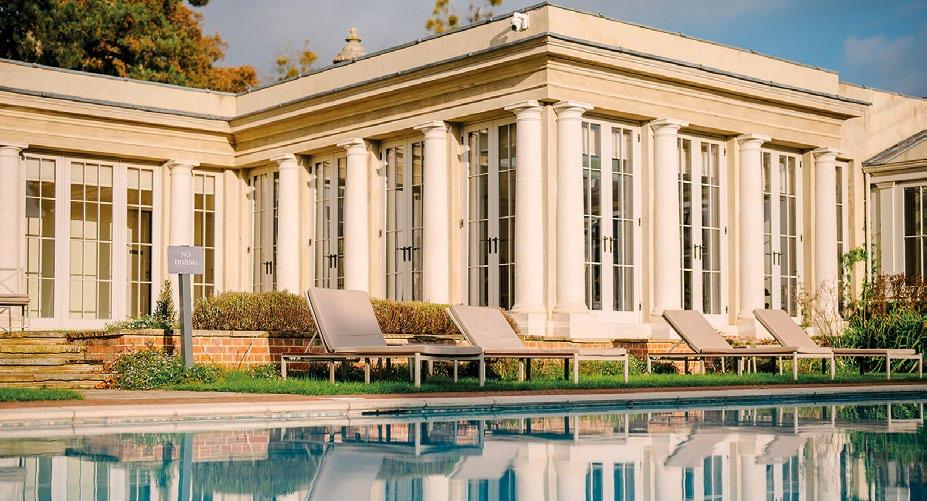

Unwind and feel completely refreshed with a 60-minute MONPURE treatment of your choice, designed to relax and restore your scalp and overall well-being.
Soothe irritation and dryness with a targeted scalp treatment. Clarifying products and stimulating massage techniques promote a balanced, healthy scalp.
Begin with a soothing back, neck, and shoulder massage to ease tension. Followed by a revitalising scalp treatment to boost circulation and infuse essential vitamins, leaving your scalp nourished and refreshed.
For a truly immersive experience in hair wellness, discover MONPURE at the Cliveden House spa.
Luxury is not just a luxury – the luxury sector is worth a fortune to the UK economy, as Poppy Day explains
The headline of the newest study by Walpole, the official sector body for UK luxury, entitled Luxury in the Making, reveals how luxury in the UK delivered a staggering £81 billion turnover in 2022, showing how significant a contributor the luxury sector is to Britain’s economy. Particularly striking is the creation of employment opportunities – between 2017-2022, one in ten new UK jobs were in luxury. This 2022 turnover figure had grown 69% from £48bn in 2017, representing an 11% annual compound interest rate, and the trajectory continues to be a promising one with a predicted turnover of £105-£135bn in 2028.
However, Walpole’s report delves beyond the figures, exploring the luxury business model and how its principles of creativity, craftmanship and quality service come together to create value and wealth. Walpole CEO, Helen Brocklebank, writes that the study examines ‘the intricate relationship between craft, materials, employment, supply chains and brands’, which she goes on to say, ‘unquestionably

demonstrates the singular strength of the UK’s luxury sector’. While luxury is an undeniable driver of the UK economy, this would not be the case without the highly skilled workforces of Britain’s luxury brands.
Produced in association with Frontier Economics, the study tracked 12 sectors, with the largest luxury contributors shown to be the automotive, food and drink, and fashion and accessories sectors, which overall account for more than two-thirds of the total market. A key finding details how employment opportunities generated by the luxury sector across hospitality, retail and manufacturing work accounted for 454,300 jobs at the end of 2022. Of that total, 219,000 were directly created and 235,300 indirectly – highlighting the inherent partnership between luxury brands and their supply chains.
To warrant the premium price tag, consumers expect the best, meaning investment in innovation to meet this expectation is crucial. Nevertheless, this investment must fall under the protection of the laws

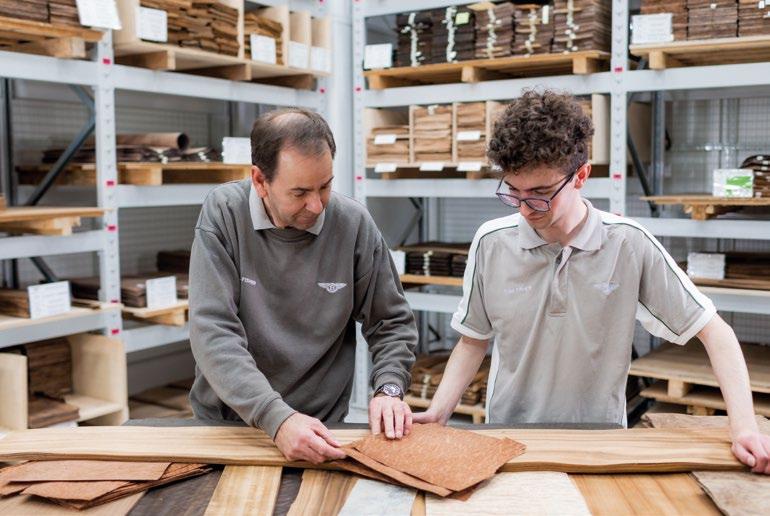
of Intellectual Property (IP) to prevent those who seek to sell counterfeit products, infringe on copyright, or distribute without authorisation from doing so. Technology within luxury is also an area which is seeing huge innovation, with digital capabilities such as biometric payments and the use of artificial intelligence (AI) in customer service becoming increasingly commonplace to cater to younger, tech-savvy consumers.
Despite British luxury having an eye on the future in terms of innovation and growth, what makes the sector so unique are its foundations rooted in rich history, and the skills involved in each and every practice, which have often been honed over many years. Furthermore, much importance is placed on ensuring these skills continue to be taught and passed down to newer generations to safeguard them. An example given in the report is that of Christys’ London, which operates one of the only hat-making factories in the UK – ‘manufacturing felt Fedoras, Trilbies and Panama hats, all using traditional methods’. If operations were to cease, these skills would be at risk of being lost altogether.
Striking the right balance between embracing modernity and retaining heritage can be challenging, but sustainability is a uniting force within UK luxury. The strategic focus of luxury brands tends to be on quality and enduring success, as opposed to shortterm profit, meaning that sustainability is often embedded into their businesses. Frequently, these brands will have strong connections to their local communities and environments, investing in
training to upskill their workforces to ‘accelerate the pace of change’, and actively seeking to demonstrate their commitment to sustainability by gaining recognised sustainability standards.
Walpole has identified areas in which they believe that changes to UK government policy would accelerate the growth of the luxury sector even further than predicted. These include reform of the Apprenticeship Levy, investment in the teaching of modern foreign languages to help aid communication with international visitors, and the introduction of a UK tax-free digital shopping scheme that would ‘enable a tourist boom that would drive employment and growth across the UK’. According to the report, these policy changes would not only be economically advantageous, but they would also protect Britain’s luxury crafts and the communities they serve.
When considering the many challenges faced by the sector since 2019, when the last Walpole report was released – from navigating the effects of the Covid lockdown to establishing new trading relationships with the EU following Brexit – the aforementioned £81bn 2022 turnover becomes even more significant. It is also testament to the incredible resilience of the sector and its workforce whose creativity and world-class craftmanship continue to drive the growth and continual success of these great British brands. As the study states: ‘people are the luxury industry’s greatest asset’.
You can read the full Walpole report here: www.thewalpole.co.uk/news/luxury-in-the-making
“While luxury is an undeniable driver of the UK economy, this would not be the case without the highly skilled workforces of luxury brands”
Enjoy some of the most iconic events across the UK, including sport, culture and family entertainment, throughout the year
The pinnacle event of the jump-racing calendar, Cheltenham Festival 2025 offers a unique twist on four extraordinary days. Whether you join on Champion Day on Tuesday, Style Wednesday, St. Patrick’s Day on Thursday or Gold Cup Day on Friday, excellence is guaranteed. thejockeyclub.co.uk/cheltenham-festival

Be part of sport’s greatest story, across three thrilling days of exhilarating action, toptier entertainment and social festivities at Liverpool’s legendary Aintree. Far more than just the world’s greatest steeplechase, The Randox Grand National Festival is horse racing with a difference. A national institution with a global audience, it is an event at which stories become legends and moments are etched into history. thejockeyclub.co.uk/the-grand-national
One of the world’s oldest and most famous amateur sporting events, with 195 years of rivalry and counting, The Boat Race on the Thames has become synonymous with British tradition. theboatrace.org
Equestrian heaven is to be found each spring in South Gloucestershire, as the world’s best riders and horses perform at their peak, cross-country and in the arena. Founded in 1949 by the 10th Duke of Beaufort, the Badminton Horse Trials is touted by Tatler as ‘the most glamorous sporting event of the season’. A horse-lover’s nirvana. badminton-horse.co.uk
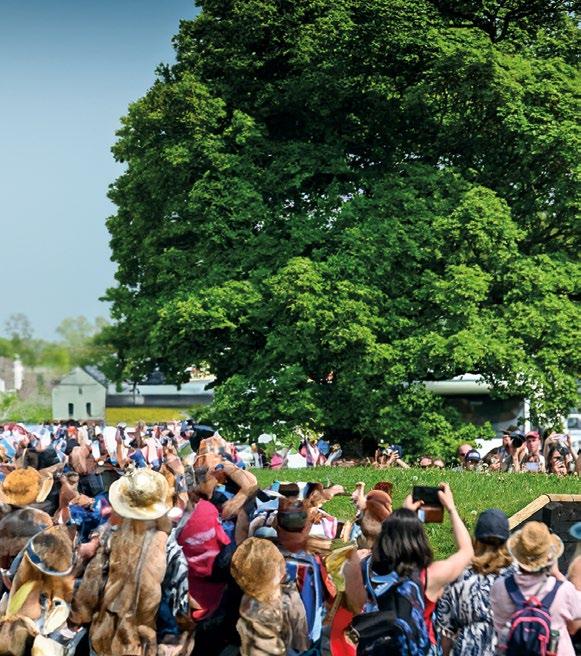
In the heart of the Sussex countryside, Glyndebourne is one of the most celebrated opera houses in the world, performing to 150,000 people across the summer Festival and autumn season. This year, celebrating its 90th anniversary, Glyndebourne will stage its first ever production of Wagner’s epic final opera, Parsifal – with a cast of nearly 200. glyndebourne.com




Filled with amazing garden designs, gorgeous floral displays and exclusive shopping at the Royal Hospital Chelsea, the show represents the pinnacle of horticultural excellence, with something for everyone. rhs.org.uk
A key highlight of the British sporting summer – and one of the UK’s longest running sporting events – Cowes Week has been held in the Isle of Wight almost every August since 1826, evolving across the years. Now between 800 and 1,000 boats race, with Olympic and world-class yachtsmen mixing with weekend sailors, in a mix of boat designs. Perfectly unique! cowesweek.co.uk
In true British tradition, enjoy your strawberries and cream while watching the world’s oldest tennis tournament (the only grand slam to be played on grass). Elite sport, sublime society; the absolute pinnacle. wimbledon.com


Thrill seekers and racegoers will come together once again to escape the ordinary and indulge in a week of celebration and sumptuous flat racing at the UK’s pinnacle horse-racing meeting. ascot.com/royal-ascot
Over 300 races of international standard on the River Thames attract thousands of visitors over a week in mid summer. Whether you are a first-timer or a seasoned member, the world’s foremost regatta offers a wonderful day out. With plenty of racing action, great food and drink, and an electric atmosphere, this is a highlight of both the summer sporting calendar and the social season. hrr.co.uk

Held annually at Ragley Hall in Warwickshire, The Game Fair is the gathering for people passionate about rural pursuits. Abuzz with everything from shooting to shopping, fly fishing to falconry, working dogs to wild food. thegamefair.org
Founded in 1947, the Edinburgh International Festival is an unparalleled celebration of the performing arts and an annual meeting point for people of all nations. Committed to virtuosity and originality, it presents some of the finest performers and ensembles from the worlds of dance, opera, comedy and theatre. eif.co.uk

27-30 AUGUST
Birthplace of Sir Winston Churchill, Blenheim Palace in Oxfordshire is unmatched in its grandeur – providing the perfect backdrop for a curated collection of classic and supercars, paired with exquisite hospitality and an eclectic boutique of luxury brands. salonpriveconcours.com
Our star chef leads a glorious road rally from his Kitchen at Chewton Glen to his Grill at The Lygon Arms. By Tom Howard
As the morning sun bathed the pristine croquet lawn at Chewton Glen in a warm, golden blanket, a scene from the previous evening remained in situ. One that would make any car enthusiast’s heart race. Forty hand-selected cars, each one unique, peppered the lawn in prep for the day ahead. Among them, a grigio Ferrari 275GTB and Bentley Continental La Sarthe – cars that, much like their owner, exude an effortless combination of style and charisma. That owner, of course, is James Martin – a name synonymous not only with culinary excellence but also with a deep-seated passion for all things automotive. He is the
driving force behind the self-titled rally, which will take us from the tranquil elegance of Chewton Glen to the historic charm of The Lygon Arms in Broadway –two of James’ Iconic Luxury Hotels restaurant locations.
Standing on the Croquet Lawn at Chewton Glen enjoying the atmosphere, I asked James about the inspiration behind this unique blend of cars and cuisine – and, more personally, what first sparked his passion for cars.
“I first got into cars as a young kid, flipping through the pages of Exchange and Mart and peering through car showroom windows. But the moment my love of cars truly took off was during a family
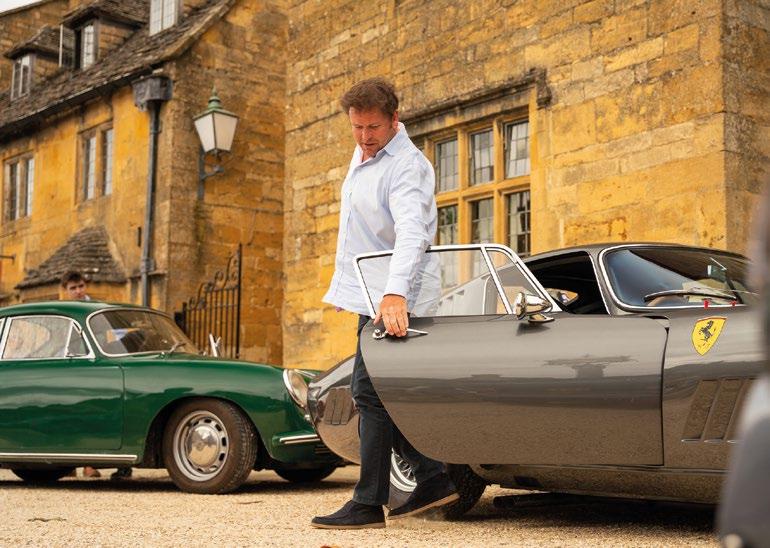
holiday when I was about five years old. We were walking along the Scarborough seafront – one hand holding my gran’s, the other tightly holding a dripping ‘99’ ice cream cone. That’s when I saw it: a stunning soft-top old Aston V8 parked right outside one of the arcades. I was so mesmerised that I slipped from my gran’s grasp and headed for the car. Before I knew it, my head was over the door, ice cream now dripping on to the car’s cream seats! By the time the owner noticed, it was too late for my mother and gran to pull me away, and the apologies began. But the man just smiled, took the melting ice cream from my hand and
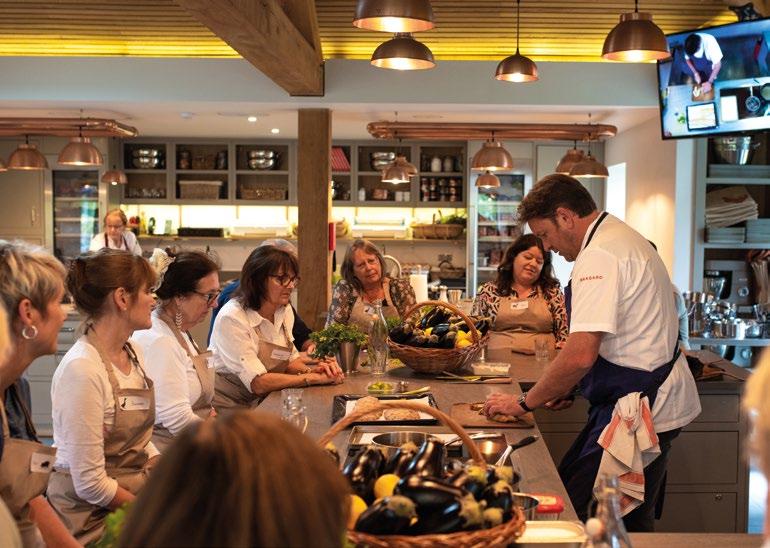
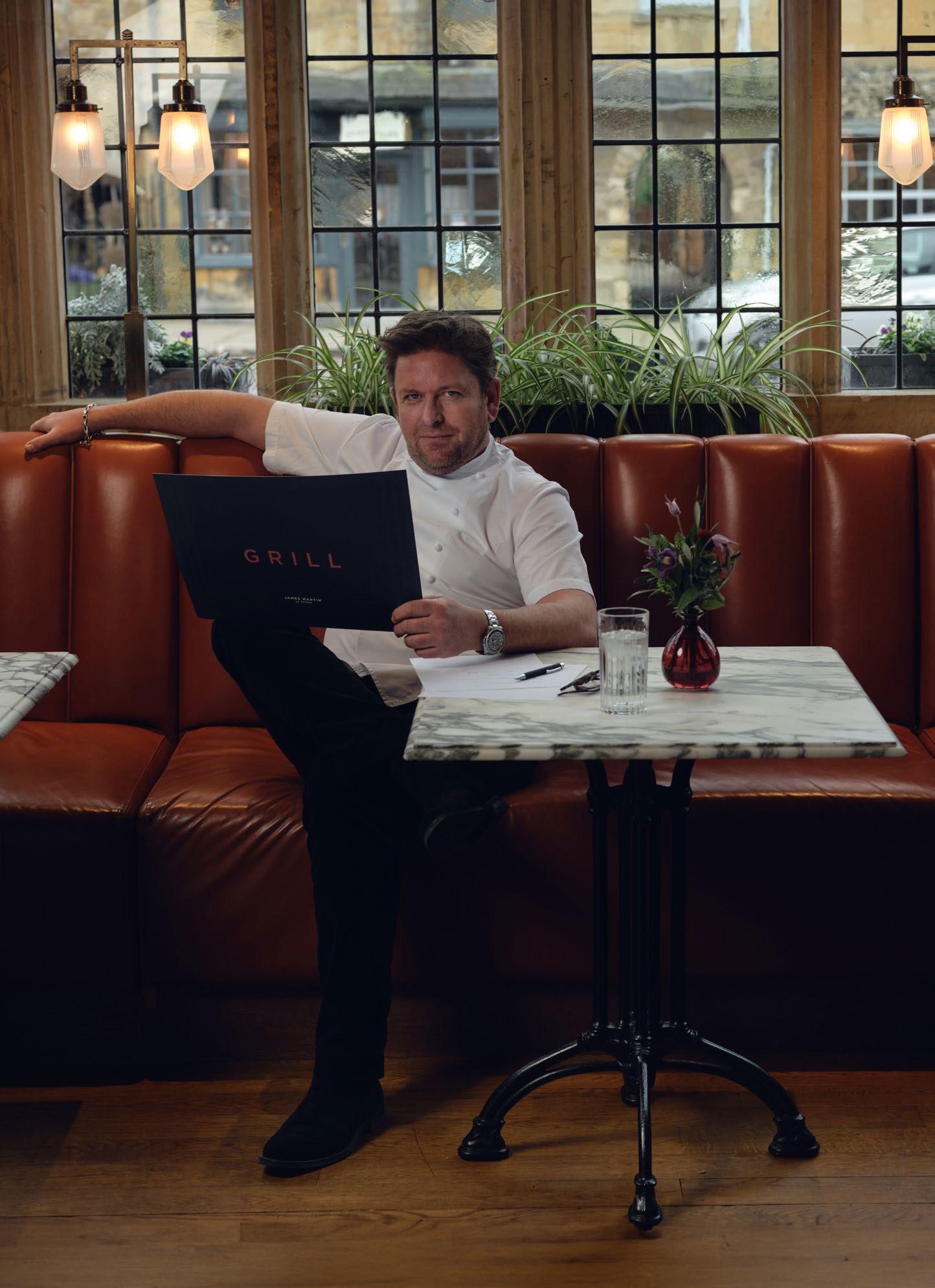
invited me to sit in the car. It was only a minute, but it felt like 30. I must have touched every button with my sticky little fingers but that really was the moment when my passion for cars began.”
Working alongside James to help organise the car rally, I remember setting up early in the morning, James was in his element, between adjusting the placement of the cars and checking on the food preparations. He had this infectious energy, bouncing between conversations about engine specs and menus with the same enthusiasm. It was clear that for him, whether it was a perfectly restored classic car or a beautifully crafted dish, the dedication and passion were one and the same. Watching him move seamlessly between these two worlds showed me how naturally his love for both cars and cooking intertwined.
“Cars and cooking – they’re both about passion,” James explained.
“Both require precision, creativity, and a love for what you do. Whether I’m in the kitchen or behind the wheel, it’s all about the experience. I wanted to bring together people who share that same passion, and what better way than with a rally that ends in a great meal?” James’ relationship with Iconic Luxury Hotels is one of mutual admiration and a shared commitment to excellence. His restaurants at both locations are testaments to this, offering menus that celebrate the best of British produce, all prepared with the flair and attention to detail that have become James’ trademarks. “Chewton Glen is like a second home to me,” James said, glancing around the hotel grounds. “When I’m not on the road, in the studio, or cooking at an event, I’m here in the kitchen or out with the guests. The connection between the land and what we serve on the plate is so important. It’s the same with
The Lygon Arms. There’s history there, a sense of place, and I wanted the restaurant to reflect that – simple, honest food that speaks for itself.
“The Cookery School at Chewton Glen is something I’m incredibly passionate about. It’s not just a place to teach people how to cook; it’s about inspiring a love for food and making cooking accessible to everyone. The school is designed to be hands-on and interactive, where people can learn techniques that they can take home and use every day. I’m constantly thinking about how we can expand and innovate, bringing in new courses, and perhaps even tying in some of the themes from events like the rally. The rally is all about celebrating what I love – cars and food – so I can see a lot of crossovers, maybe even some special events at the school inspired by the rally itself. It’s all about creating experiences that people will remember.”
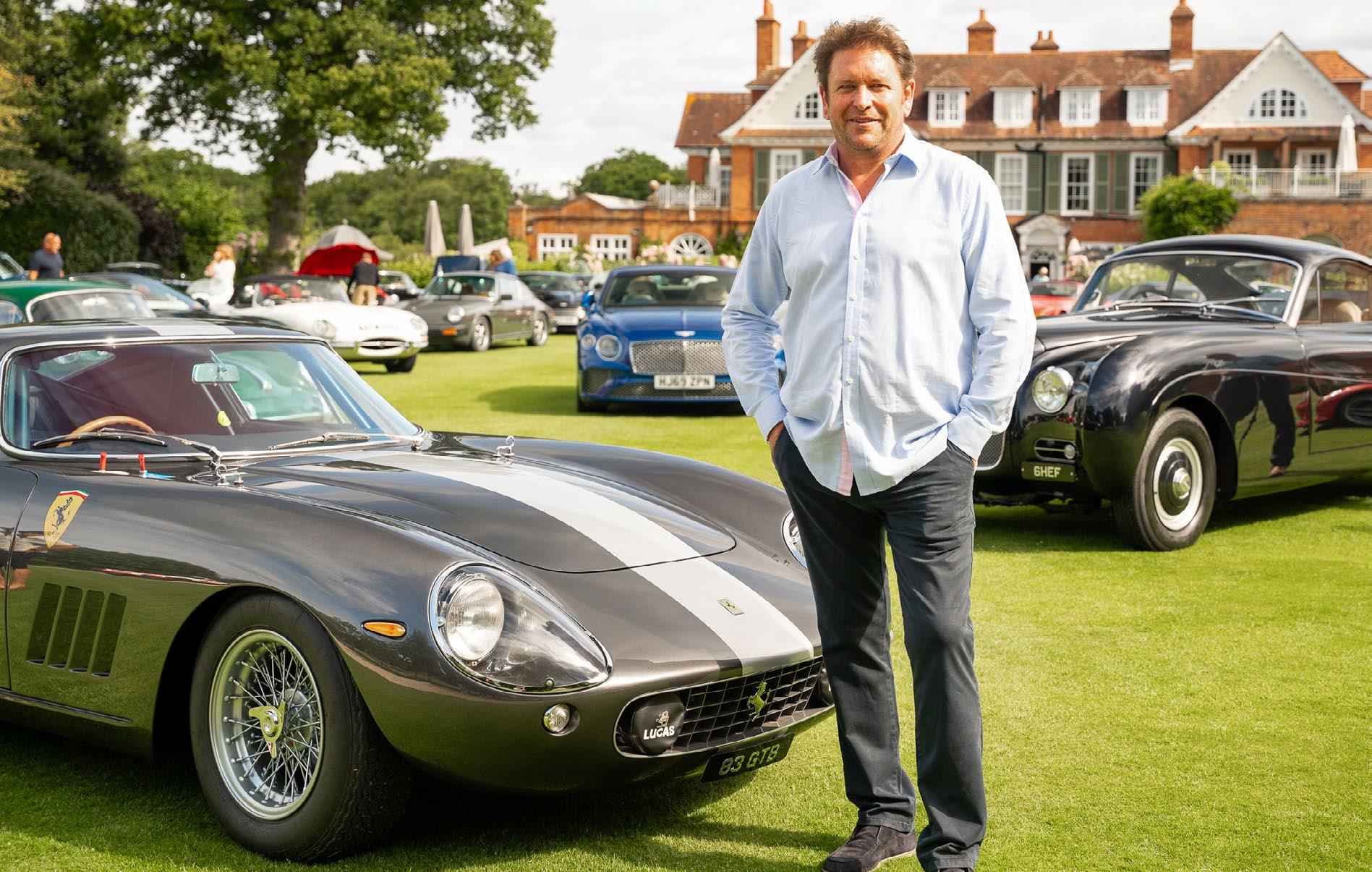


“Cars and cooking – they’re both about passion. Both require precision, creativity, and a love for what you do. I wanted to bring together people who share that same passion, and what better way than with a rally that ends in a great meal?”
There is a certain magic that comes with being part of a rally like this – forty cars, each with their own story, driven by people who share a common love for the road and what lies beyond it. We even had a group from Portugal at the event. For James, it is as much about the journey as the destination. “Both locations are stunning, especially in weather like this,” he said, gesturing to the clear blue sky above. “There’s nothing like the feeling of driving these roads with your mates, the sun shining and bringing these out to play. And when you’ve got a group of people who are just as enthusiastic as you are, it makes the experience even better.”
The route James had chosen for the rally guided us out of Hampshire and into the heart of the Cotswolds. We wound our way through rolling hills, charming villages and along roads that seemed crafted for the sheer joy of driving. The picturesque landscape provided the perfect backdrop for our culinary road
trip. Reflecting on the first leg of the rally, James shared his connection with the hotels: “Working with Iconic Luxury Hotels is a natural fit for me. They share my passion for creating memorable experiences, whether it’s through exceptional food or stunning locations like Chewton Glen and The Lygon Arms. It’s about making every moment special.”
It certainly did not hurt that the route between these two locations features some of the most incredible driving roads around, and we had selected a perfect blend to suit the diverse range of vehicles in our rally.
James’ restaurant at The Lygon Arms is every bit as impressive as you’d expect – rustic yet refined, sitting in the heart of Broadway’s quintessentially British thoroughfare, with a menu that showcases the best of the local area. That evening, we were treated to a feast that reflected James’ philosophy of cooking: simple, honest and delicious.
As we sat around the table, the conversation turned to the future. The success of this rally had left everyone eager for more, and plans for the next event were already being discussed. “We’ve only just begun,” he said with a smile. “There’s so much more we can do – more routes to explore, more food to enjoy and more memories to make. This rally was just the start, and I can’t wait to see where we go next.”
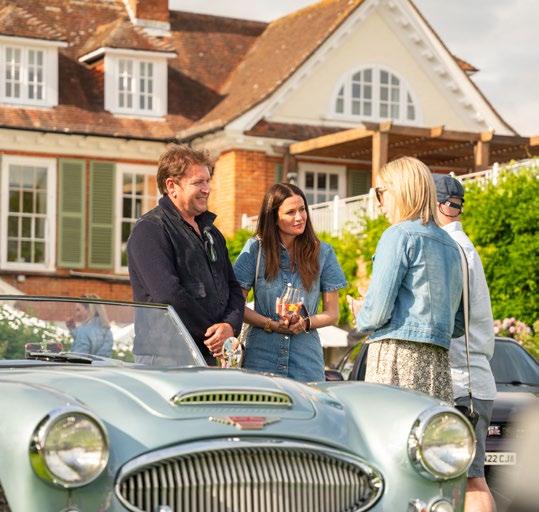









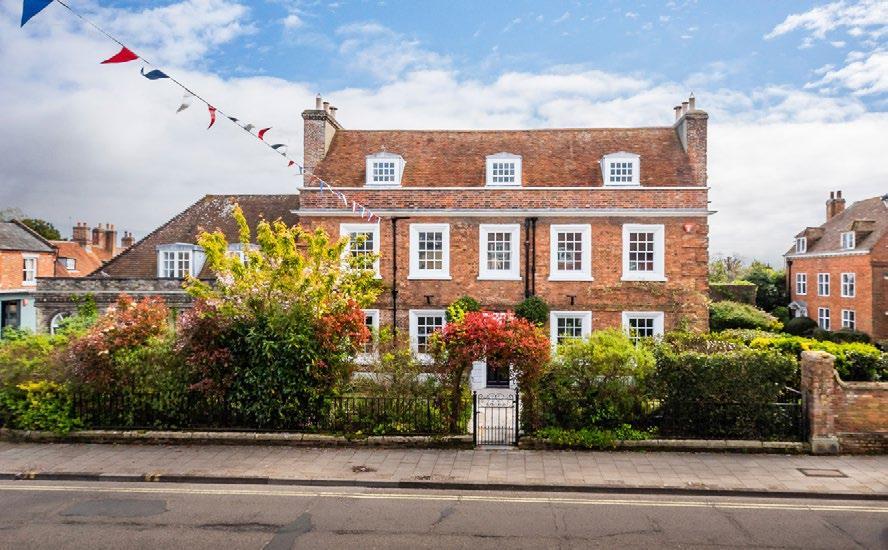






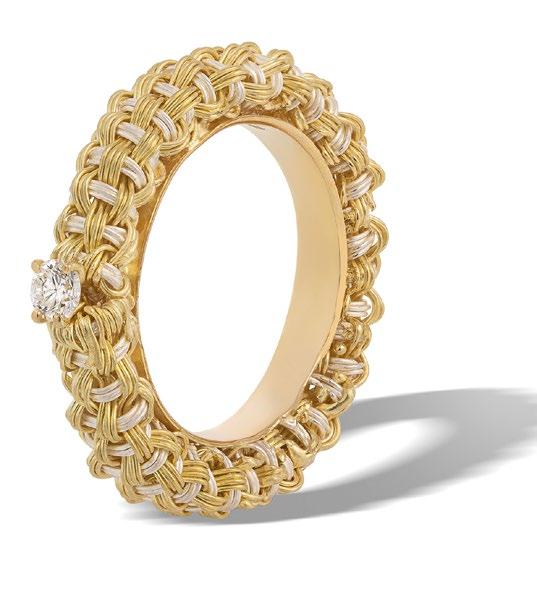
There is nothing more precious than a piece of jewellery hand-crafted using centuries-old art forms.
Rachael Taylor explores the dying arts that are living again
It was the details that endeared Natasha Wightman to the two large ravens that took up residence on her land in Sussex. They mimicked sounds, stole “anything left unguarded”, hid food, played dead and pulled the tails of her dogs. Each act exposed

their complex, joyful characters. So, when Wightman decided to capture their likeness in a jewel to celebrate her special relationship with them (the pair would often fly wing-to-shoulder with her as she went for walks), it was important to get the details right.
While Natasha is creative – she is a performance artist, and an actress whose film credits include Gosford Park and V for Vendetta – she is not a jeweller. She had a vision of creating carvings of ravens in flight using natural British materials such as Whitby jet, bog oak, hawthorn, found antler and boxwood, but needed a craftsperson to execute it, and found that what she was seeking was a disappearing art form.
“The ravens left a deep impression on me, and I was looking for a craftsman that could [capture them] anatomically correctly,” says Wightman. She started her search via The Master Carvers Association, and discovered the register holds less than 40 names for the whole of the UK. From this list, she chose Graham Heeley, serendipitously

a fellow Sussexian, who Wightman believes is “one of the only craftsmen in Britain that can carve to such microscopic detail in the size that I required”. What started out as a commemorative piece for herself soon expanded to creating ravens for friends. Now, Wightman’s bird jewels are sold at artsy fashion boutique Dover Street Market in New York and Los Angeles under her brand name NVW Jewelry. Over the seven years that Wightman and Heeley have been collaborating, the duo has found a comfortable rhythm. They trade sketches, then Heeley carves a dummy design in wax. He refines it before he starts to carve the chosen material using an array of tools. “Anything I can get my hands on,” he laughs, including some he has made himself.
Wightman, meanwhile, works with goldsmiths to design the rest of the jewel, or plan where they might inlay diamonds in the ravens. The process can take up to seven weeks. The result is a darkly dramatic wearable artwork. “We have the skills of craftsmanship at the centre [of the design] rather than the focus being a diamond,” says Wightman. “We’ve switched it.”
This is an idea that is growing in popularity within jewellery. In a world where machines can produce endless perfect repetitions, and AI tools can dream up any number of fantastical designs instantly with just a few prompts, those who appreciate quality and craft are instead seeking out hand skills. At a recent Mayfair showcase of the work of jewellers selected by the Sarabande Foundation, set up by the late fashion designer Lee Alexander McQueen to “support creative and visionary talent”, this elevation of ancient crafts was prevalent. Castro Smith humorously displayed his handengraved jewels – his signature signet rings have elaborate tattoo-like designs picked out by boldly colourful ceramic platings – within a trench coat splayed on a windowsill. Coline Assade showcased palm-sized parrots she had carved in wax as a visual explanation of how she arrives at her menagerie of enamel-slicked gold animal jewels, including snake hoop earrings and frogs that cling to fingers. Martina Kocianova showed hand-carved gemstones, including fluorite and amethyst, which she shapes into mushroom caps and adorns with
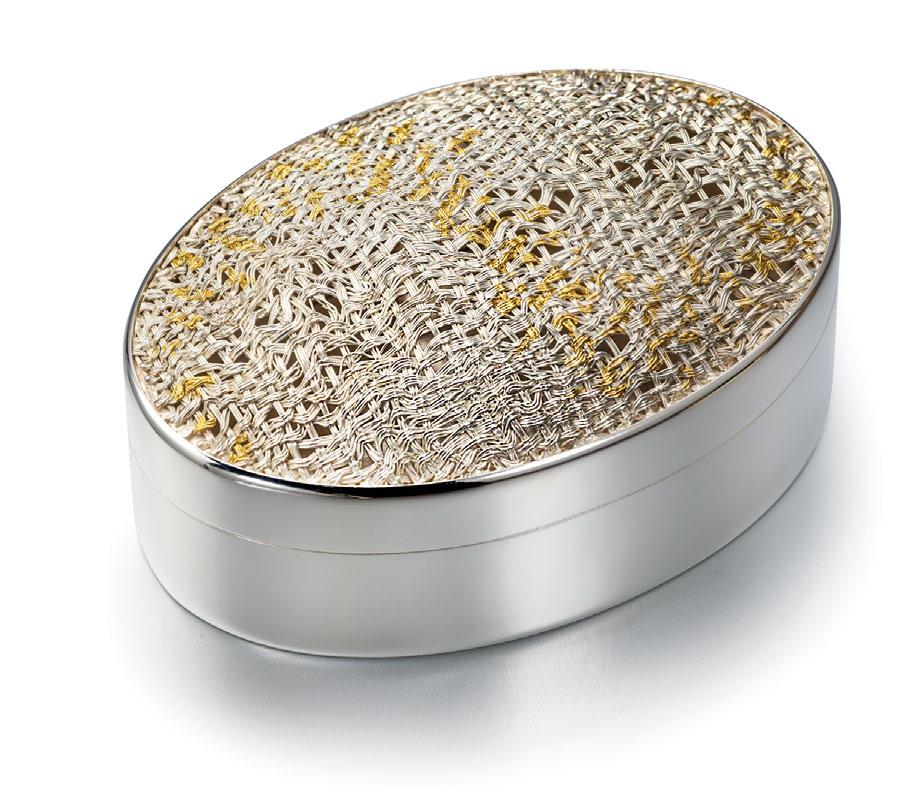
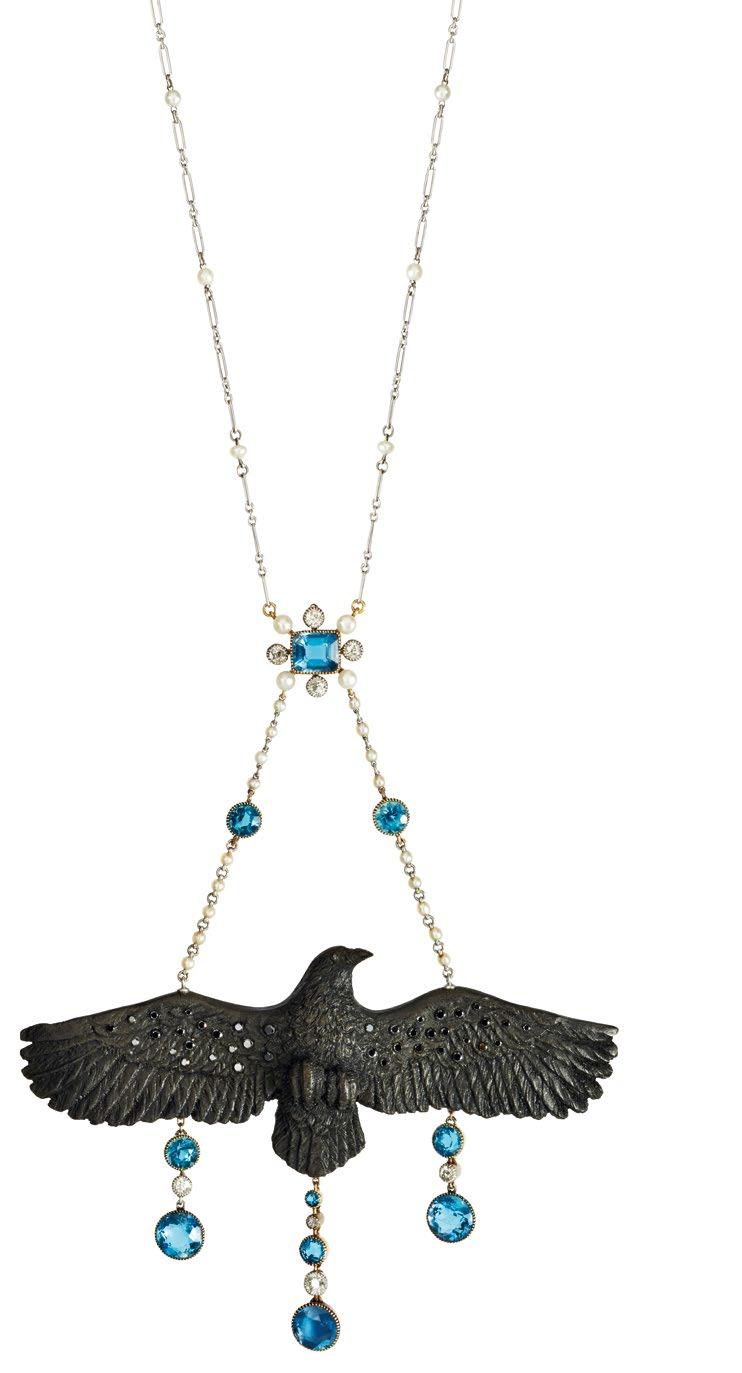
“In a world where machines can produce endless perfect repetitions, those who appreciate quality and craft are seeking out hand skills”
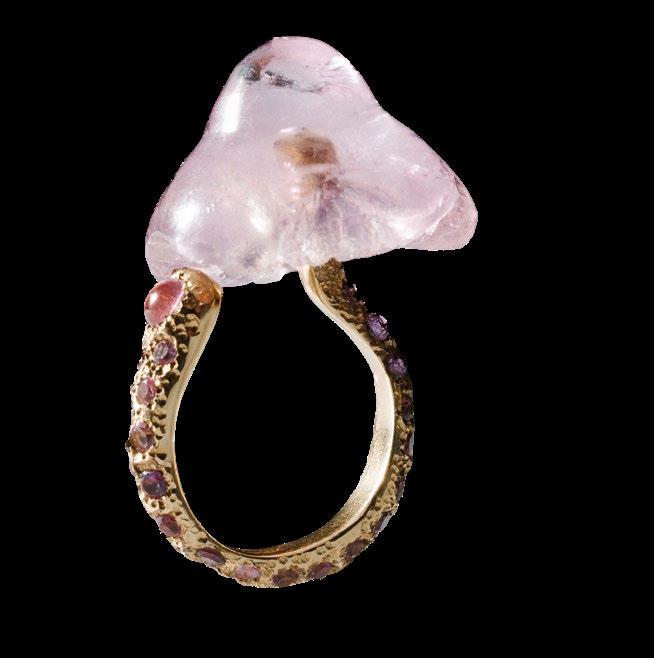

gems and gold. Gem carving in particular is becoming popular once again, with the intaglios and cameos that were the height of fashion in Ancient Rome discovering a new audience.
Ben Steele is a second-generation jeweller in Birmingham and now a self-taught intaglio maker, after a hobby to pass the time in lockdown evolved into his spin-off business Steeles Intaglios. He creates tiny artworks inspired by folklore, myths and animals by carving into the reverse of transparent gemstones such as rock crystal.
Steele also offers portraits carved into gems, which are particularly challenging. “The first one I ever had to do was for a young man whose dad had just passed away,” he says. “There’s a huge emotional attachment [with the portraits] and we have to do them justice. If you get the nose wrong, you throw the whole person’s likeness out the window.”
“Gem carving is becoming popular again, with the intaglios and cameos that were the height of fashion in Ancient Rome discovering a new audience”
It is important to Steele to risk the imperfections that might come with handcrafting his artworks rather than use modern technology, such as laser engraving tools. He likens it to investing in original artworks: “You can print something off the printer, and you’ve got some famous artist’s painting. Or, if you were offered it for the same amount of money, would you prefer to have the artist’s painting? There’s a human draw to art, and things being hand done. A lot of jewellers are moving away from computeraided design software to handcrafted rings because, even though they have their little imperfections, they’re human imperfections, and that’s the creative part of being human.”
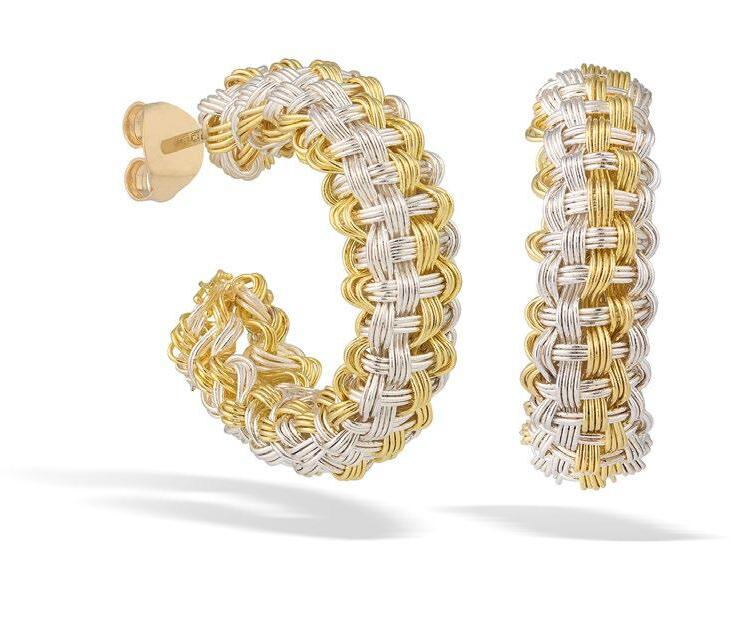
For jeweller Lucie Gledhill, it was a study of repetitive making practices during her master’s degree at the Royal College of Art that first drew her to chain making. Today, chains are mostly made by machine due to their ubiquitous presence in jewellery. To find one crafted by hand is rare, and there are only a handful of makers specialising in this in Britain. Jeweller Pragnell specialises in handmade English chain, working with a single
artisan who has dedicated her career to the craft. Together they have produced a rounded, plait-style chain.
Gledhill produces imaginative contemporary designs that celebrate the union of gold and silver links in myriad forms. She brings her own twist to classic styles such as Spiga and curb-link chains, and invents brand new
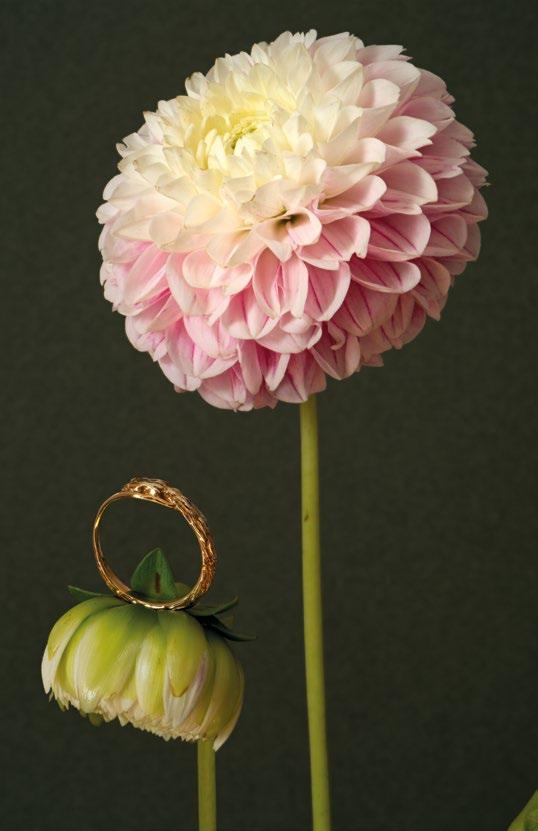

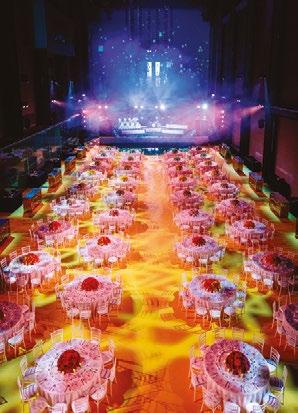
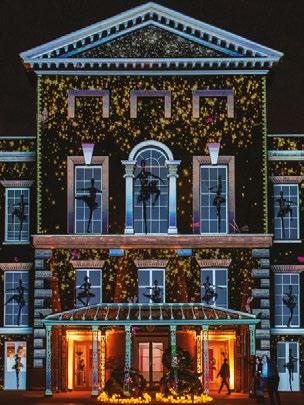




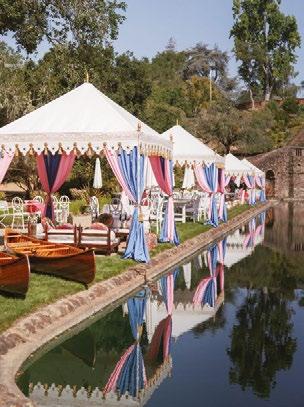


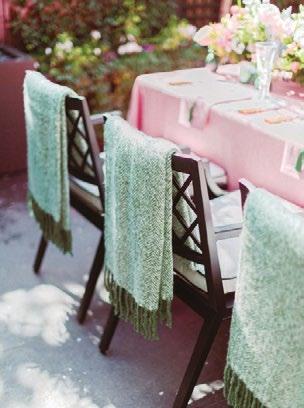

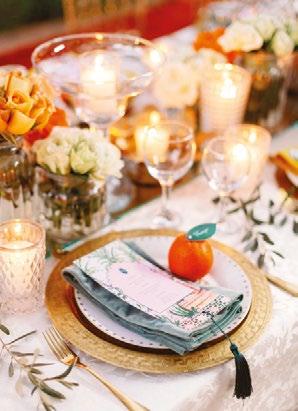


At Bruce Russell Events, luxury entertaining and celebrations are elevated to an art form. From his London headquarters to offices in the Hamptons and San Francisco—and throughout the world’s most coveted destinations—Bruce Russell curates unforgettable experiences where no request is too grand and no detail too small.
“Chains are mostly made by machine due to their ubiquitous presence in jewellery. To find one crafted by hand is rare and there are only a handful of makers specialising in this in Britain”
concoctions of links. A signature of hers is to graduate the links, which she says is almost always a hallmark of a handmade chain: “You can have incredible decorative, beautiful machinemade chains that run perfectly and they’re gorgeous, but considered graduation in terms of scale of the links is really iconic for handmade chain.”
Before she gets started firing and shaping the precious metal by hand, she uses a technique called wire drawing that dates back to 4600 BC, with rods of precious metal cranked by hand through small holes to thin it into wires.
“It’s quite poetic, the idea of pulling a wire or drawing a wire,” notes Gledhill.
Another jeweller using wire drawing to create jewels is Megan Brown. She creates incredibly thin strands of gold and silver that she then weaves together to
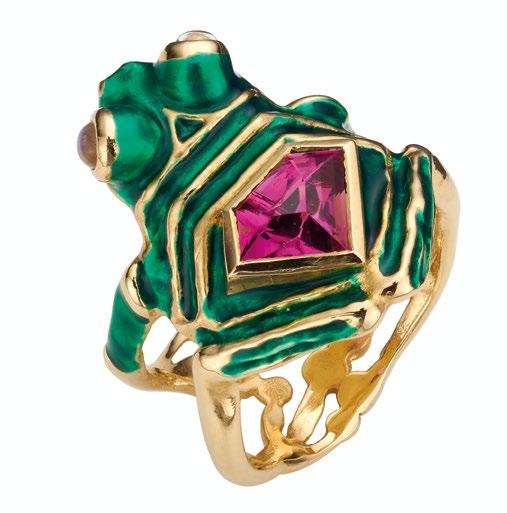
create fabric-like patterns inspired by her family’s textile business that has operated for more than a century in North Yorkshire. She drapes soft metal mesh as bracelets and drop earrings, or weaves firmer structures for rings and brooches. Alongside her own practice, Gledhill teaches others how to make chain by hand; she believes passing on her skills is a responsibility. Her classes, held three times a year in The Goldsmiths’ Centre in London, fill up instantly, and she travelled to New York Jewelry Week [in November] with a collective of jewellery and metal educators she has assembled under the moniker Fold(s) Community to spread their knowledge of ancient jewellery crafts ever further, and help serve the growing desire for genuine, handmade jewellery with a human touch.

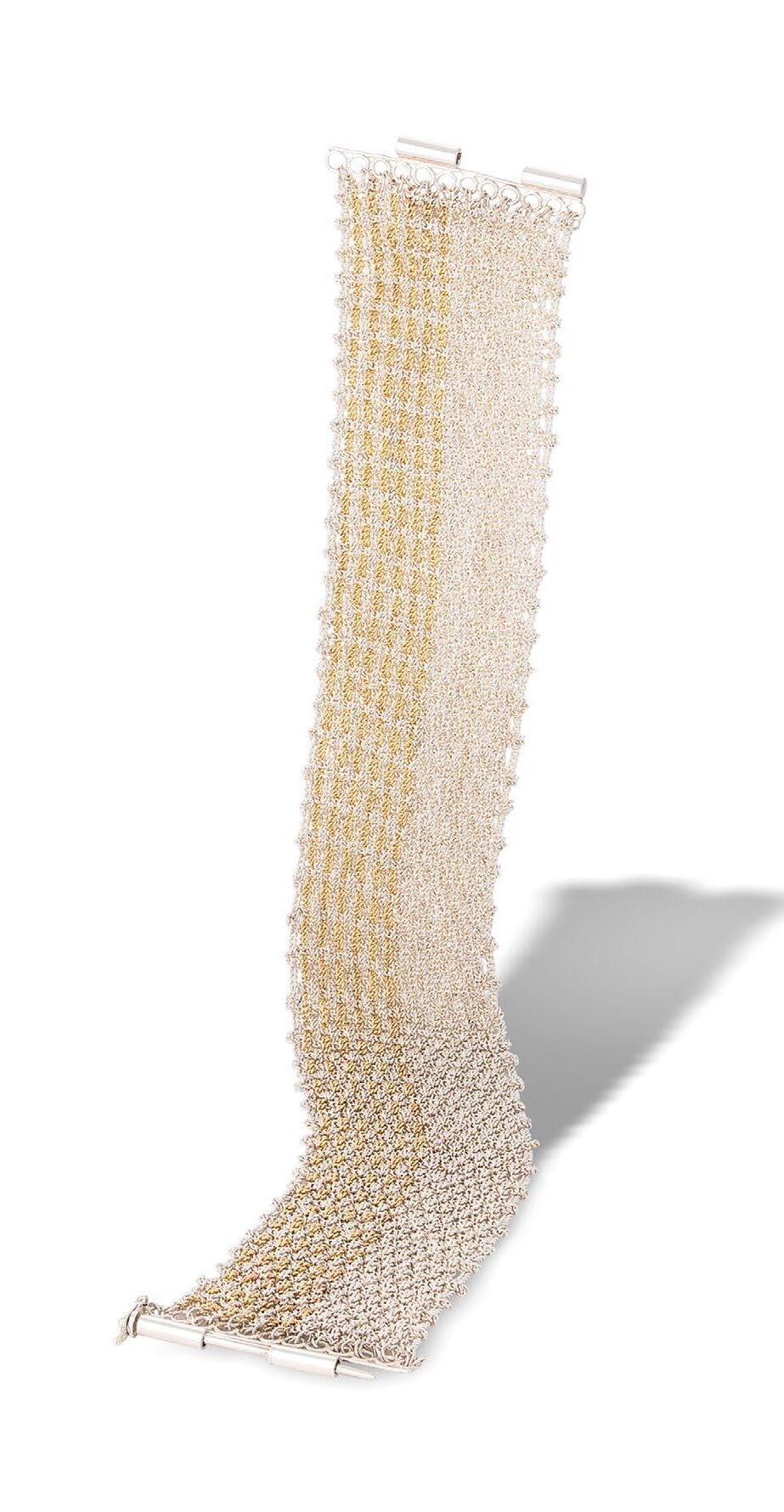


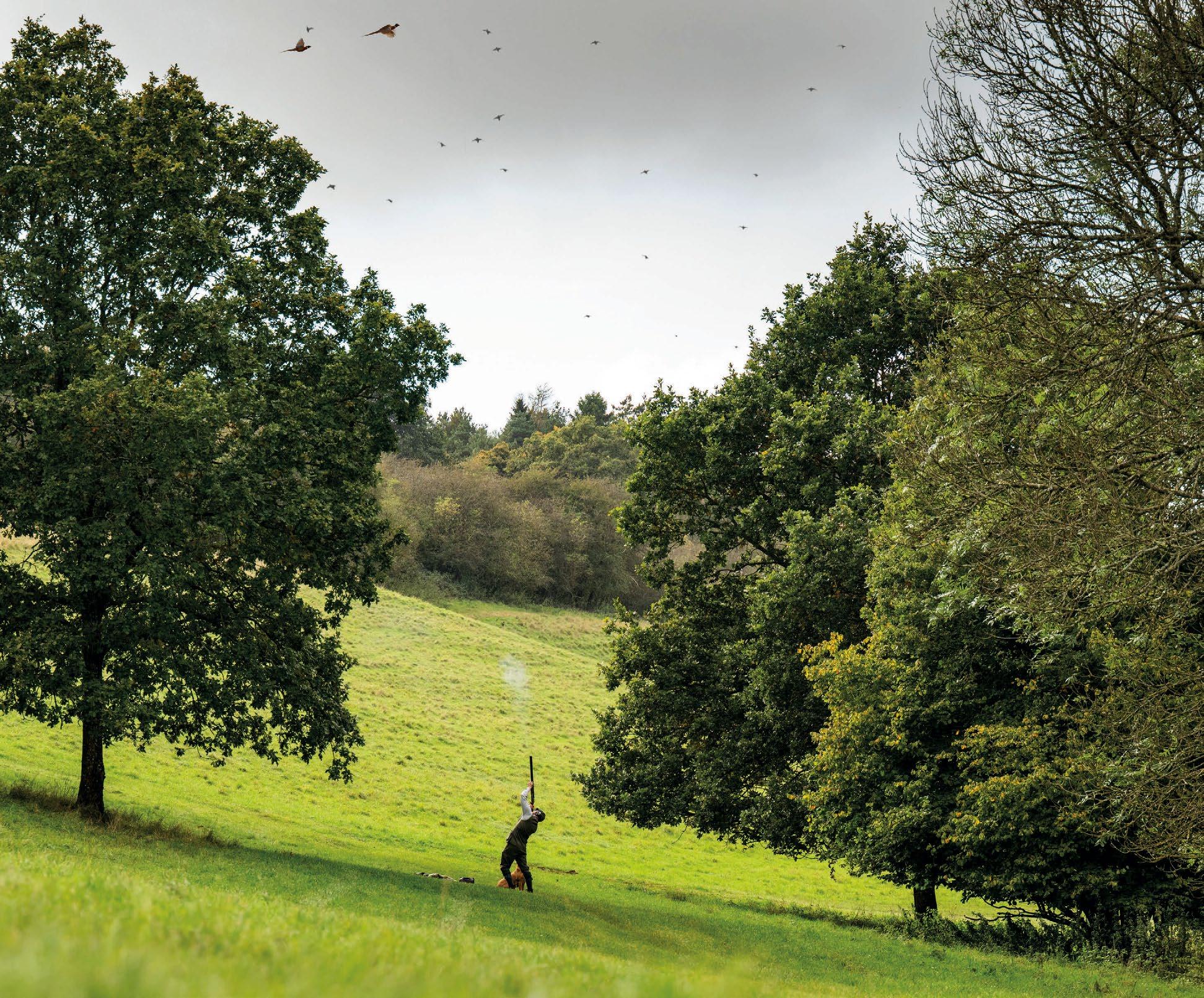
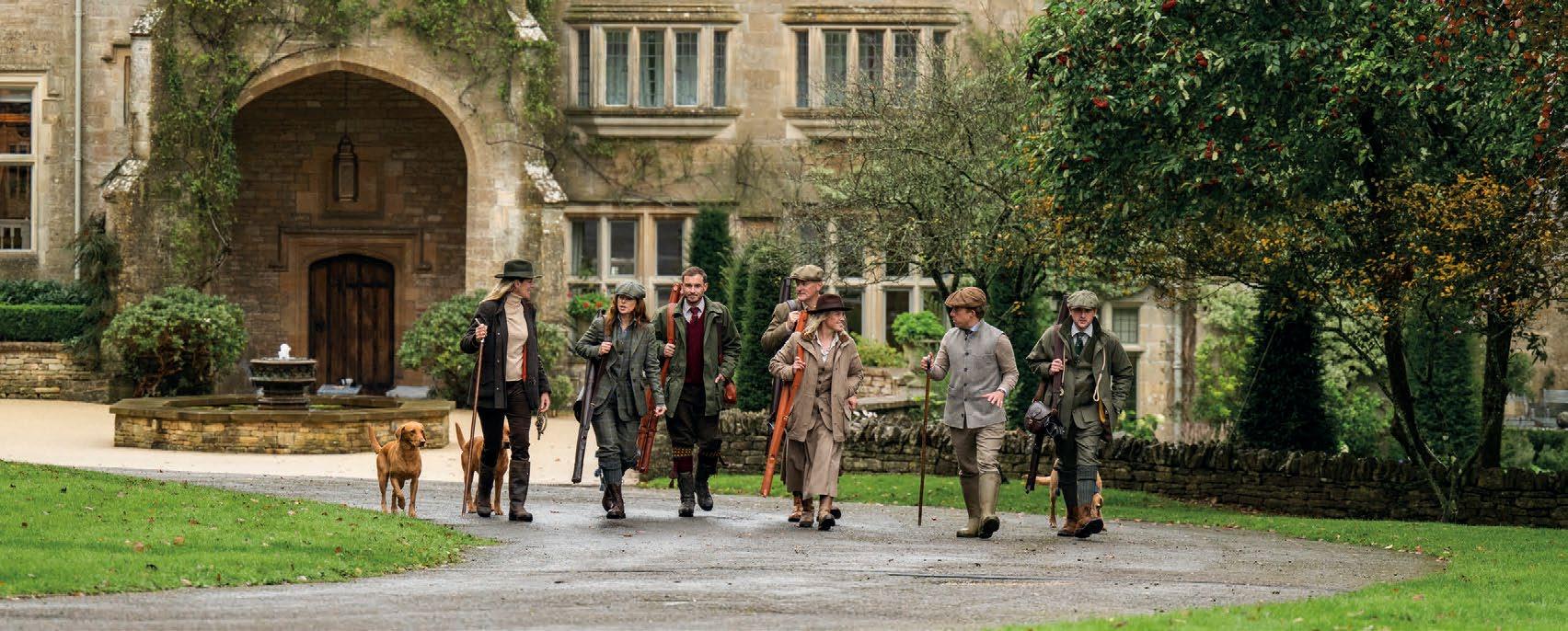
They are highly skilled, dedicated and unpaid. But being the chair of one of Britain’s iconic sports events is a privilege many crave and few achieve. Lucy Higginson meets two fine examples
The English social season once defined the summer for the upper echelons of British society, as nobility, landed gentry and members of Parliament descended on London for a circuit of balls, galas and grand gatherings. But like society itself, ‘the season’ has evolved, and today it is largely understood as a calendar of the finest and longest standing sporting and cultural events in London and beyond, open to all.
The names roll off the tongue like champagne and strawberries: Royal Ascot, Henley, Cheltenham, Badminton, Wimbledon, the Derby… too many to name. Among them all, two of the most iconic are the Henley Royal Regatta and The Championships at Wimbledon.
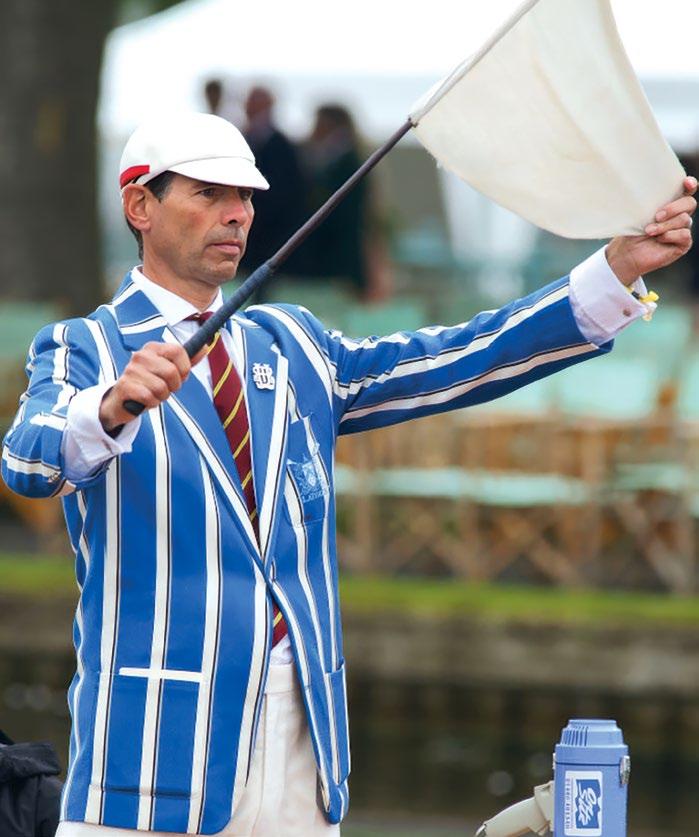
These events are invested with much more than just sporting endeavour and social magnetism – they stand for something intangible yet quintessential about Britain’s profile in the world. To be custodian of events such as these is both a privilege and a responsibility. Here we meet two leading keepers of the flame, Henley Royal Regatta chairman Richard Phelps, and Debbie Jevans CBE, chair of the All England Lawn Tennis Club at Wimbledon. It is their job not only to preserve and uphold the dignity and tradition of these two great events, but also to lead them into a new era, modernising sympathetically to ensure the enduring legend with which they have been entrusted.

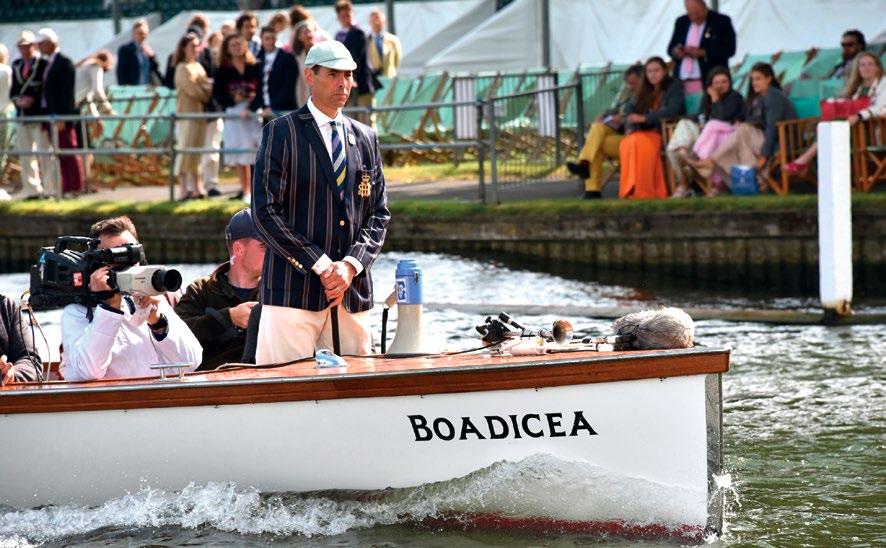
Four smart boatmen — slightly uneasy in ties and braces — gaze at the camera. Behind them are the Henley boat tents, looking, in the 1930s, much as they do today.
Descended from generations of ferrymen and wherryman, the four men are brothers, one of them the grandfather of Richard Phelps, who succeeded Olympic rowing legend Sir Steve Redgrave as Chairman of Henley Royal Regatta (HRR) last summer.
It’s a unique, challenging and unpaid role for which Richard — as a businessman, former Olympic oarsman and rowing umpire — is ideally qualified. “As working men, my grandfather and his brothers weren’t allowed into the Stewards’ Enclosure — and now I’m chair. It’s a dream come true,” he says.
Henley — which was first held in 1839, and is a staple of the social season — has no chief executive, as it is not run as a business. Profit is not the focus. Its board is mostly rowing grandees, who strive “to pass the Regatta on to the next generation in a state better than we find it.”
Held early in July, Henley is both an elite regatta and luxury garden party. While the world’s best crews do battle on the river, the banks teem with rowers and rowing fans consuming Pimm’s, seafood, iced coffees and more in a glorious pop-up village.
Henley is a bundle of contradictions, not least its format. Involving one-on-one racing, on a stream, over a 2,100m long course, it is quite unlike other international events.
Yet the world’s top rowers all long to come here. “Yes, we’re a misfit with international rowing — the point is we’re not trendy, we’re Henley,” says Phelps.
Embracing tradition is as much a part of the job as gradual evolution. “Success for me is when someone walks into the Stewards’ Enclosure for the first time in 20 years and says ‘Gosh, nothing’s changed!’ While in
fact, so much has.” While the grandstands, layout, trophy tent, 1920s-style commentary, antiquated ‘progress boards’ and much else is lovingly retained, the event has moved with the times — and not just the legendarily stuffy requirement for ladies’ dresses to cover the knee in Stewards (trouser suits are permitted now too).
Consider the brilliant drone filming and free live streaming of the Regatta — “Henley’s greatest gift to rowing” — and the addition of a sixth day to the programme in 2022 to accommodate more women’s races. A strategic review is underway to determine what comes next, but more gender parity, and new membership categories are on the agenda.
Many Henley regulars first attend this event as competitors — 4,000 a year take part — later choosing to become one of the 7,500 Members. Ranging from “hedge fund millionaires to retired rowing coaches”, it is their fees which underpin the event. The Stewards’ Enclosure remains the preserve of Members (new ones must be nominated by an existing one, and expect to wait five years) and guests. Though a day at Henley is less expensive than a day at Royal Ascot, for example. “We are very aware of the financial strains at the start of people’s careers, and for that retired rowing coach,” says Phelps.
Though HRR now has a handful of hand-picked brand partners, no race or central part of the infrastructure is sponsored. “As at Wimbledon,” says Phelps, “sponsors don’t get naming rights or centre court visibility. Its value is higher because it’s sacred territory.” Nor does prize money motivate Henley competitors through arduous year-round training — there is none.
But Phelps also points out that the Regatta does not own most of the land alongside the course, and anyone may roll up with a picnic to watch world-class rowing. “That makes us very special.”

“We’re
a misfit with international rowing — the point is we’re not trendy, we’re Henley”
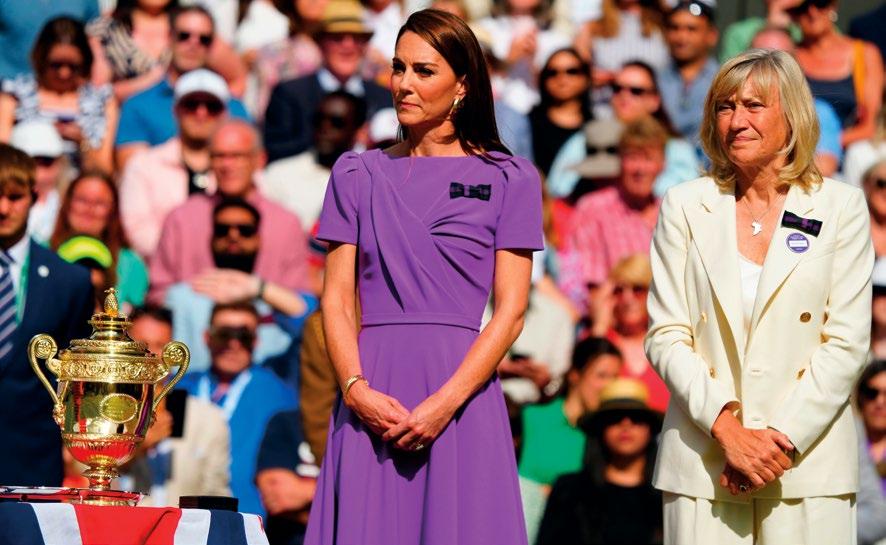
Does any board boast a better qualified leader than Debbie Jevans CBE, Chair at Wimbledon since 2023, and the first woman to fill the role? As a former top player, the Director of Sport for the London Olympics and former CE of England Rugby 2015, her sports leadership experience is phenomenal. “I first played here as a schoolgirl — to sit here now, 50 years later, as chair, is quite emotional. This place is part of my DNA,” she says. She still enjoys a lunchtime game when she’s working at the Club.
Though (as at Henley) Wimbledon is primarily a club (with just 500 members), which happens to run the world’s most celebrated tennis tournament, in other regards the two events could not be more different. For one thing, Wimbledon’s 2024 prize fund was £50 million, with global TV rights central to its finances. Its daily management is down to Chief Executive Sally Bolton, to whom the board — led by Jevans — give direction and support.
Like Henley, Wimbledon is proud of its uniqueness: “We always go back to core values and what makes Wimbledon Wimbledon,” Jevans says. “We are proud to be a national treasure. We are aspirational but welcoming. We play on grass; we play in all white; we are fortunate to have excellent partners but limited commercialisation around the grounds, and I’m sure we spend more money on flowers than any other event… our tag line is tradition with innovation.”
Recent changes include 2024’s ‘Queue Village’ with big screens, refreshments and entertainment for those who take up Wimbledon’s idiosyncratic invitation to wait in line for on-the-day tickets. Digital line calls are also new — “but we won’t have big LED screens with commercial activation while they are decided as other events do,” stresses Jevans. “Our focus is on the field of play.”
Other treasured traditions — besides flowers — include the roving honorary stewards who direct visitors. “The human aspect of what we do, and that attention to detail, is really important.”
Probably the most glamorous part of Jevans’ role is being the face of the championships and hosting Wimbledon’s tennis-mad patron, the Princess of Wales, plus celebrities in the Royal Box. Their stardust is a reason Wimbledon’s visitor and engagement numbers have ballooned at a time when other premium events have struggled. Royal Box invitations are ‘the gift of the board’. “Celebrities do bring media coverage… but aligned to that we invite those who have done a lot in the community, charities and the wider tennis family, including former champions.”
Visiting other leading sports events is de rigueur for any Chair: “I look and learn,” Jevans explains. “What do debenture holders receive? What innovations are there? What are they doing for children, and for players?”
Encouraging the young is important: “We know there are many options for young people but we are mindful of youth and diversity in the way we recruit interns and ballboys, for example. What stands us in good stead are the Emma Raducanus and Jack Drapers and others coming through, and of course British success is important. The sport’s success is paramount for us.”
Jevans’ biggest legacy is likely to be a project to build 38 new courts, a show court and new public park on a neighbouring golf course, which would finally allow Wimbledon to host its own qualifying matches, “and open up The Championships to more people, which is important.”
It would be a fitting legacy for a remarkable custodian: “At the end of my tenure I’d like to hand over this jewel in the crown in as good if not better shape than now.”

“I first played here as a schoolgirl – to sit here now, 50 years later, as chair, is quite emotional. This place is part of my DNA”
That’s
the way to think of fortified wines, says Olly Smith. Perfect for keeping out the cold
Fortified wines are wine’s answer to blockbuster entertainment. They are powerful, memorable and perfect for delivering personal insulation against chillier days of drizzle and mizzle. While Christmas time is the traditional moment to crack open these world icons, I am a fan of extending their allure for as long as the sun refuses to put his hat on. And while there is quite a lot of etiquette surrounding these hallowed treasures, sometimes it pays to break a few rules in the name of hedonism. The first rule to consider breaking is when to drink vintage port. There is no question that a fully mature vintage port, made from grapes in a single year, can be ethereal, transporting and a surprisingly elegant experience. However, cracking a bottle in its youth, while in some circles considered heresy, yields a totally different window on to the wild world of indulgence. As mesmeric as plucking a perfectly ripe plum, or the squishiest strawberry of high summer, youthful vintage
port is all about primary fruit flavours and lavish scented allure with a firm texture and ravishing spice. For a lost afternoon beside a crackling fire, few wine pleasures can compare. Of course, if you have the patience and time to wait several decades, you are also in for a treat. But consider opening port sooner than you might and the frisson of naughtiness only enhances the exquisite extravagance.
The next rule which is widely considered to be true is that all fortified wines are heavy. This is not quite the case. Some of the most refreshing drinks in the world are served chilled with tapas in Spain and yet are classified as fortified wines –specifically, a crisp glass of cold Fino, or the driest of all styles, Manzanilla. Both of these sherries rev appetites to the max with their beautiful balance of zippiness with savoury power. Indeed, the discreet salty tang of Manzanilla served cold from the fridge is unparalleled to sip with fresh shellfish, sushi and sashimi – and this Christmas for something

different, try it with your traditional smoked salmon. Divine! With incredible talent making these historic wines, such as father and daughter Antonio and Silvia Flores at González Byass and world-renowned winemaker Peter Sisseck acquiring his own solera for maturing fine Fino under the name Corrales, the future of sherry looks brighter by the day. In fact, in my home, we are such devotees that from November onwards we celebrate ‘Sherry Wednesdays’, which involves the family gathering around the fire for a glass of sherry with nibbles every Wednesday afternoon. Sometimes we even remember to get up for dinner. Some of the sweeter styles such as Leonor, which I am recommending alongside this article, deliver a festive frisson combined with boosting some of our most memorable family conversations. With similar thrills, the Portuguese island of Madeira is a dream for fortified wine lovers. Originally matured in ships as they passed back and forth

The joy of fortified wine is that a little goes a long way. A bottle is to be shared and savoured… it could almost be described as the ultimate contemplation wine”
through the warm tropics, these days the casks of liquid wonder are aged in warm attics called estufas. Gently oxidising the wine creates a wonderfully complex range of flavours based on classic Christmas spice. There are several styles of Madeira to choose from and here I am recommending my late grandfather’s favourite, Bual. With rich and moderately sweet caramel and raisin flavours, it also has a subtle zing on the finish which cleanses the palate ready for the next sip. Poured liberally with mince pies, Christmas cake or all manner of festive fare, it is nothing short of a total treat.
For reasons I have never fully understood, fortified wine occupies a strange place in the pantheon of wine. Either reserved for certain times of the year or shunned for being too powerful, it seems to me this rather misses the point. The joy of fortified wine is that a little goes a long way.


A bottle is to be shared and savoured, in fact it could almost be described as the ultimate contemplation wine. The real joy for me is that they stop time. Thanks to their intensity and richness they simply cannot be ignored, and become a meditative delight to share, whether alone or opening a fresh conversation into new arenas of exchange with a new friend or old pal. And while serving sherry in smaller glasses such as ‘copas’ encourages steady sipping, I warmly recommend using wine glasses to let the aromas flourish and the depth of flavours unfold in a flurry of scrumptious revelation. Seize the moment, grab a bottle of brilliant, fortified wine and whether you pair it with food, mood or just great company, the best thing of all to look forward to is the sense of personal insulation that they bring. Fortified wine is underfloor heating for the soul.


17%, 37.5CL
Outrageously good value for the sweetest of all sherries, this Pedro Ximénez is beyond brilliant. A half bottle of this is sumptuous with Christmas pudding, or with a box of dark chocolates is simply dreamy. For an instant dessert, pour a glug over a scoop of vanilla ice cream.
15%
Fresh, discreetly salty and marvellously intense, stick this gem into the fridge to sip alongside your smoked salmon this Christmas. Aged for longer than most, it’s a manzanilla like no other with moreish might and a sublime kick of chamomile.
20%
This is bang in the middle of all sherry styles, not overly sweet and by no means dry with a flavour profile somewhere between orange peel and toasted hazelnut. Try it chilled with a cheeseboard as a sort of liquid chutney, or with roast chicken for a delightfully off-beat pairing.

Madeira is one of my favourite wine destinations to visit with its enviable position between Europe and the tropics. The unique volcanic soil gives a thrilling zing to the finish of every glass of Madeira and this example is liquid Christmas. Serve it with mince pies or a huge hunk of your favourite blue cheese.
20%
Lavish, concentrated and wreathed in violet splendour, this divine port is a world leader. With a tinge of cocoa framing, the vibrancy of this exceptional vintage port is as warming as it is wonderful.


Think Napa Valley with a twist of the English Countryside
Beautiful vineyard with unique experiences to dine, tour, taste, stay the night or even make your own gin in the gin school.

Win an overnight stay in a luxury lodge + a vineyard tour for two people (T+C’s apply)
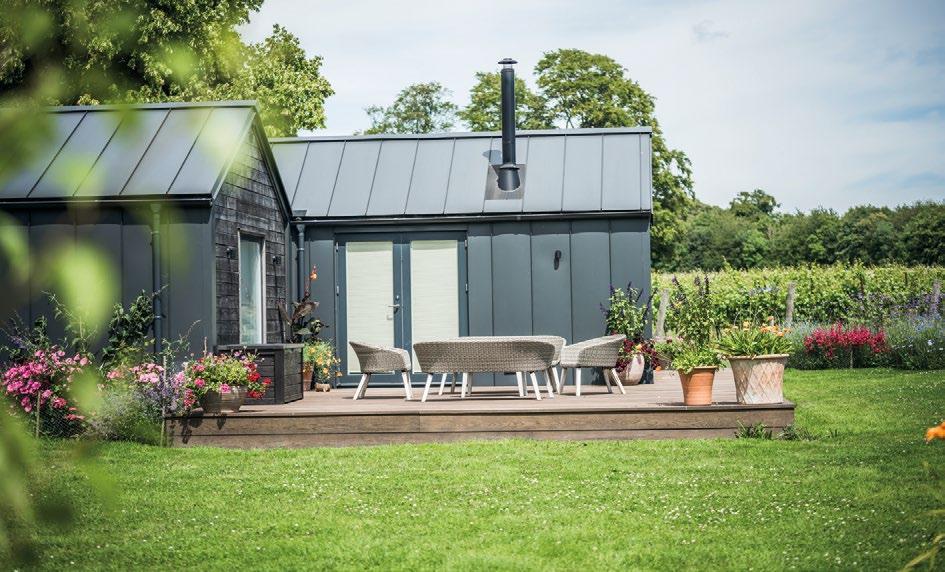

Like all great art, Jonathan Yeo’s strikingly original portrait of King Charles III has ruffled a few feathers. He tells Iconic about its evolution

It is perhaps not unusual for any artist to start out creating one thing and end up producing something else entirely. The very nature of the artistic process creates live energy, sending the imagination fizzing off in often unexpected directions. Just ask British artist Jonathan Yeo, who began work on a commission to paint the Prince of Wales, and ended up three years later producing the first official portrait of the King of England.
“He was still Prince Charles when they first came to me about it, and if it had been finished when he was still the Prince then maybe there wouldn’t have been the same reaction,” says Yeo. “The reaction to it was really funny. I was really surprised by how many people were shocked by it as being radical in some
way. It didn’t feel that way to me, and I don’t think it seemed that way to the subject either, because he’s aware of my work. But so many people saw that portrait who hadn’t seen my work, or perhaps even seen much contemporary art, and in people’s minds, a royal portrait is supposed to be very traditional.
“But when you go around the National Portrait Gallery and see portraits of kings or popes from the past, they weren’t being done in a retro way, they were being done in the style of the time. So it seems logical that something you paint now should be in the style we paint now, or at least in the artist’s own style. And my style is a bit of a quirky one. I’ve developed by accident; I didn’t go to art school and have just done the things that I found interesting.”

Yeo’s royal commission came via the Worshipful Company of Drapers, who sought a contemporary portrait of Charles to hang alongside generations of royals on the walls of its fabulously opulent Livery Hall in the City of London. In the summer of 2021, Charles sat for Yeo for the first of what would become four sittings, held at Highgrove and later Clarence House, the last of which was in the autumn of 2023.
“He was very easygoing,” says Yeo. “He’s a kind person, I found. I’d met him a few times, because I painted Camilla a few years before [and also his father, the then Duke of Edinburgh]. So he was not completely unfamiliar, and I knew he was generous spirited and often funny – he’s got some of his dad’s wit – but he’s a sympathetic person, and he makes an
effort to put you at your ease. I knew that he liked my style of work, because he bought one of my other pictures. He knew what to expect, at least broadly.
“If I hadn’t had any dealings with him, and he’d been king already, I might have felt more pressure. It’s hard to know if it would have turned out the same. I was just doing it on instinct, trying to make it interesting. More than anything, I was trying to translate, as I usually do, the individual I saw, and reference the office and the tradition, but make it more about who this man is and the time he’s living in.”
The commission made two stipulations: that the canvas should be 7.5ft tall, and that Charles should wear the uniform of the Welsh Guards, of which he was made a colonel exactly 50 years ago.
“The outfit was so very red,” says Yeo. “It felt quite anachronistic to me, so I guess I was trying to find a way of softening the impact so there was not too much focus on the uniform. My way of avoiding it was to let the whole picture colour blend and slightly confuse the sense of foreground and background.”
The predominantly red palette takes on a pinkish tone on a phone or tablet screen, to which Yeo attributes some of the shock value it initially generated. “Most people don’t see the picture in the flesh, they were seeing it reproduced on their phone screens, where the colours are always exaggerated, and the fact it has been shrunk from 8ft down to 7in kind of concentrates it. It is a bit more subtle than it came across in the media. But then at the same time, that’s probably part of the reason it spun around the world so much. Over time, I think more people will see the actual painting and will get it.”
Even before painting the king, Yeo had become the pre-eminent portraitist of his generation, having honed his talent since setting out to teach himself in the 1980s at a time when portrait painting was out of fashion. His portfolio is formidable and impressive, encompassing actors and politicians, broadcasters and activists, his paintings of David Attenborough,
Tony Blair, Damien Hirst, Nicole Kidman and Malala Yousafzai among a litany of iconic works.
“A portrait is a document of the relationship between the artist and the sitter, to some extent,” Yeo says. “It’s a bit of biography, it’s not a snapshot. You’ve got this chance to get to know someone over the course of several sittings of many hours. Sometimes those often spread over many months. And that relationship evolves, and they become more comfortable with you. And you see different things, you talk about different things. Often, bit by bit, people open up about themselves, and so if you’re lucky, you’ve got this chance to tell multiple stories.”
Yeo’s artistic journey has been rooted in the possibilities of figurative painting, which has led him to experiment in a variety of areas, including his infamous collage of George W Bush, made up of fragments from pornographic magazines, a series of paintings exploring the modern obsession with plastic surgery, and dazzlingly inventive fragmented sculptures in materials ranging from resin to bronze. He’s an experimenter, and a self-confessed technology geek, but believes that whatever the tool of choice, portrait art transcends mere creativity.
“I’ve spent half my life painting portraits, and
“A PORTRAIT IS A DOCUMENT OF THE RELATIONSHIP BETWEEN THE ARTIST AND THE SITTER. IT’S NOT A SNAPSHOT”


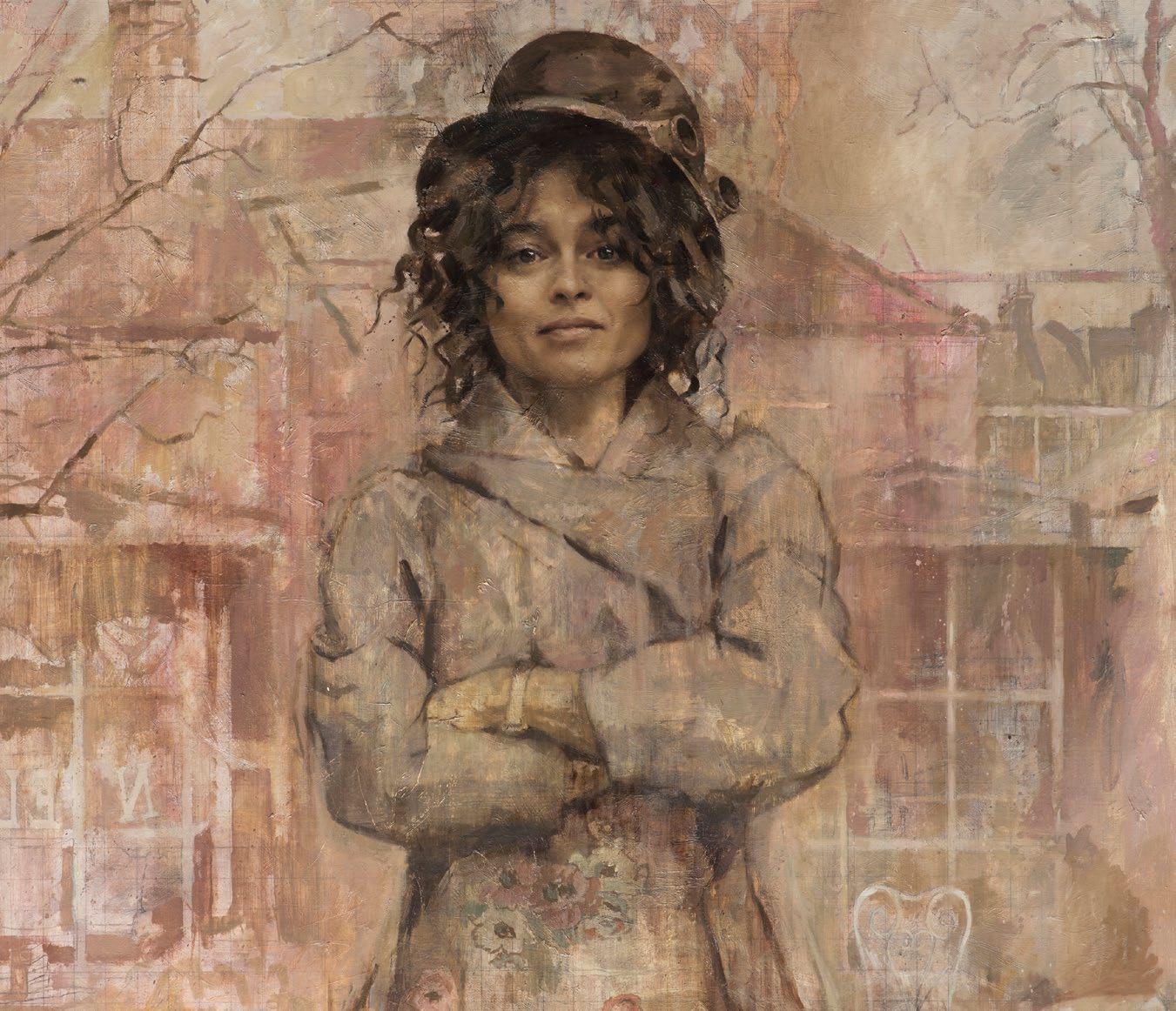
figured out that it’s not just about painting techniques, but a lot of other things, like psychology; how to get the best out of people, how to get people to lose their self consciousness when they’re sitting for you, so they can be themselves.”
Occasionally, a subject brings a literal idea that helps define a painting. This was the case with Tony Blair, who arrived wearing a Remembrance poppy on a dark suit, the stark colour contrast of which became a symbolic focus. King Charles did the same thing, by suggesting the butterfly landing on his shoulder.
“We were talking about how you could reference his interest in the environment,” says Yeo. “And he said, you know, butterflies often land on my shoulder. And I thought, that’s a nice thing, and when you weigh up the art historical references it worked out even better, because it’s all about the metamorphosis of him becoming king. The other thing that appealed to me about it was that I was worried about the stiffness, these medals, the sword, this military thing, which he isn’t known for. I thought the butterfly softened that and contradicted it. I was expecting the butterfly to be the thing people focused on.”
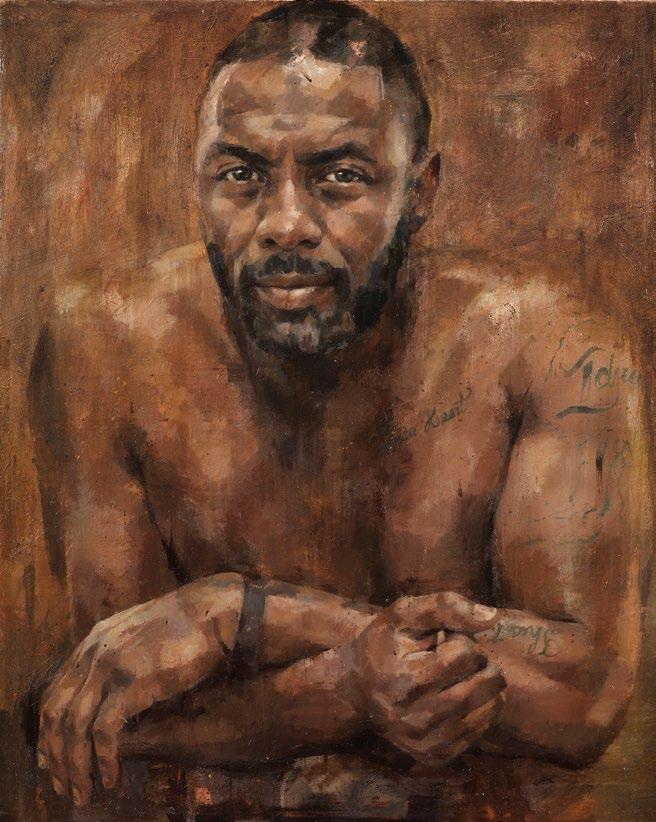
The UK has a new monarch, but the long-held tradition of the Royal Warrant remains steadfast as a mark of excellence. How does it work?
The Royal Warrant is awarded to the supplier of a preferred product or service of the Royal Household, and a number of distinguished UK businesses are proud to hold it. The succession of King Charles III brings a fresh perspective on this age-old protocol, as the Crown and its patronages change hands for the first time in a generation.
From kilt-makers and milliners to chimney sweeps and cheesemakers, the list of Royal Warrant Holders is made up of craftspeople and traders with many different specialisms. The Warrant is granted for up to five years at a time, a mark of recognition which gives
businesses an internationally recognised endorsement.
To be awarded this royal seal of approval, businesses must demonstrate the highest standard of service, quality, excellence and craftsmanship. They must work sustainably and have an environmental policy action plan in place and have supplied the Royal Household regularly for five of the last seven years.
Royal Warrant holders have the right to use the Royal Arms on their premises and stationery – a tradition that has been in place since the 18th century. The emblem can be used on products, packaging and vehicles, too.
Take a stroll down Piccadilly and
you can see a colourful Royal Arms displayed pride of place on the front of Fortnum & Mason. A favourite of the Royal Family for centuries, the luxury department store has held several warrants historically. It is currently the only institution to hold two Royal Warrants – one from King Charles III and one from Queen Camilla.
Perfumier Floris, at 89 Jermyn Street, installed a magnificent sculptural coat of arms above its door after being granted a Warrant by George IV in 1820.
Royal Warrants have been granted by monarchs and senior members of the royal family since medieval times.
The status was formalised in the
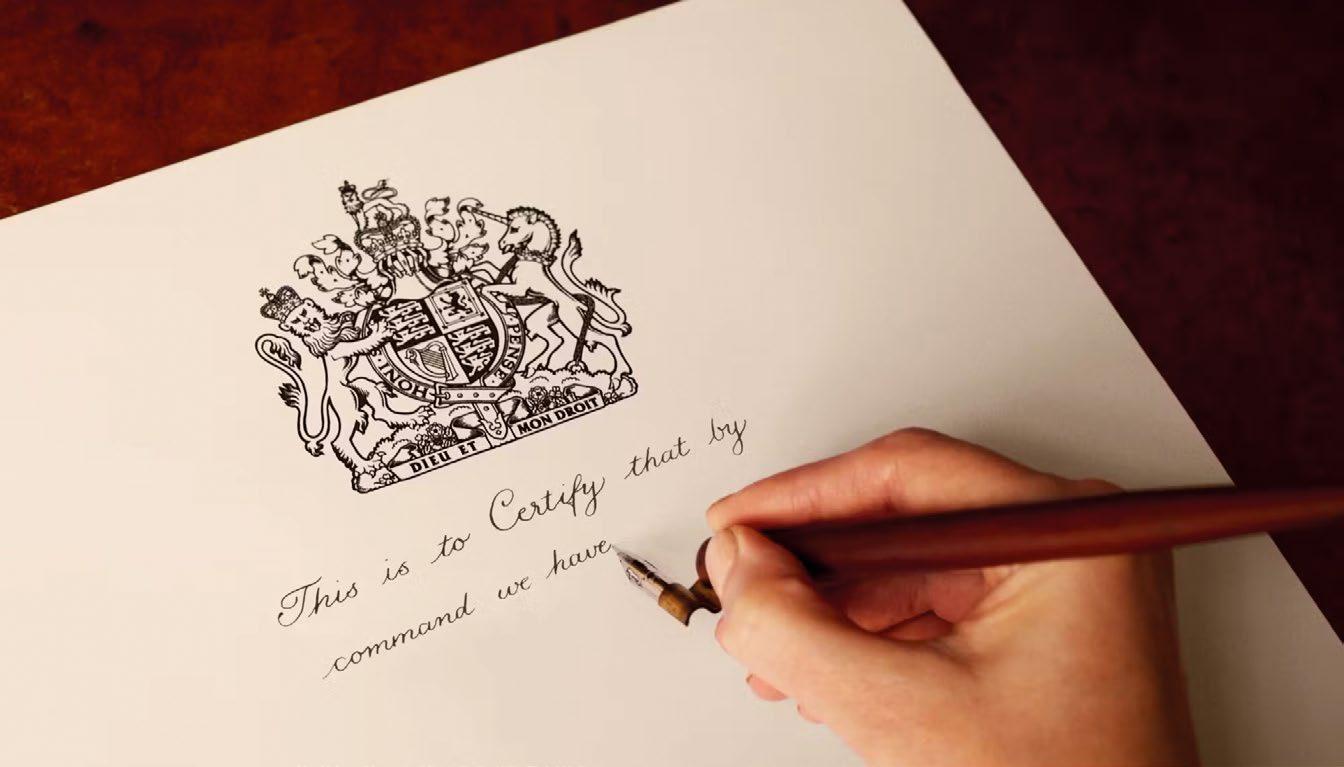
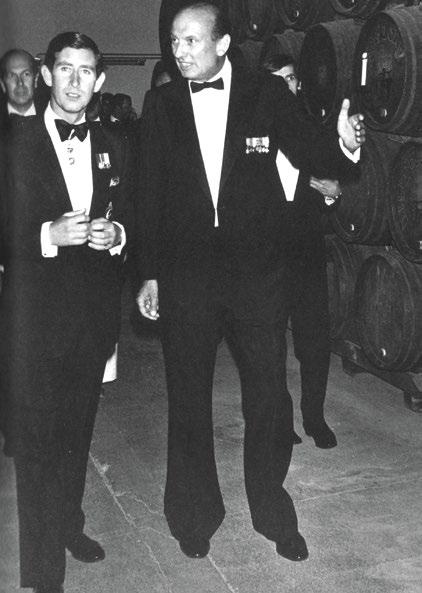
15th century by head of the royal household the Lord Chamberlain.
Queen Victoria issued more than 2,000 Royal Warrants during her reign from 1837 to 1901 – more than any other monarch to date.
In 1840, The Royal Warrant Holders Association was formed to represent the wide variety of individuals and companies holding Royal Warrants. The not-for-profit membership organisation assists with the administration of Warrants, as well as advising members. It supports selected causes through its Charity Fund and craftspeople via the Queen Elizabeth Scholarship Trust.
HM The King and HM The Queen granted their first Royal Warrants of the new reign in May 2024, and among those to receive one was Penhaligon’s perfume house. Cornishman William Penhaligon opened his first shop on Jermyn Street in 1872 and his nose for mixing exotic fine fragrance led him to be named Court Barber and Royal Perfumer to Queen Victoria. Her daughterin-law, Queen Alexandra, awarded Mr Penhaligon his first Royal Warrant in 1903. The perfume house has collected two further
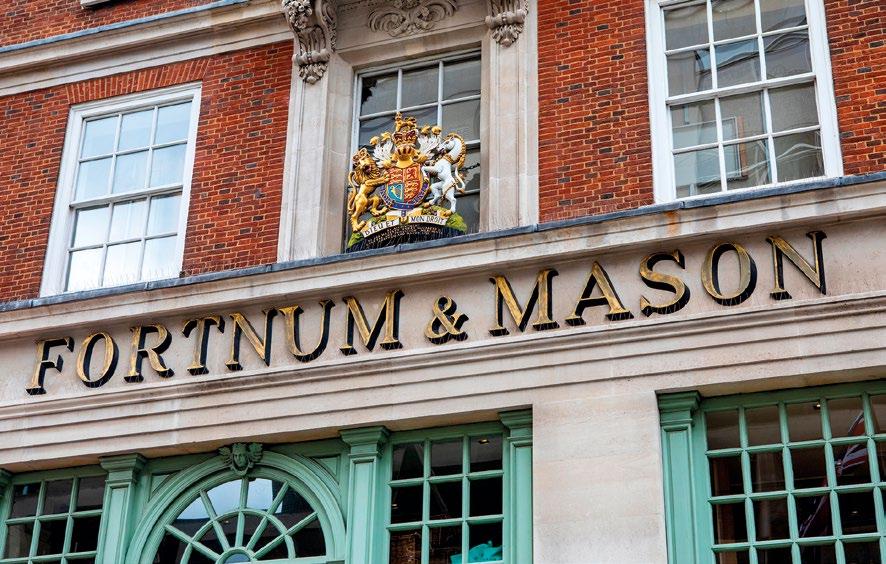
“To be awarded this royal seal of approval, businesses must demonstrate the highest standard of service, quality and excellence”
Warrants in the reign of Queen Elizabeth II, from The Duke of Edinburgh in 1956 and The Prince of Wales in 1988.
Penhaligon’s General Manager, Julia Koeppen, said: “We’re proud to have maintained a close connection to the Royal Court throughout our history and look forward to a happy and glorious future as we continue our journey to entertain the world’s nostrils with a dose of Britishness.”
Champagne Laurent-Perrier popped a cork in celebration of being the first champagne house to be awarded a Warrant by King Charles III. Dating back to 1812, the independent family champagne house is committed to crafting the finest champagnes using sustainable practices. The only champagne house to hold the Royal Warrant of the Prince of Wales, this honour is one that Champagne Laurent-Perrier is delighted to maintain.
Alexandra and Stéphanie de
Nonancourt, family owners and members of the management board of Laurent-Perrier, said:
“This accolade reaffirms our longstanding relationship with His Majesty which began when he visited Laurent-Perrier with Lord Mountbatten for the United World Colleges with our father back in 1979. We are deeply honoured to be granted the Royal Warrant from His Majesty the King.”
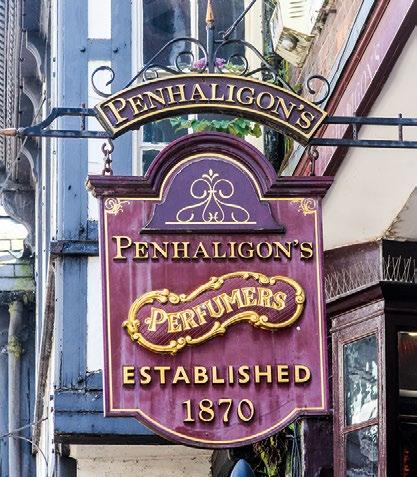

Mushrooms are taking over the beauty world says Susan d’Arcy, hotels and wellness editor at the Sunday Times


Did you know that humans share about 54 per cent of their DNA with mushrooms? We shared a common ancestor that lived more than one billion years ago. It is a startling fact and one that may well blow your mind – without ever being within sniffing distance of the well-known magic variety of mushroom. Studies continue to shine a light on other fascinating facts about the secret life of fungi, helping scientists understand how the human race can harness the potential of the humble mushroom for a surprising number of planet-saving benefits. Mushrooms can now be used in environmentally friendly construction to create ‘smart concrete’ and an alternative to wood. Portobello mushrooms can now replace corrosive chemicals such as hydrofluoric and sulphuric acids in the making of batteries, thereby negating hazardous waste that damages the ecosystem.
Mushrooms are also behind a sustainable alternative to leather championed by A-list designer Stella McCartney and a revolutionary anti-frizz haircare
range developed by engineering giant Dyson. Even more importantly, fungi also act as the telephone line that allows trees to ‘talk’ to each other, sharing information about impending conditions that might threaten the survival of our all-important woods and forests. Call me superficial but as a wellness aficionado I have to admit I am mainly intrigued by the shroom boom in resultsdriven skincare and spa treatments. Fungi is on the verge of becoming the new CBD and is already a buzzword for beauty mavens and celebrities alike. Angelica Huston has switched from a morning coffee to a ‘witch’s brew’ tea that contains six different types of mushrooms; Gisele Bundchen takes them for energy; Bear Grylls laces his chocolate cake with them; and, of course, Gwyneth Paltrow is in on the act, adding vanilla mushrooms to her smoothies. Even our favourite department store, John Lewis, never knowingly one to have its head turned by a passing fad, predicts shrooms are set to become the number one ingredient in the beauty world in 2025.
The spa world is increasingly embracing fungi too, as natural medicine to help cope with mental health issues. Prince Harry is among those to have admitted to taking psilocybin, the primary psychoactive component of magic mushrooms, as a medicinal aid to deal with trauma. The market in mushrooms as functional medicines is growing rapidly. There are now a bewildering range of pills, powders, gummies and teas that claim to help calm anxiety, encourage sleep and boost brain power.
The jury is still out on the credibility of psychedelics as a healing tool but there’s plenty of scientific heft to the beauty claims. Researchers from Penn State University in the US, for example, found that mushrooms contain unusually high amounts of two antioxidants — ergothioneine and glutathione — that can help to stave off signs of ageing and boost health. I’ll drink to that, preferably with a sprinkle


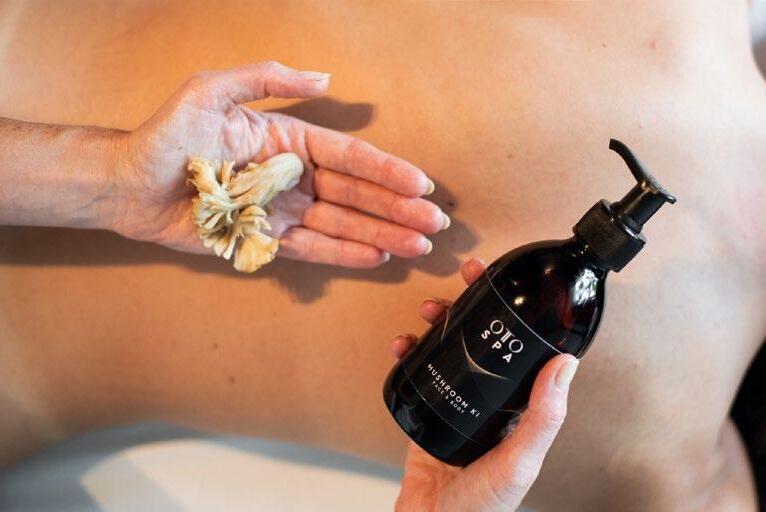
of porcini mushroom powder, which is a good source of B vitamins, protein, copper, potassium, zinc and selenium.
As with many modern trends, we are really only just catching up with traditions from the distant past. Centuries ago, Buddhist monks were using mushrooms to improve concentration during meditation. They were first hailed as a wonder skincare ingredient by the Chinese back in 618 AD by the Tang Dynasty, while they were so revered in ancient Japan that, until the 17th century, only members of the country’s nobility were permitted to eat matsutake mushrooms, which support gut health. They remain highly prized in the country today and its hospitals even use mushroom active compounds to treat digestive cancers.
One of the British skincare ranges leading in the adoption of mushrooms is OTO, which draws much of its inspiration from Japanese traditional medicine. This pioneering brand was one of the first to promote CBD’s health benefits and it is now tapping into the va-va-voom associated with the shroom. The company has created one of the world’s first dedicated mushroom treatments, called Kinoko Ki, which was launched exclusively at Chewton Glen’s spa last year.
The decadent Kinoko Ki massage and facial use an oil that features nurturing Japanese mushrooms including chaga, maitake, reishi and cordyceps. To me, this is possibly the most exciting quartet to have been formed since the Beatles broke up. Chaga has anti-inflammatory properties, preventing redness and irritation, and is packed with potent
“The bioactive compounds in maitake stimulate collagen synthesis, reducing wrinkle formation and promoting a more youthful skin”
antioxidants, crucial for shielding skin cells from oxidative stress, a primary factor in premature ageing. The bioactive compounds in maitake stimulate collagen synthesis, reducing wrinkle formation and promoting a more youthful skin texture. Reishi has been used for centuries for its stress-relieving properties, and both reishi and cordyceps have anti-inflammatory properties, and
stimulate the production of collagen too.
The treatment begins with myofascial release to target tension around the spine, followed by dry body brushing to stimulate lymphatic flow and circulation and a gentle exfoliation before the oil is applied to the face and body to rejuvenate the skin. It concludes with a relaxing shiatsu massage after which you float from the room, at one with the world. One element that encourages that calmness is the specially commissioned music. OTO worked with sound artist Justin Wiggan to create a unique mushroom-powered soundscape. Wiggan captured the vibrations and electrical pulses emitted by mushrooms and paired them with specific notes and frequencies to craft an auditory experience that adds a subtle layer and deeper immersion. I found it powerfully affecting.
And let’s not forget that fungi remain absolutely delicious for dinner too, from mushrooms on toast, to pasta with shavings of tuber magnatum Pico, better known as Italian white winter truffle. Use it sparingly, it can cost up to £250,000 per truffle.


The gardens at Cliveden are part of the National Trust’s 223-strong collection. We ask Pam Smith, the Trust’s Senior National Consultant for Gardens and Parklands, what makes a garden special…
The National Trust is Europe’s biggest conservation charity. With over 700 gardeners and 50 apprentices – plus a team for visitor experience at each property – there is a lot of responsibility on everyone’s shoulders to maintain the jewels of Britain’s green and pleasant land. The National Trust looks after 223 gardens and more than 200 parklands – an estate which accounts for around one in ten of the registered landscapes in England.
What makes a National Trust garden?
We have our own internal best practice ambitions. One of those is about plant health and biosecurity. We have rules on procurement (we are peat free), ideally UK-grown stock and plants being quarantined for a minimum of six weeks before being planted, to ensure early warning of any threats to plant and soil health.

We also have environmental ambitions, such as not wanting to use mains water because it makes plants more dependent on water and therefore they will brown more quickly. There are certain plants in most gardens that are really important. They may be very rare or iconic. So, we do have a hierarchy.
We look at significance: where is
our threshold and sphere of influence – because sometimes we do not own the full footprint of a historic estate – and then, why does it matter and to whom? The reasons why the National Trust acquires gardens are varied. Sometimes, with the early ones, it was because historic houses were under threat due to death duties. Sometimes a family can hand a property to us but still live in part of it. Sometimes it came to the National Trust because it is such an important garden. Hidcote Manor, in Gloucestershire, was the first property we got because of the garden, not because of the house, the person who lived there, or the paintings on the wall.
What factors have to be considered when making decisions about your gardens?
We have some legal requirements that we do have to comply with –for example water quality or looking after trees that have preservation orders.

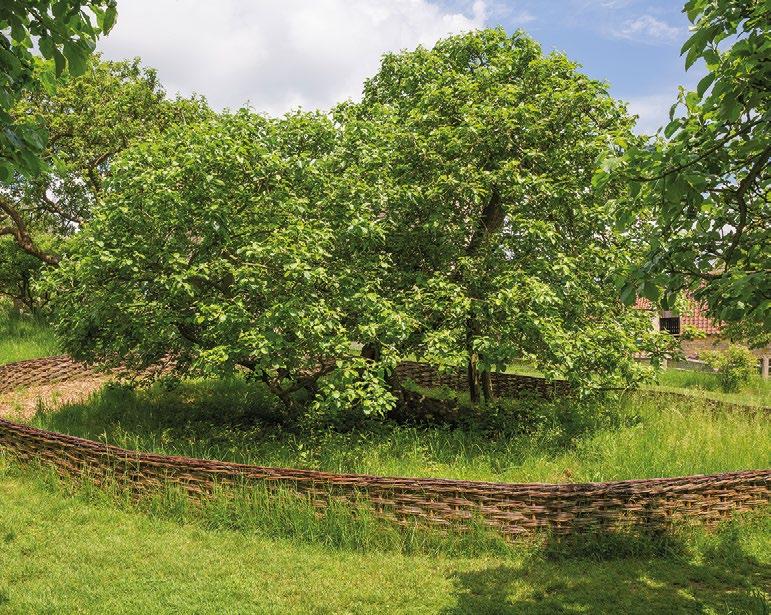
“Where we do decide to restore, it is based on strong research, evidence on the ground, public benefit and to enhance significance”
But we look at what is happening to our gardens and their vulnerabilities. For example, are they getting flooded or seeing the effects of climate change and, if so, what are we going to do about it? Then also – what are the opportunities? What can this garden bring that is different?
Some of those are seasonal, such as Bodnant Gardens in Wales, which has a laburnum arch, so in May you have this fantastic tunnel of bright yellow hanging flowers that is an amazing opportunity for people to see, but what are the other opportunities that could entice people to go at different times of year?
We are also a Safe Site, so once land comes to the National Trust,
it is legally inalienable. It means we can work with botanic gardens around the world to look after trees that are threatened in the wild. We have a plant conservation centre in Devon that is home for all our propagating –including rare plants. For instance, we may have a plant with an amazing story, such as Isaac Newton’s apple tree, which we look after and propagate.
Garden and plant conservation must be key concerns within the work of the National Trust?
The whole idea of garden restoration and garden research is a relatively new discipline, that only really came in around the 1960s. We have examples of
garden recreation and restoration that the National Trust did that we would not do today. That is not to say it was wrong; it was just a different mindset. We would question now, if it is not original or we do not have enough evidence of ‘in the style of’, is that good enough or should we just do something new?
Where we do decide to restore, it is based on strong research, evidence on the ground, public benefit and to enhance significance. For example, we had many plans for the former gardens at Hanbury Hall in Worcestershire – a rare garden design style by designer George London. These highly formal ‘Great Gardens’ of wilderness,
“These highly formal ‘Great Gardens’… were recreated in the 1990s and now provide visitors with the experience of being in an early 18th century garden”
box hedging and parterre were recreated in the 1990s and now provide visitors with the experience of being among an early 18th century garden that previously we would only have seen illustrated.
We often have many ‘original’ plans that are fascinating, but it does not mean we ‘put gardens back to a fixed date’. Gardens are living heritage, they change, and the National Trust do commission new design in historic sites. We are not scared to do new things, because the people who lived in these houses were constantly being patrons of new design. We have got some really nice case studies of how the Victorians romanticised garden restoration – they put a Tudor Garden in, because they thought it felt medieval. They were doing it on a whim. That is the joy of gardening: sometimes it is a very personal approach,
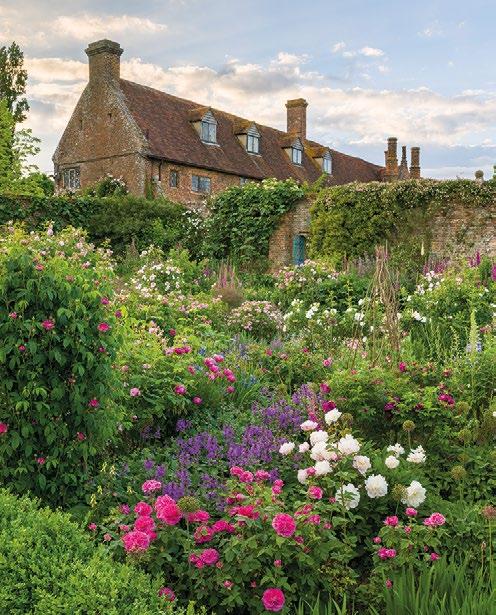
and we want our head gardeners to put their stamp on places, too.
How important is visitor experience?
It is a massive part of it! These gardens belong to everybody. You do not have to be into gardening yourself to enjoy being in them. Even if you visit on a wet Tuesday in November, you will see something different that visitors in July will not see. And I think that is what makes it quite personal to people.
One of my favourite gardens to visit is Penrhyn in North Wales, and I know of an amazing place to sit behind the derelict chapel that hardly anyone ever goes to. And that is because I have known that garden since I used to visit as a child. We will probably all have connections to a local place. These gardens bring both a sense of community and very personal memories.

National Trust covers England, Wales and Northern Ireland. Are there specific features that are unique to English gardens?
I think the core of the English garden is, it is very manipulated. It can be quite small-scale – not looking miles beyond to the hilltop and mountain ranges, but rather inward. We also have over 420,000 cultivated plants to choose from, yet there are only 1,500 native plants and five native evergreen trees and shrubs in England. Most of our plants are not English; can you imagine just how boring our gardens would be if we only chose native species? In England, we have got a lot of gardens that are smaller – 40 per cent are under five acres – but I think one of the things that ‘makes’ English gardens is the influence of some of the people – we’ve got quite a lot of localised garden designers who are famous.
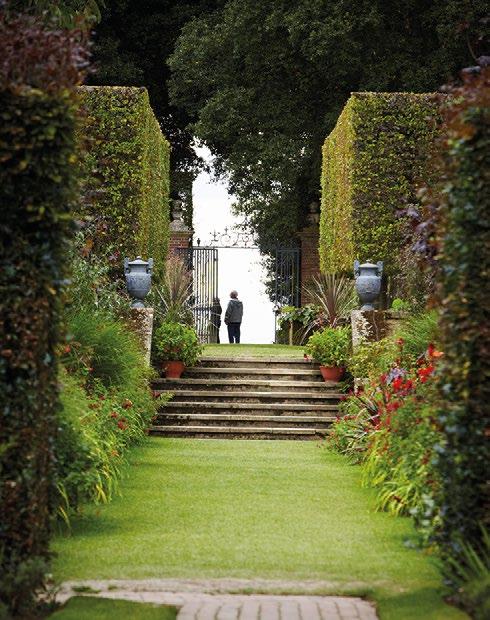

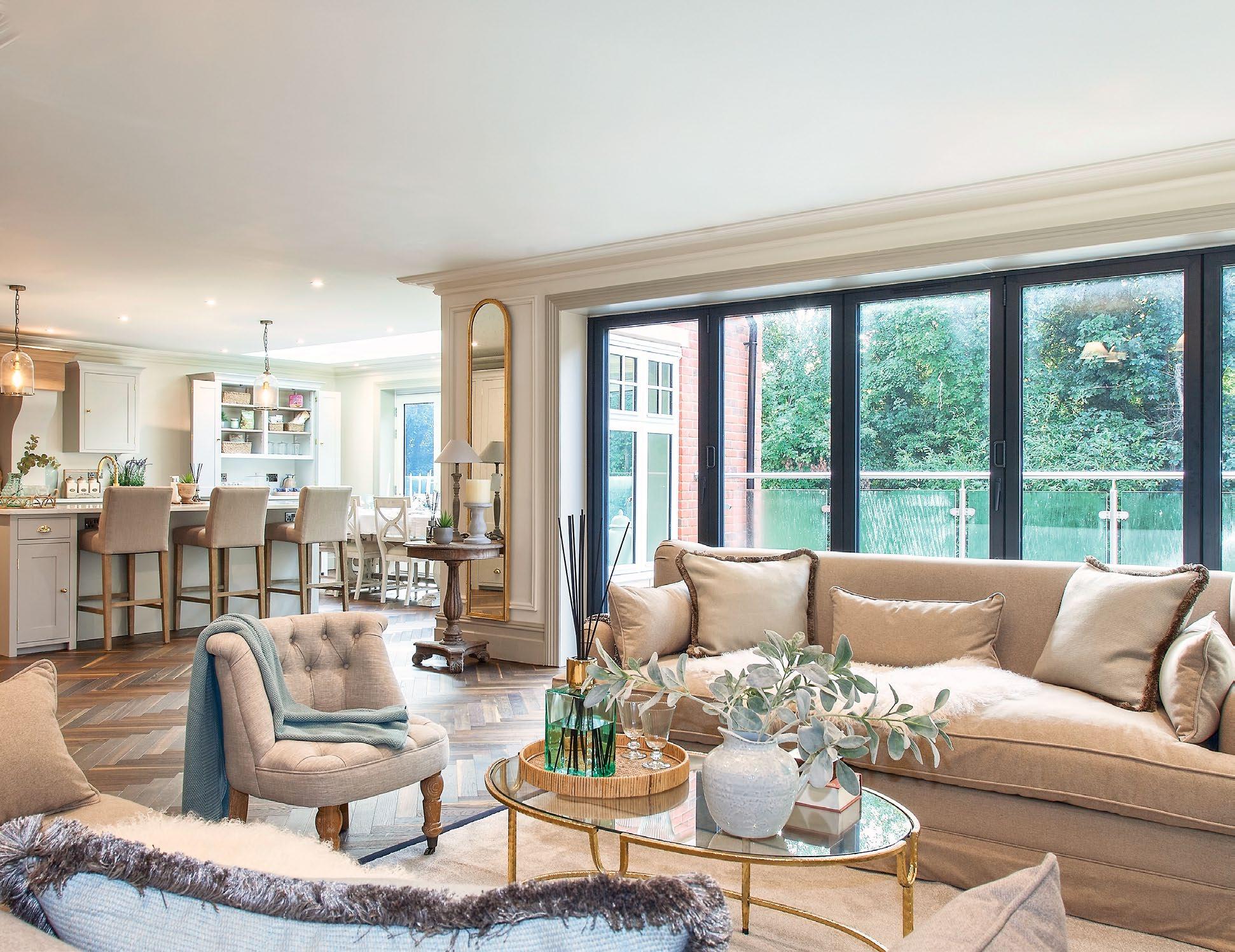
At Luxfords Signature Abode, we specialise in meticulous, end to end handling, setup, and installation services, tailored for the finest interiors, private domestic homes, high end hotels and businesses alike. Experience unparalleled quality and attention to detail with our comprehensive suite of services.
A handbag is more than just a fashion item – those in the know will buy with one eye on the future, says Alexandra Carello
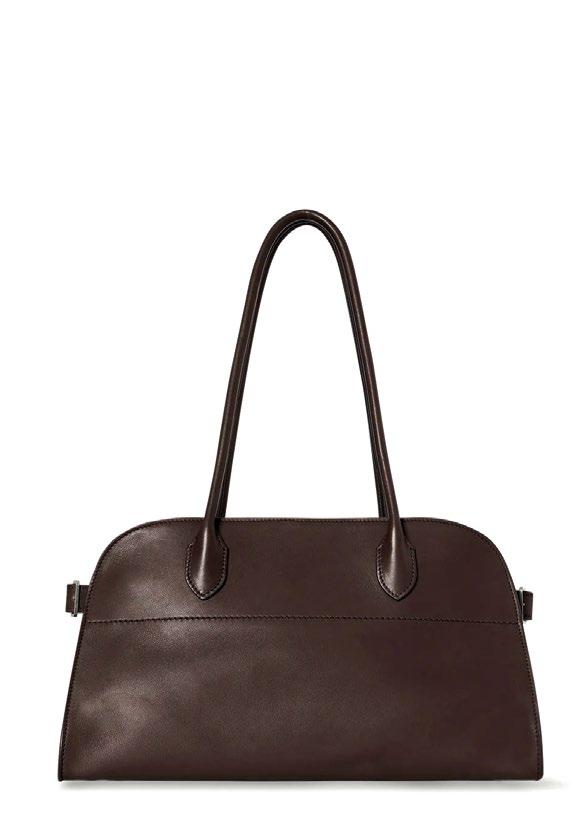
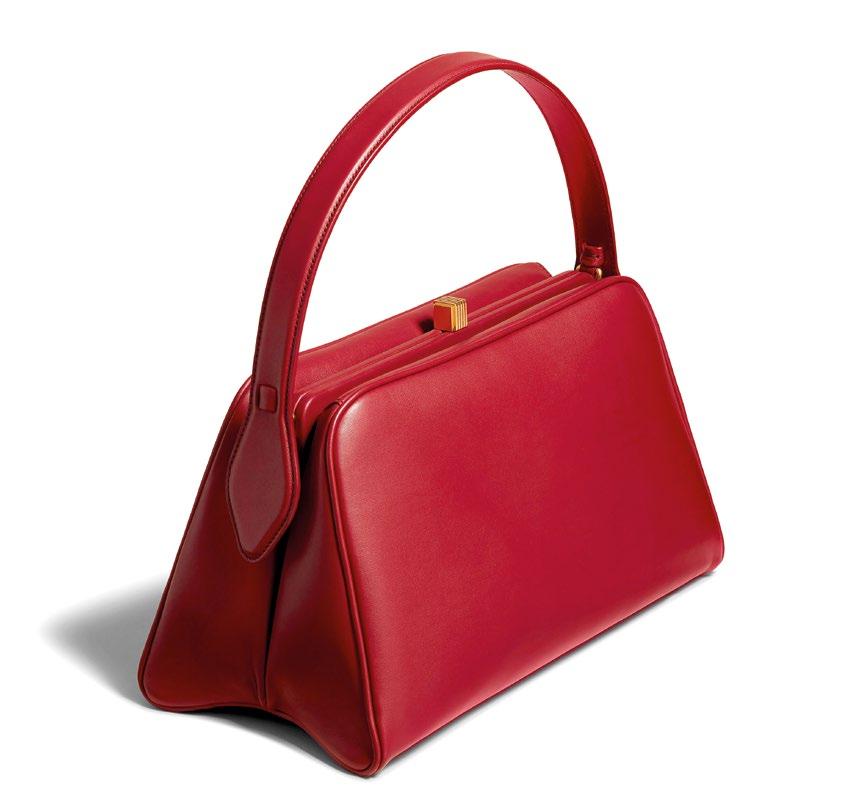
What do you want your handbag to say about you this year? Surely that you are a style-savvy individual that knows about enduring style. Rest assured, after reading this guide, your handbag will do the talking for you. To start, I would suggest identifying a few key factors that to me are non-negotiable. Mainly because you want to buy for the future and not just tomorrow:
• Quality and craftmanship must be number one, something that will stand the test of time on both the use and style fronts.
• Secondly, look for something timeless so you can wear it again and again and never be bored.
• Thirdly, it must be functional – good fashion that you will keep coming back to always starts with functionality so it is often sage advice to opt for something that you will enjoy wearing and feel comfortable with. You will need it to be, quite literally, an accessory to your life.
But importantly, use all of the above as a solid foundation for the fourth and final rule in this mini guide to buying a handbag.
After all that, I would look for that feature, no matter how small, that makes the piece come alive for you, that turns it from being a solid purchase into a moment of love and lust. A little something, however idiosyncratic that whispers to you, I must be yours. Fashion, with a capital F, should always evoke a deeper longing in you and always be just a little bit fun.
Luckily, there are an exciting cohort of designers that are creating beautiful and interesting pieces this year.
Brands like The Row should be namechecked for their ability to create timeless icons for the fashion elite. The brand’s Margaux bag has become a cult style, garnering waitlists and envy around the world. However, in my opinion you are paying a lot of money for someone to maybe know that YOU are in the know, which doesn’t feel all that fun or interesting. To me there are other brands to have on your radar that are achieving the perfect balance of classic yet exciting.
Khaite is a brand that continues
to do no wrong, creating pieces that sit at the intersection of classic and cool. The Cate bag in Oxblood red with 18-carat gold clasp is very special yet practical enough for every day. I adore Oxblood for a more interesting take on a neutral colour. The ultra-luxe details will be like a little secret for you, unknown to the passer-by, and the shape is a great hybrid of modern structure and nonna’s purse, which I adore. Khaite is on my highly recommend list!
Marina Raphael might be one of the most exciting accessory talents in the industry today. Recently named as Artistic & Design Director of Handbags for Elie Saab, this young entrepreneur offers distinctive designs inspired by strong architectural shapes. Her signature Riviera bag, in large to mini sizes, is impactful yet tasteful, especially in micro form and covered in Swarovski crystals. I have the large version as my day-to-day bag and feel whipsmart whenever carrying it despite lugging around my laptop and multiple other life accessories that may or may not include a child’s nit comb.

“I would look for that feature, no matter how small, that turns it from being a solid purchase into a moment of love and lust. Fashion should always evoke a deeper longing in you and be a bit of fun”
The namesake designer advises you to “opt for a timeless shape in a colour you frequently wear. Prioritise high-quality materials and craftsmanship and select a versatile size that transitions easily from day to night.”
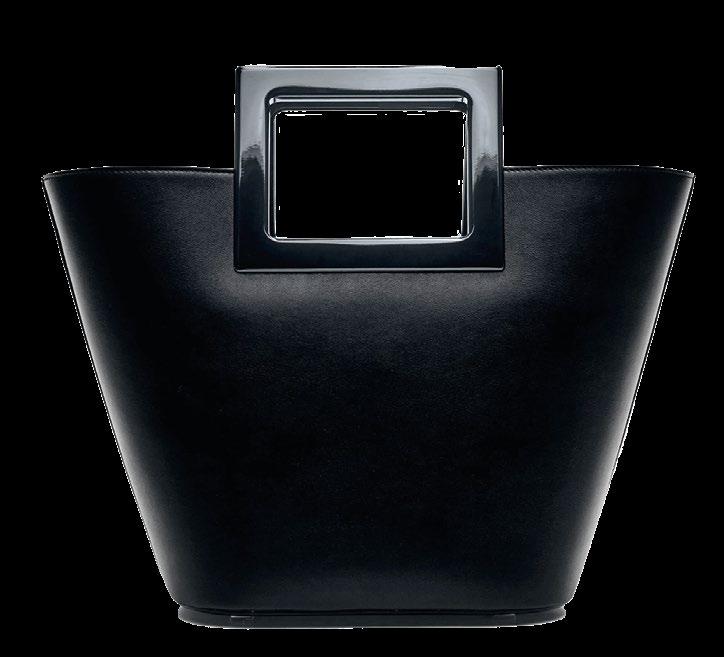
Savette New York is a great example of a modern classic brand, embodying upper east side elegance that you will just want to wear again and again. I am fan of their Slim Symmetry Pochette, which has taken influencers and celebrities alike by storm. I predict it will continue to gather momentum, as it is an instant classic, but the eye-catching clasp and slightly unusual silhouette means it stands out for all the right reasons. Go for the clay colourway as a more interesting option than beige that will still go with everything.
In the same breath, Alaïa’s Le Teckel bag with its elongated shape is highly distinctive yet classic. The black and white pony dots might just be my favourite for a touch of Cruella de Vil in your daily life.
More cost effective but still beautiful is DeMellier. I know many who have been won over by their Midi New York Style for a super-practical and chic city bag.
The Mocha colourway in suede is my choice, because I know this chocolatey palette that has dominated recently will continue to be on trend.
In terms of fabrications, there has been an explosion in buttery suede and nappa leather, but mock croc has stood out for me and will keep going from strength to strength. Glamorous and elegant, this adds a little bit of movie-star sheen to every day.

All of these contain this special sauce of classic with a twist. The rise of quiet luxury has seen an abundance of copycat styles that firmly sit in the beige. But those who are obsessed with quality and craftmanship understand that their choices must speak a subtle language. They are serious about style and all their pieces have that extra element to ensure it never becomes boring or, worse, ubiquitous.

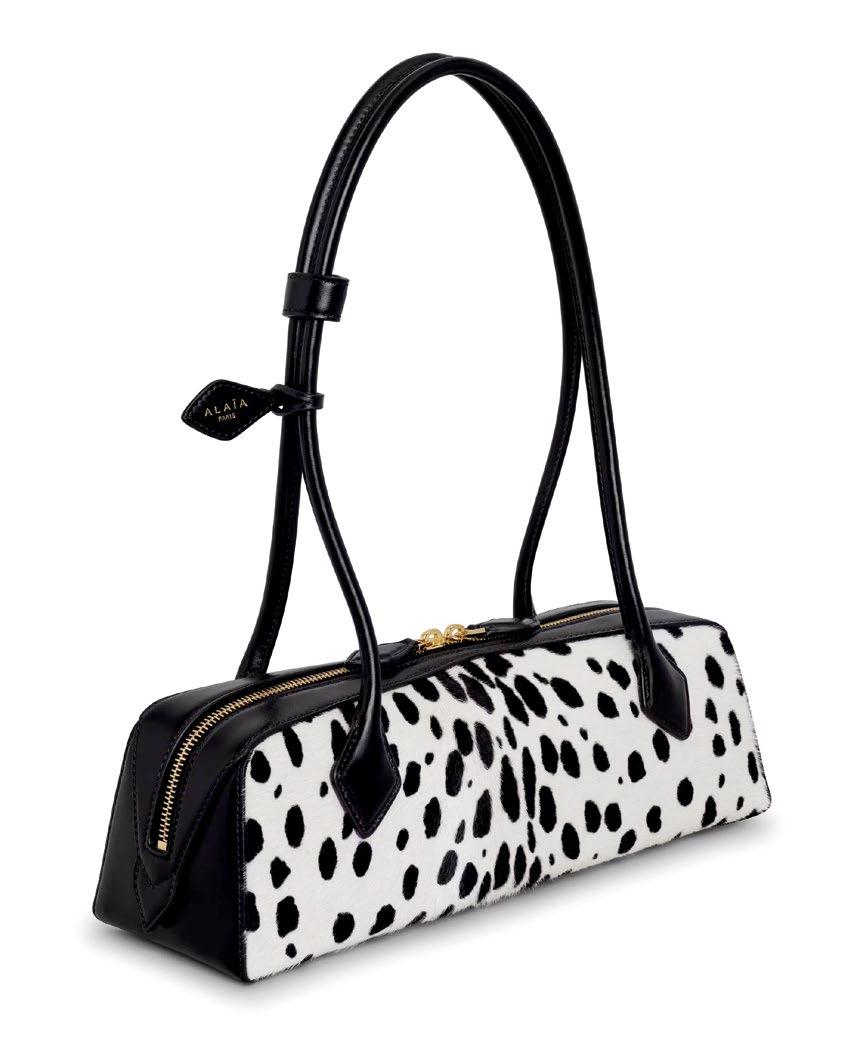
“Those who are obsessed with quality and craftmanship understand that their choices must speak a subtle language. They are serious about style and all their pieces have that extra element”
Of course, if you want to be seriously style savvy, there is a whole market where you can treat your handbag purchase like a financial investment. For some it is now no longer enough for handbags to look good – the price appreciation of certain brands means if you choose you can treat the shop floor like a trading floor. A potent mix of culture, history, heritage, brand, association and, potentially, some real magic combine to create a recent phenomenon where certain handbags are being ascribed a value that just keeps increasing. This is probably more about the stories we humans attach to it than the actual value of the handbag itself. Of course, the
quality should be of the highest calibre, but the real value comes from the narrative and the cultural weight that humankind places upon it.
Chanel and Hermès are two brands that have achieved cult status within this category: appreciating in real-term value and consumer sentiment. Suddenly, those bags, recognised the world over, are more akin to art than fashion. Kept in perfect condition, packaging firmly on, away from light and in a temperature-controlled room, we start to see a phenomenon where these bags, and to some extent brands, cease to be commodities and instead become culture.
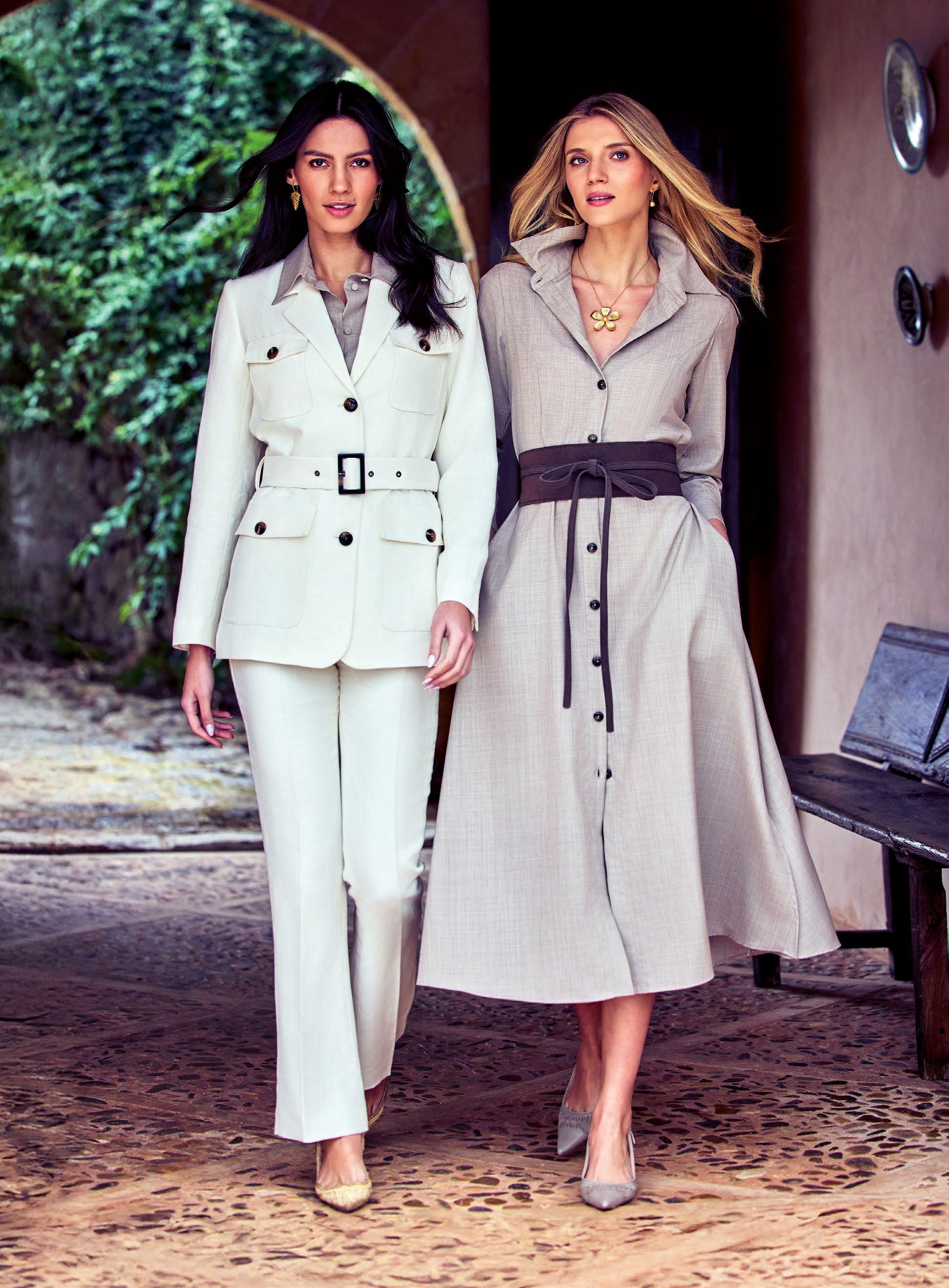

British luxury yacht maker Sunseeker welcomes new owners, and begins its latest chapter by partnering with Iconic Luxury Hotels


An evocative and internationally recognised brand, Sunseeker is the world leader in luxury performance motor yachts, famously supplying iconic boats to four James Bond movies. Founded by brothers Robert and John Braithwaite in 1969, it has always been a proudly British brand, and today its near2,000 employees produce around 130 boats every year in Poole, Dorset.
And British it will remain, despite the news that in October 2024 the company was acquired by Miami-based investment firm Lionheart Capital and Milan’s Orienta Capital Partners, heralding an exciting new era. At the same time, Iconic Luxury Hotels and Sunseeker London cemented a new partnership, acknowledging the synergy between two great British luxury names.
We ask Sunseeker CEO Andrea Frabetti to talk history, innovation, technology, and what the future holds for this luxury brand.
Sunseeker is a British brand – how important is this to the business, especially in light of the new Italian-US ownership?
Sunseeker was born in Poole and we are immensely proud of our British roots. Our yachts are still crafted right here in our Poole shipyards, where every detail is handled with the same passion and skill that has defined us since day one. Each year, around 130 of our yachts are built at our Dorset facilities, spanning from 38ft to 161ft. Our Design and Technology Centre is at the heart of it all, and we are here to stay – continuing to invest in local jobs, training programmes, and the community. While we’re fortunate to have a global reach, with 98 percent of our yachts exported worldwide, we stay connected


“CUSTOMISATION IS HUGE AND WE ARE DEDICATED TO CREATING HIGHLY CUSTOMISABLE SPACES ON OUR NEWEST AND UPCOMING MODELS”
to our British heritage. With the support of Orienta and Lionheart we have the chance to grow on a global scale while preserving what makes Sunseeker so distinctively British.
How much of the company’s unique identity is owed to its history, to Robert and John, to Poole, to 007…?
Sunseeker is iconic for a reason: it is a brand rich with history and heritage. It started as Poole Power Boats and became Sunseeker International in 1985. These roots have created a loyal following grounded in trust, innovation and authenticity. And, of course, our yachts’ appearances in four James Bond films [Piers Brosnan’s last two and Daniel Craig’s first two] have cemented Sunseeker’s place in global culture. The legacy is not just part of our story, it is part of who we are and what we bring to every yacht we build. If you wander around the Sunseeker factory today you will see commemorative photos and keepsakes remembering Robert and John.
Tell us a little more about the Poole Design & Tech Centre – how its unique vertical integration process works and what it means for the end product.
This is where the magic happens. This unique facility allows us to handle every detail of the yacht-making process, from the first concept sketches to the final finishes. Vertical integration means we can manage quality at every step, from sourcing materials to assembly, ensuring that every yacht meets the highest standards. With control over each component, we are able to deliver unmatched craftsmanship and quality control.
Where do you see the luxury yacht market in 2025? What are the trends?
Customisation is huge and we are dedicated to creating highly customisable spaces, both indoors and out, on our newest and upcoming models. While trends shift quickly, Sunseeker’s advantage as a legacy brand allows us to evolve without losing sight of our identity. We focus on first-class design and engineering to stay true to the brand while adapting to our clients’ changing preferences.
Sunseeker is renowned for innovation – can you highlight some of its past and present game changers?
The Renegade 60 is a fantastic example from our heritage. When it launched in 1990 it was revolutionary – a production yacht fitted with water jets rather than the traditional propellers. It was a bold move that showcased our spirit of innovation. Another standout is the 28M Yacht, which blended performance with the luxury of a full-volume yacht. The Predator, Sport Yacht and Manhattan families each represent milestones in Sunseeker’s legacy, each pushing boundaries and introducing exciting features that redefine what’s possible on the water.
Is there more to come?
The range is always evolving. We are in the business of realising people’s dream lifestyle on the water and it is through personal relationships with our clients that we have developed an incredible understanding of what makes the perfect yacht. We are constantly asking ourselves what we can create that elevates the lifestyle of our owners, spaces that facilitate togetherness for families and friends, spaces

which offer sanctuary, privacy and comfort, spaces that are as unique as the people they are designed for.
The business is focused on sustainability. How does this manifest itself?
Sustainability is not just a corporate statement. Our long-term commitment requires real change in every corner of our business. Our current sustainability plan has 29 live projects and initiatives, from installing biomass boilers at our Poole and Portland facilities (using wood offcuts to generate renewable heat) to reducing our reliance on fossil fuels and minimising emissions throughout our supply chain. By refining our processes we are working towards a more sustainable future for the entire industry.
Tell us about some unique customisation requests from individual clients.
The average client will make anything in the region of 150 decisions when they build a yacht with us, and many have wild and wonderful requests. Over the years we’ve integrated saunas, offices, fly-bridge cinema screens and huge fish tanks.
Tell us about the partnership with Iconic Luxury Hotels.
The Iconic Luxury Hotel Group and Sunseeker London Group share a common philosophy:
delivering bespoke, unforgettable experiences. Just as Iconic’s eclectic collection of properties celebrates individuality and charm, Sunseeker’s yachts embody the pinnacle of craftsmanship, luxury and personalisation. Both brands thrive on the principle of creating unparalleled moments for those who value exclusivity and excellence.

How did a quaint Cotswolds village become the epicentre of a Victorian artistic revolution?
The painting of an elegant lady gazing coolly over her bared shoulder is one of Cliveden’s finest works of art and depicts Nancy Witcher Langhorne, Viscountess Astor. She was the daughter-in-law of one of America’s richest men, William Waldorf Astor, 1st Viscount Astor, who bought Cliveden in 1893. Dated 1908, it was one of the last society portraits painted by John Singer Sargent (pictured right).
Sargent, who was considered the finest portrait painter of his generation, died exactly one hundred years ago. A legendary and controversial talent, he was also part of one of art history’s most extraordinary episodes, and his legacy remains deliciously entangled with the lineage of Iconic Luxury Hotels to this day.
It all started in 1885 in the Worcestershire village of Broadway, which today is home to The Lygon Arms. American artist Francis Millet, whose well-travelled life had fuelled a belief in seeking influences far beyond his native country, brought his family to England in search of a fresh perspective on life in the late 19th century. In Broadway he found a haven
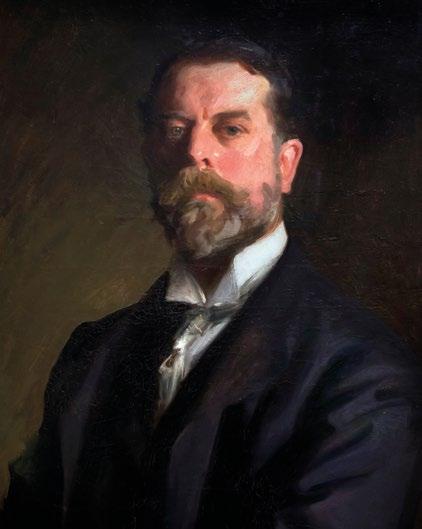
almost too perfect to imagine, an idyll seemingly impervious to the times, and installed his family in Farnham House on the village green.
Millet was an evangelist for encouraging fellow artists to seek and share this new inspiration, and also a bon vivant who warmly welcomed friends and guests into his circle and, in that summer of 1885, Farnham House quickly became a magnet for artists such as Edwin Abbey, Frederick Barnard, Alfred Parsons and, especially, John Singer Sargent.
At the time, Arts and Crafts
pioneer William Morris was already encamped in Broadway Tower, Capability Brown’s eccentric folly standing atop Beacon Hill, and his many guests were seduced by the village’s charming immunity to the unstoppable charge of the industrial revolution. Broadway, which had been somewhat left behind by the exodus to the cities, was suddenly transformed into a hotbed of creative fervour.
“The Millets being incredibly sociable people would never say no to fellow artists or writers or musicians, and Farnham House from that first summer became the arty centre of Broadway,” says artist and local historian Jeremy Houghton, whose studio and gallery is in Broadway. “And with it came the beautiful gardens, and in the gardens are these two fantastic gazebos, where in the evenings the soirees and all the dressing up happened. The villagers thought the Americans were totally mad!”
For Singer Sargent, coming to Broadway was life changing. Stung by a scandal surrounding his now infamous painting Portrait of Madame X, he had abandoned Paris for England,
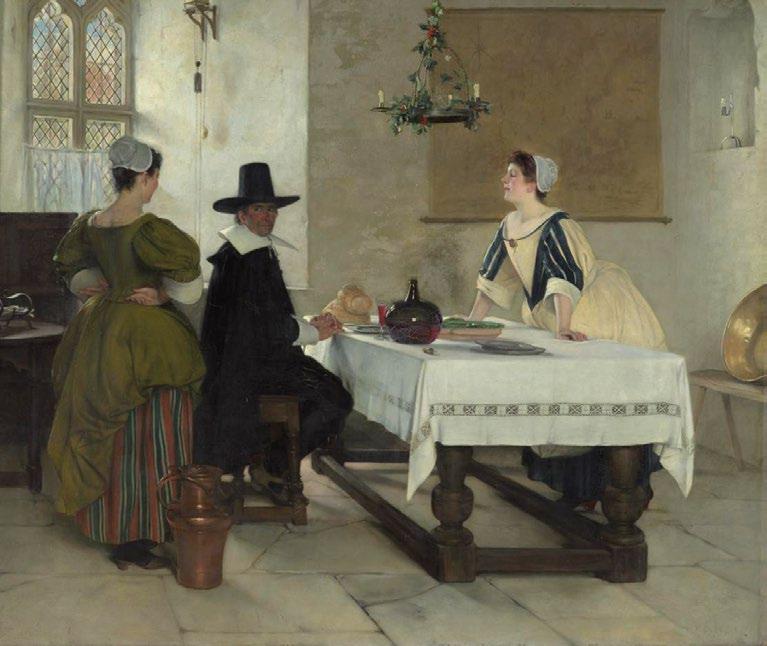
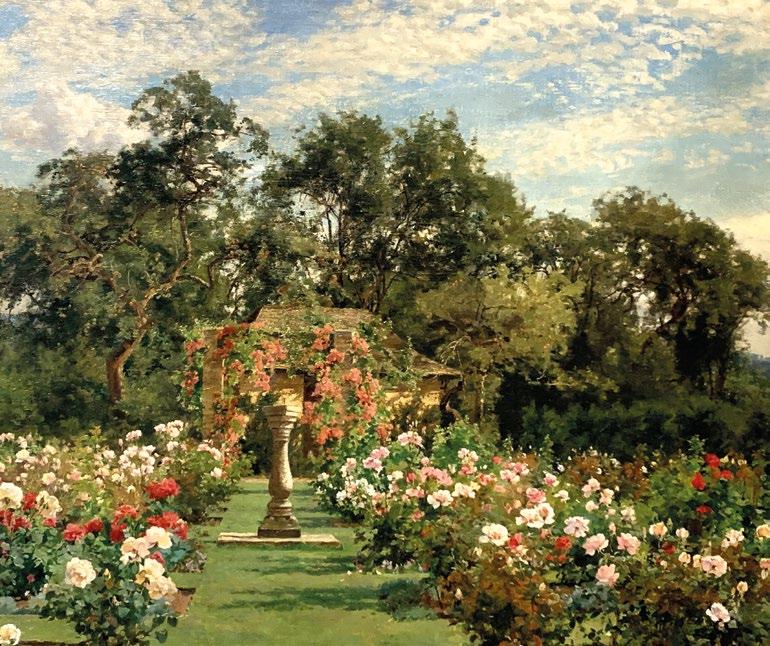
In the garden of Farnham House, Singer Sargent began painting en plein air, experimenting with an Impressionist style
and taken up Millet’s invitation, wondering if he would ever paint again. In the garden of Farnham House, inspired by fellow guest Robert Louis Stevenson, who was writing A Child’s Garden of Verses, Singer Sargent began painting en plein air, experimenting with an Impressionist style.
He sought to capture the exact level of light at dusk, so every day from September to November 1885 he painted in the few minutes when the light was perfect, successfully achieving the purple tint of evening on the canvas. Such was his obsession, he replaced dying flowers with artificial blooms, and then when winter took hold, put down his brushes until the following summer, resuming with the same fastidiousness in the garden of Millet’s new Broadway home, Russell House. The painting took
a third summer to complete, but the result was undeniably the most stirring work of the artist’s career. Entitled Carnation, Lily, Lily, Rose, the painting depicts two small children dressed in white, lighting paper lanterns as day turns to evening in a vividly realised garden. The two children were the daughters of his friend, Frederick Barnard.
Immediately bought by the Tate Gallery, the painting became the first of Singer Sargent’s works to be acquired by a public museum, and remains proudly on display at Tate Britain one hundred years after the artist’s death.
Broadway’s ‘creative colony’ found itself a physical home in the village when Millet and Singer Sargent persuaded a local farmer to let them turn a 14th century barn called Abbot’s Grange into a studio. Here, many
masterpieces were created, including Millet’s celebrated Between Two Fires, using two local women as his models.
The creative colony also embraced writers, musicians and designers, and so embedded did it become in the village’s way of life, the visiting artists even challenged a team of British writers, including JM Barrie and Arthur Conan Doyle, to a cricket match on the green.
Broadway’s incredibly rich artistic heritage is part of the village’s soul, and in 2025 it will get star billing at both the Broadway Museum and Art Gallery and the biennial Broadway Arts Festival.
“From 14 April to 15 July we will have a small but very focused exhibition called Sargent’s Circle, featuring works produced by Sargent in and around the time
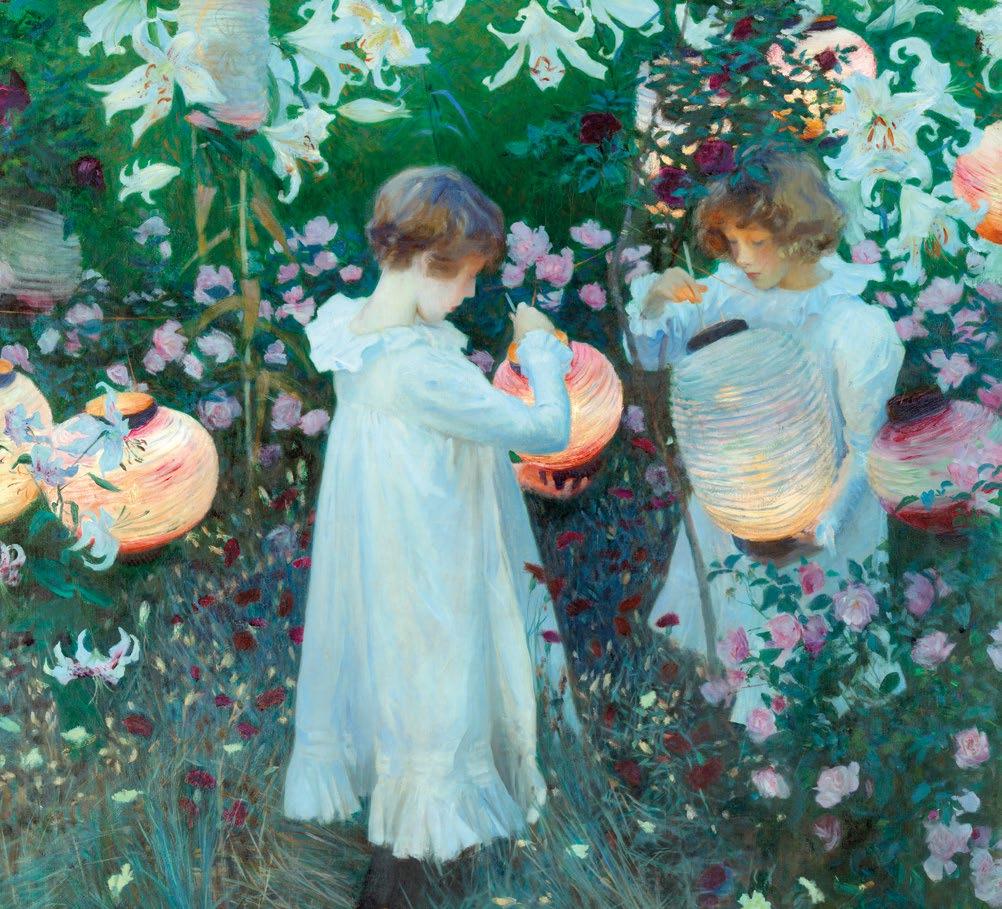

The Broadway Arts Festival will as always feature a rich menu of outdoor theatre, live music, art and design talks, demonstrations, exhibitions and art sales
that he was staying in Broadway, depicting people he would have associated with in Broadway,” says Anona van Lawick, Broadway Museum director. “It is a very focused exhibition of six to eight paintings that were key works referencing his time here.”
The highlight of this time, on 6 June, will be a truly special event bringing together the world’s two foremost Sargent experts to discuss the artist’s work live at the museum. Renowned American portrait artist Michael Shane Neal and Sargent’s great nephew Richard Ormond, will join forces for an evening.
“The reason I’m so excited is that our exhibition will have Shane and Richard discussing the paintings, the techniques that
Sargent used, the people he specifically painted and their relationship with him,” says van Lawick. “It will be a really lovely human touch. This will in fact be the opening event of the Broadway Arts Festival (6-15 June). Listening to the two of them together will be a conversation that you will just never want to end! They will be so passionate and knowledgeable, and it is fascinating stuff. Everyone will be gripped. It will be a wonderful event.”
The museum already has an ongoing exhibition that references a range of the artists, writers and musicians that were part of the colony of creativity, and van Lawick is hoping to expand its Sargent offering into
the future, including securing several works on long-term loan.
The Broadway Arts Festival will as always feature a rich menu of outdoor theatre, live music, art and design talks, demonstrations, exhibitions and art sales, and in addition will feature a guided walk around the sites of the colony of creativity hosted by local art historian Karen Bloch. John Singer Sargent’s legacy runs through the DNA of Broadway and also of Iconic Luxury Hotels. You might sense it when you next visit The Lygon Arms, or gaze up at Viscountess Astor at Cliveden – or even appreciate the copy of that portrait that hangs in The Chelsea Townhouse. broadwaymuseum.org.uk broadwayartsfestival.com
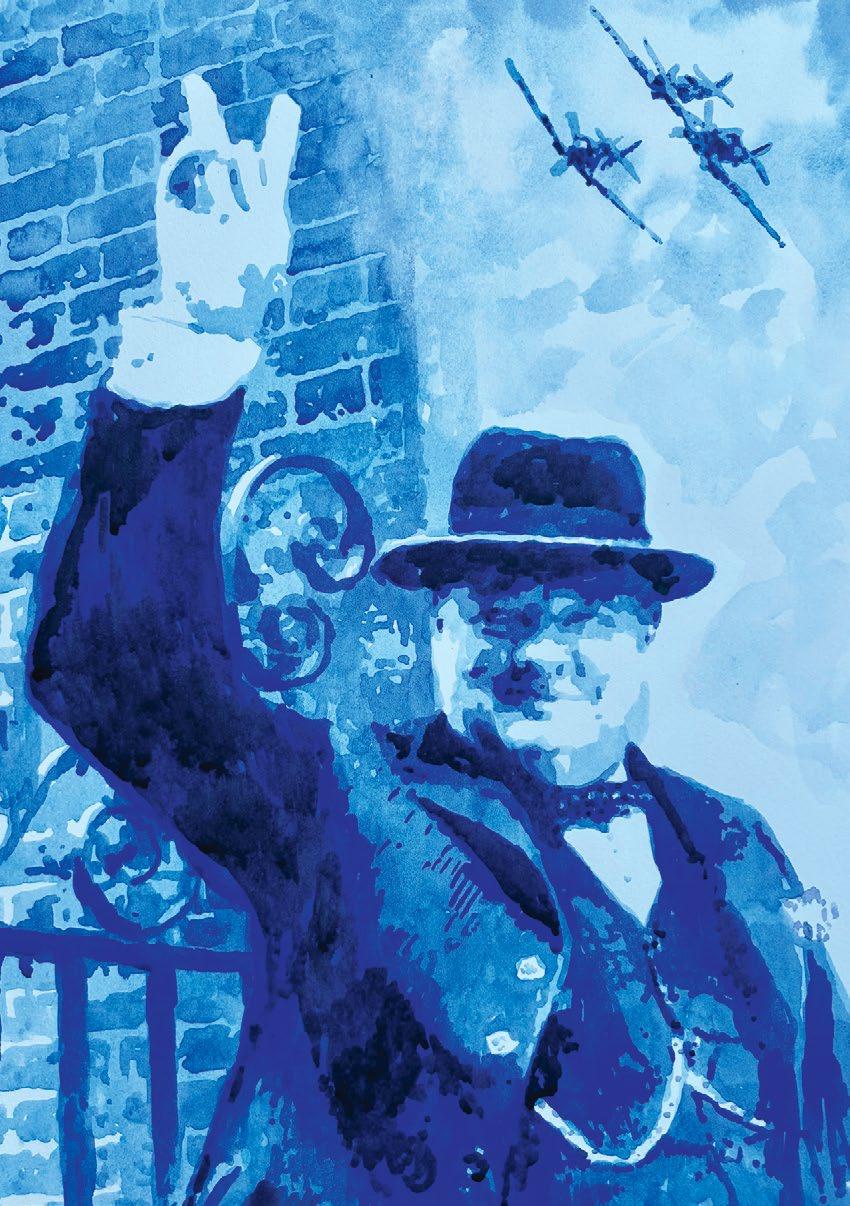
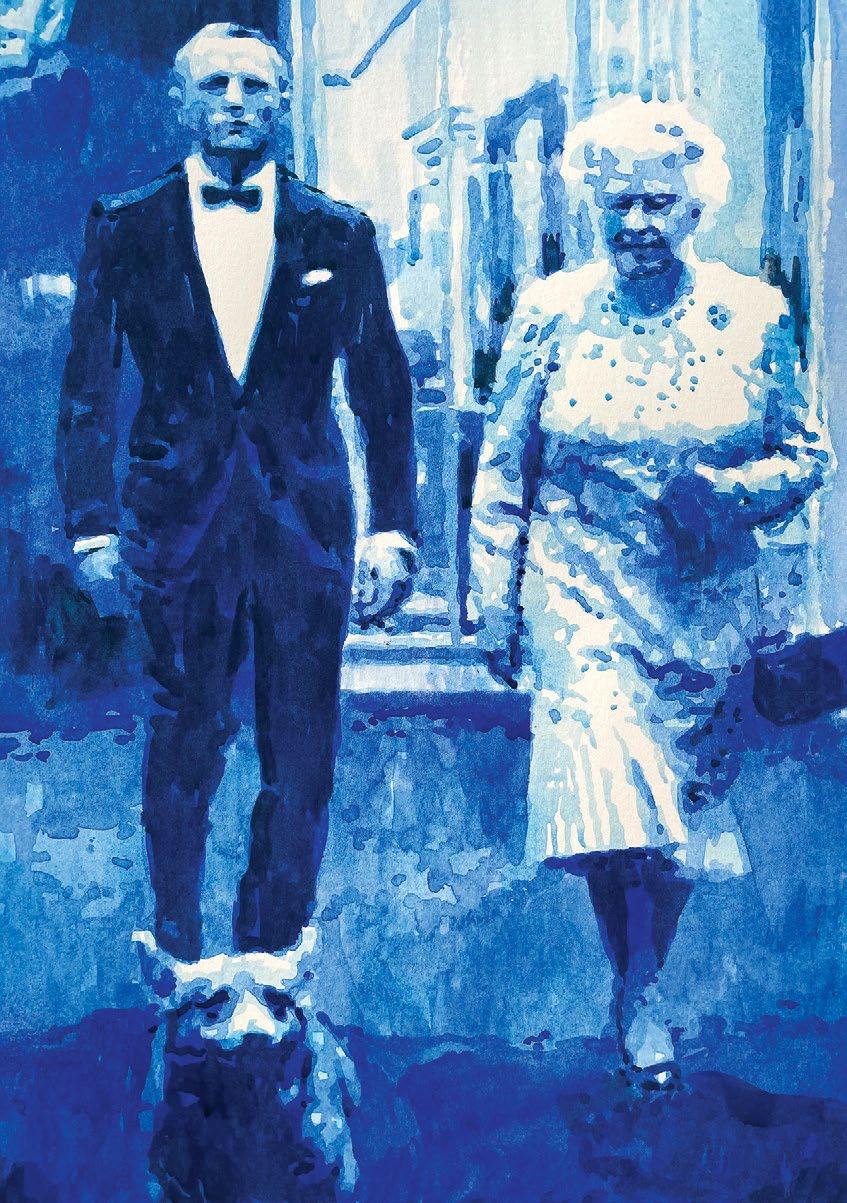
Over the last 20 years British artist Jeremy Houghton (b.1974) has been artist in residence for a number of royal, military and sporting communities, from those at Windsor Castle for HM Queen Elizabeth II to the Wimbledon championships, America’s cup and the 2012 London Olympic Games. These tonal works use a reduced palette to enhance the representation of nostalgia and occasion, and are brought together for the first time in The Iconic Collection
Studio visits & enquiries: gallery@houghtonart.co.uk / +44(0)7981 655 515
@artistjeremyhoughton www.jeremyhoughton.co.uk
Wellness is in vogue. But if you have to work at it, can you relax at the same time? Cultural historian Dr Seán Williams muses…
Wellness on holiday is too much hard work. While other hotel guests are busy detoxing and discovering their better selves, I’m happy to clog my arteries a little, wake up my liver, and return home rested, irreverent, and ready to procrastinate at my desk as much as ever before. Give me a break – because I’m on one. Surprisingly, perhaps, I find support for my reactionary epicureanism among the academic arguments of cultural studies. Carl Cederström and
André Spicer diagnosed the wellness syndrome a decade ago. They were suspicious of how society can encourage us to exercise self-discipline and work on ourselves in pursuit of endless optimisation. Even in our leisure time. To perform better at work, to be successful in relationships, or to simply be more comfortable and confident in our own skin. More broadly, what were once social questions turned into health issues. The body politic has been stressed out! And the
purpose of a spa trip, in this logic, became to recharge and reboot. No mere escapism, wellness morphed into exponentiation of the everyday and its demands: productivity squared. I can’t say I’ve suffered myself. But an ironic remedy, if an unpalatable film, appeared around the same time as this cultural critique. You may have seen Gore Verbinski’s A Cure for Wellness (2016): heavily trailed yet a box-office flop, it sought to tell a home truth to those of us who
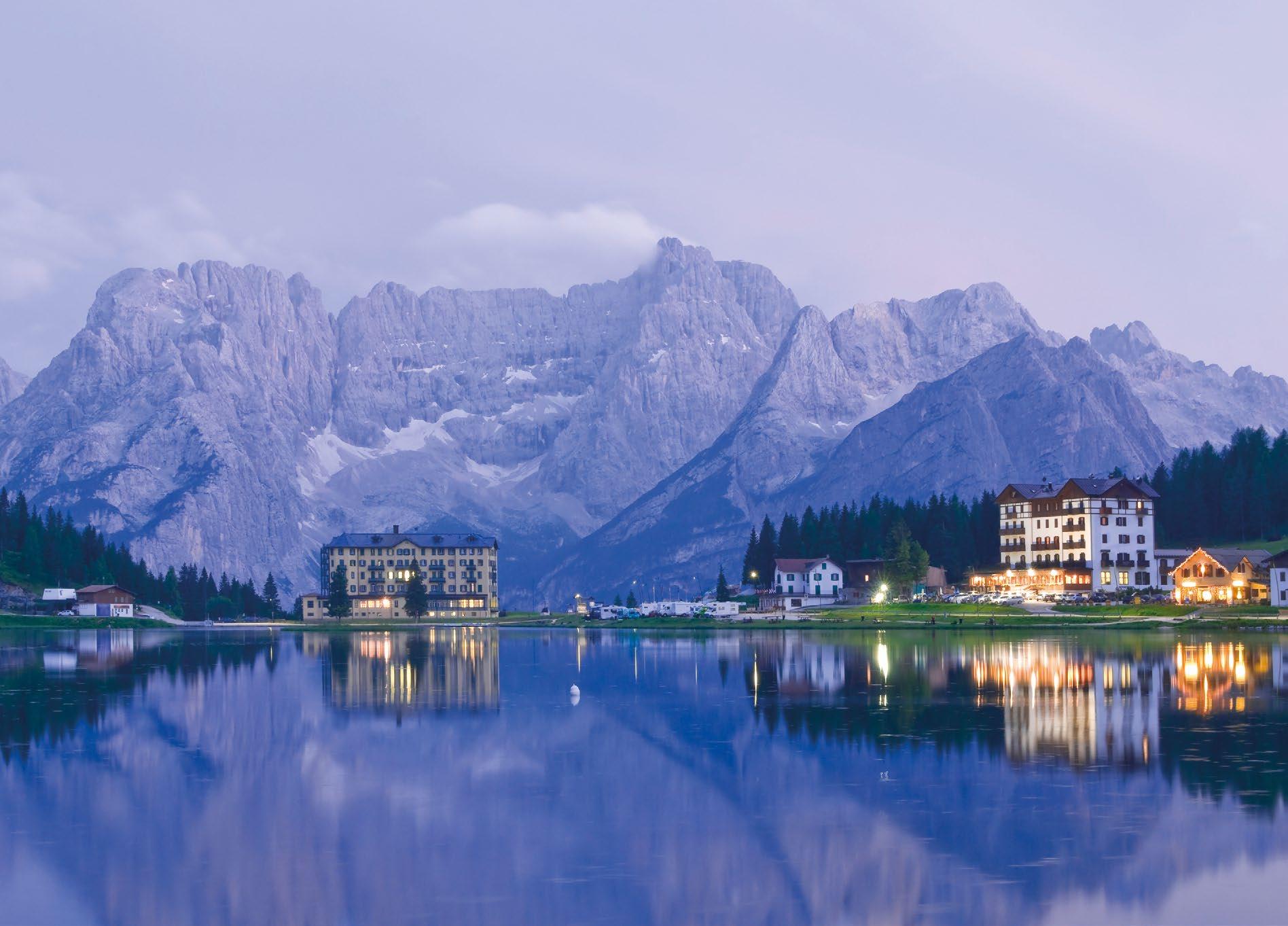


watched through to the end. The workaholic CEO of an American bank leaves for a Swiss mountain retreat and remains there, committed — or indoctrinated — to working on his unnamed condition. It was the obvious progression from kale smoothies and water coolers for him to take the waters at an Alpine spring and return refreshed and more clear-sighted for boards, deals, and fine print. And although he feels much better for getting away, the problem is that he doesn’t come back to normal life. Covert discipline for selfenhancement turns explicit, keeping him away. The doctor weighs his words heavily, with pseudo-profundity: the cure for human condition is disease, because only then is there the hope of healing. Cue all kinds of tired tropes about a devil’s elixir. Cultural studies on the big screen also borrowed its script from Thomas Mann’s classic novel The Magic Mountain, or Der Zauberberg, that was begun in the 1910s and was published in 1924. Its promising protagonist Hans Castorp, a young man with bright career prospects, takes a short trip up to a luxury sanatorium in Davos, becomes sick – and stays for seven years. Again, we’re in the
realm of exaggeration, even hypertrophy. But there’s a major difference between the modernist critique of wellness and A Cure for Wellness a hundred years later. In fact, if wellness later stood accused of expanding the work ethic into our precious time out
“More broadly, what were once social questions turned into health issues. The purpose of a spa trip became to recharge and reboot”
(respite is yoked to the service of work), in the early 20th century writers worried about precisely the opposite: our decadent withdrawal from productivity. Wellness, its treatments, and introspection are presented as unwinding and re-setting the clock for internal, individual time. And in The Magic Mountain there’s the luxury of a lot of it. The epic novel, which takes an age to read, is largely about the theme of time
itself. Its protagonist is the modernist philosopher Bergson’s conception of subjective temporality, in caricature. Castorp voluntarily stays in the stillness of a high-end sanatorium, where not much happens. Hence his nails and hair appear to him to grow quickly; in the hairdresser’s chair time comes round all the faster, and its repetitions collapse into a feeling of eternity. The problem with wellness here is that it can distort our sense of proportion, relative to the real world. That is, if you’re at the hands of wellness for more than just a day.
Sure, seclusion in Mann’s novel frees up time and the mind for important and meaningful thoughts and conversations – also on a higher, more abstract level (and up on a mountain, no less). Though Mann makes fun of these wholesome discourses, too. Their potential pomposity is pierced by that essential ingredient of literature: word play. All that talk is but quark! So says a serious soul at the dinner table (and so goes a German idiom). The food, incidentally – planned for sustenance and amusement – is exquisite, yet it quickly loses its appeal and becomes the source of lament, since life is so uneventful for the guests. (But bottles of

vintage wine remain a permissible solace – cheers to that…) Prolonged rest cures in a lounger on a balcony, looking at an empty sky, places impossible demands on the chef.
The recuperative masks of wellness can hardly hold under such strain. By this point, you might be sceptical of the criticism. Or incredulous. Your own calm cracks: can’t wellness ever do any good? Why must it be a bête noire of modern writers, whether they bemoaned a supposedly decadent retreat among bourgeois youth – or, conversely, want us to wriggle out of the straitjacket of discipline that we ourselves pick off the peg in mainstream society? Critics and authors are a contrarian lot, and change with the times. That is their very value, of course: giving voice to unconscious desires, and reading repression between the lines. It is also natural that hotels should be a perfect setting for such takes on wellness. Their history emerges from that of the spa, and a wider sense of
hospitality with its semantics of care. Book a treatment and find out for yourself. Allow me one last example, because creative responses need not be so clear cut. If we scroll back a century further still, to the
“It’s also natural that hotels should be a perfect setting for such takes on wellness. Their history emerges from that of the spa”
era of the first big hotels, a consumer revolution, and a specialisation in the medical sciences, the wellness resort was a source of compelling ambivalence for fiction. In Jean Paul’s Dr Katzenberger’s Spa Journey (1809), another novel by a German
author, we read of concern that patient choice might mean a customer is always right (regarding their prescriptions) – and, equally, there is criticism of a doctor whose commitment to medical experiments is so strong that he cannot be trusted with unsuspecting guests. Wellness is a product, and a petri dish for the democracy of knowledge, the expansion of expertise, and their relation to our bodies.
On a practical level, I am actually partial to wellness, despite my opening provocation. To the treatments, anyway – no regimes, please. The issue is really the words, the popular logics, the adverts – though those can run counter to the mainstream, too, in a bout of cutting wit. Although often rhetorically figured as the good or the bad facades of culture, as authentic or deceptive, wellness is also culture in its naked, fallible form. To me, it is interesting to think through whether and how wellness as a metaphor applies to our own historical moment.

Executive Director Andrew Stembridge talks to Fiona Duncan, hotel and travel expert at The Sunday Telegraph
Hallow’een was upon us when I dropped in to Chewton Glen to chat to Andrew Stembridge, the place was heaving with pumpkins.
Artfully piled around the entrance with the three ornamental deer that have stood for years in the forecourt, they made a joyful burst of colour on a gloomy day.
“That’s a lot of pumpkins you’ve got there.”
“If we’re going to do something,” replies Andrew, “let’s do it properly”.
I’ve known Chewton Glen for at least 40 years (in 2026, it will celebrate its 60th anniversary) and I’ve known Andrew since he became MD of the hotel in 2003. There are a handful of inspirational figures in UK hospitality (“which is a profession not an industry,” he says firmly).
Robin Hutson OBE, creator of the Pigs and Lime Wood (himself a former MD of Chewton Glen) is one; Andrew Stembridge is most definitely another. Not only has he turned Chewton Glen, in danger of fossilising when he took over, into a diverse, action-packed resort – like Gleneagles, but with the intimacy of a classic country house hotel – but he now oversees, as Executive Director of Iconic Luxury Hotels, seven further properties. “And my aim,” he says, “is to make that ten.” As well as Chewton Glen, Cliveden
House, The Mayfair Townhouse, The Chelsea Townhouse, 11 Cadogan Gardens, The Lygon Arms in the Cotswolds, Hotel Excelsior Venice Lido, and the Palm House in Miami, which has just joined the collection. Rolling out a group of hotels, especially ones as diverse as the Iconic collection, is hard to do successfully. Andrew, however, together with Iconic Luxury Hotels’ owners Ian and Richard Livingstone and the 1,000-strong team behind them, has encouraged a characteristic common to them all, one that’s central to his philosophy.
“I think you would call it spirit of generosity,” he says. “That’s a rare thing to find in a world where everyone is trying first and foremost to monetise, but if hospitality is in your blood, as it is in mine, it’s a crucial element. Our room rates are high, but we want to be generous and we want to appeal to a wide range of guests, not just the Jimmy Choo/ Hunter Welly thirtysomethings who are looking for perfection. Instead, we aim to tease out the less immediately obvious: a sense of place, authenticity and natural hospitality. Hidden stories, we like to think, beautifully told.”
In other words, Iconic hotels are spoiling, deeply comfortable, warmly welcoming hives of
genuine hospitality. “And that,” says Andrew, “only comes from the people that work there. I’ve learned that employees work for other people, not for businesses and so good team leaders are the key to success.” To this end, Andrew has implemented an Iconic leadership course and an annual leadership conference. Held at Chewton Glen over two days, team leaders from all the Iconic hotels are invited to stay and treated to champagne, hotel cuisine and world-class speakers. Andrew is passionate that hospitality can be a wonderful career for many, as it has been for him. “At 14, I got a holiday job washing up in a local restaurant. My father hoped I would be a landscape architect, as I love gardening (my 12th birthday present was a wheelbarrow), but I fell for hospitality because it’s all about communicating.”
Andrew went about his chosen career, as he says, “properly”. He graduated with joint honours in Hotel Management and Tourism from Strathclyde University and has also attended the General Managers Program at Cornell and Breakthrough Leadership Programme at Cranfield. After cutting his teeth on US hotels, he returned home, determined to become a general manager by the age of 30. That he achieved,

Spirit of generosity is a rare thing to find in a world where everyone is trying first and foremost to monetise, but if hospitality is in your blood it’s a crucial element
His were big shoes to fill. But then I thought to myself: there’s only one way I can do this job – my way
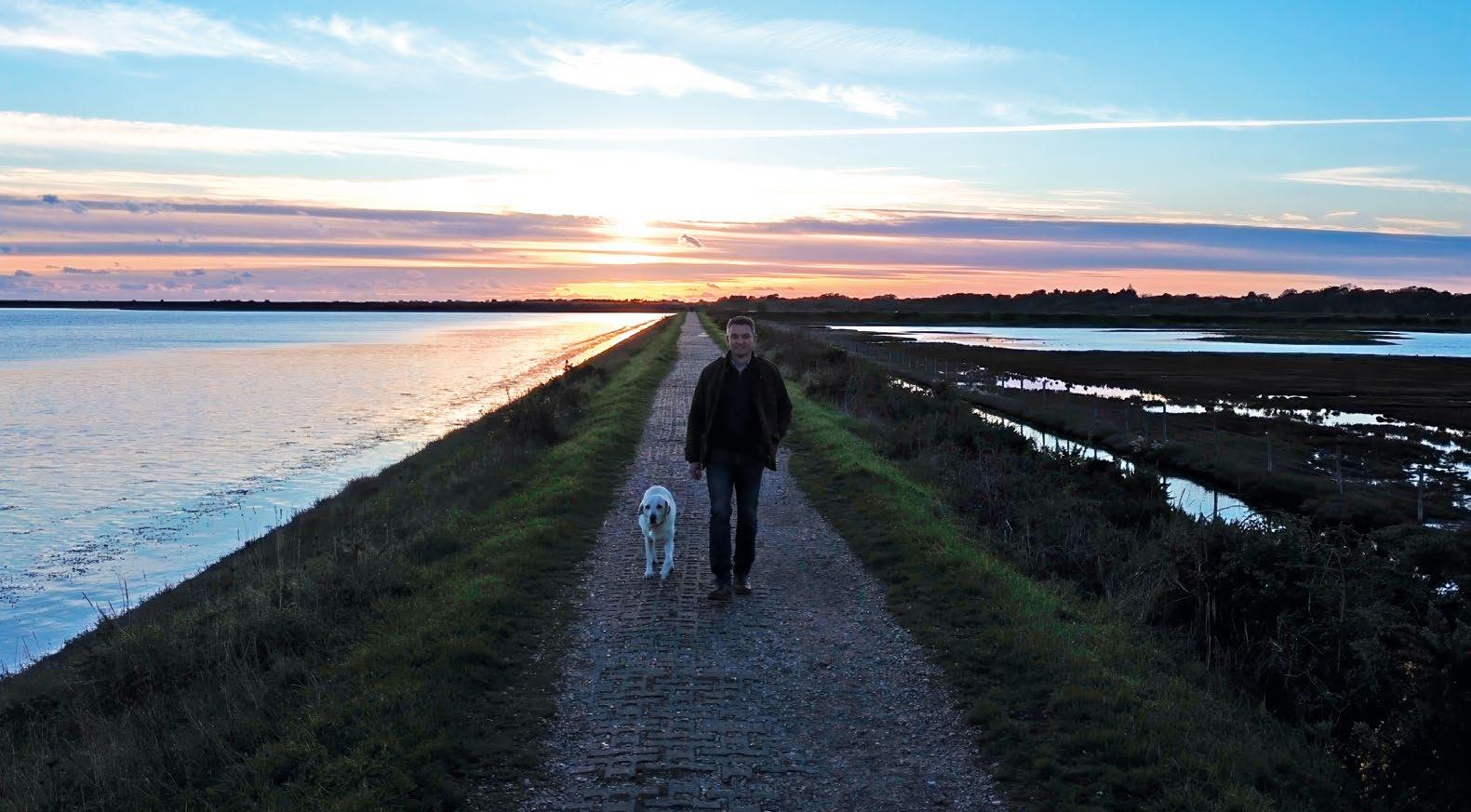
at the then new Scotsman hotel in Edinburgh. “Those two-and-a-half years were a baptism of fire: tough and challenging but formative. It was a real eye-opener, which has given me resilience to deal with pretty much anything.”
Andrew had been operations manager at Chewton Glen for three years before joining the Scotsman. In 2003 he got a call from owner, Martin Skan: would he come back as general manager, taking over from Peter Crome?
“His were big shoes to fill (literally – size 12!),” says Andrew. “But then I thought to myself: there’s only one way I can do this job – my way.” In 2006, Martin Skan sold the hotel and it became the first Iconic property.
Back to those piles of pumpkins, which look family friendly. To me, they represent the change that Andrew has orchestrated, repositioning Chewton Glen as a family hotel. I can think of no hotel in the UK where families have been integrated in such a
natural, comfortable way, without disturbing the couples and spa-goers who are also staying.
Of course, the Chewton Glen Treehouses helped. “The single most successful addition I have ever made” launched in 2012 to global interest, with 98 percent occupancy in the first month, and their popularity has never dimmed. Nor, unlike others, has the Kitchen Cookery School “probably,” says Andrew, “because it feels part of the action, not separate and clinical.”
There is no standing still. The Palm House has just opened; the Excelsior in Venice reopens in April after refurbishment; at the Lygon Arms, there are plans for 14 Cotswold cottages, while at Chewton Glen, a multi-millionpound refurbishment is about to transform the sitting rooms and restaurant. The designs, including an all-day pastry and evening cheese bar, look exciting: glamorous, animated, but above all, welcoming.
I have always maintained that hotels are, ultimately, expressions of the people behind them. Iconic hotels are grounded bastions of high standards, attention to detail and genuine hospitality, welcoming to all, including children and dogs. Andrew Stembridge, who lives with his wife Alison, two children Harry and Charlotte, Labrador Charlie and lovingly tended garden in seafaring Lymington, a few miles from Chewton Glen, is also grounded, family minded, dog-loving and a natural host. Warm, animated and a stickler for detail, he is incredibly energetic: he walks daily on the sea wall with Charlie and in his spare time he sails, cycles long distances to raise money for Hospitality Action and, at 53 years old, captains a league hockey team, the New Forest Twos. To me, the reason why the Iconic fleet has such integrity and such appeal is in great part down to the admiral at its helm.


Presenting the pinnacle of engineering brilliance: the Ferrari 12Cilindri - a masterpiece that redefines luxury, innovation, and craftsmanship while honouring Ferrari's distinguished heritage.
As the official Ferrari dealer for the south coast and based in the New Forest Hampshire, Meridien Modena is proud to offer Ferrari Approved pre-owned cars with a minimum 24-month factory warranty. Our dedicated team ensures your ownership experience is seamless, from selection to delivery, embodying Ferrari’s commitment to excellence.

The rise of the non-traditional bride is changing the wedding landscape, says Rebecca Cope
An ivory dress and lace veil, Richard Wagner’s Bridal Chorus and a threetiered wedding cake: we all know what a traditional wedding looks like. Yet in 2025, stylish modern brides are eschewing what is expected of them and instead doing things their own way, whether that is by ditching bridal white, hosting multiple-day extravaganzas or incorporating surprising decorative flourishes that truly reflect the couple’s unique personalities.
“I always found a lot of wedding traditions a bit contrived and outdated,” shares fashion PR


Amelia Penfold, who was married last summer. “As I got older, I realised that I could do things my way and take the traditions I liked and leave the ones I did not.”
For Penfold, this meant avoiding bridal dress-up, instead opting to wear something that felt true to her sense of style. “I decided to wear a white suit rather than a dress,” she explains. “I love tailoring and love to wear a suit in the evening, so it felt natural. For the party I then chose a long red dress, as I love red. I have seen many women wear things on their wedding day that do not align with their usual style, which doesn’t make sense to me.”
Fellow bride, the artist Rose Electra Harris, also turned her back on traditional ivory, choosing to wear two off-the-rack dresses by her favourite London designers. The first, for her civil ceremony, was a pale pink gown by Simone Rocha, while the second, worn for her bigger celebration with friends and family, was a bright red and pink
tulle party dress by Molly Goddard. “I very rarely wear white anyway,” she shares. “I wanted it to be colourful, because I thought it was more fun and I liked it being a bit unusual. It felt more like me.”
Choosing something that can be reworn is also top of a bride’s priority list, as we are more aware of the wastefulness of the fashion industry and its impact on the climate crisis. “I wanted a dress I could wear again,” shares Harris.
“Obviously I cannot wear my red Molly Goddard one to the pub, but I hope it is something I can wear to parties in the future.” It is also behind the current vogue for renting bridalwear – up 22 per cent year-on-year at By Rotation.
While brides like Bianca Jagger (who wore a YSL suit for her nuptials to Mick Jagger in 1971) have done their own thing for decades, it was only during the Covid lockdowns that more couples realised that they did not need to stick to tradition, as they were forced to abandon the
large-scale family affairs of old and get creative in how they celebrated.
“Lockdown forced couples to do things totally differently, but it also forced the industry to do things differently too,” agrees Penfold. “People have realised that doing things your own way and not following a formula often makes for a much more special day. I always think, from a guest’s perspective, it is much more fun to attend something that is not formulaic or a copy-and-paste version of the last wedding you attended.”
Harris agrees: “It is not that I do not enjoy traditional weddings, but I always feel that when there is a personal touch to them, and you can feel the couple through it, that it is more fun. It is the
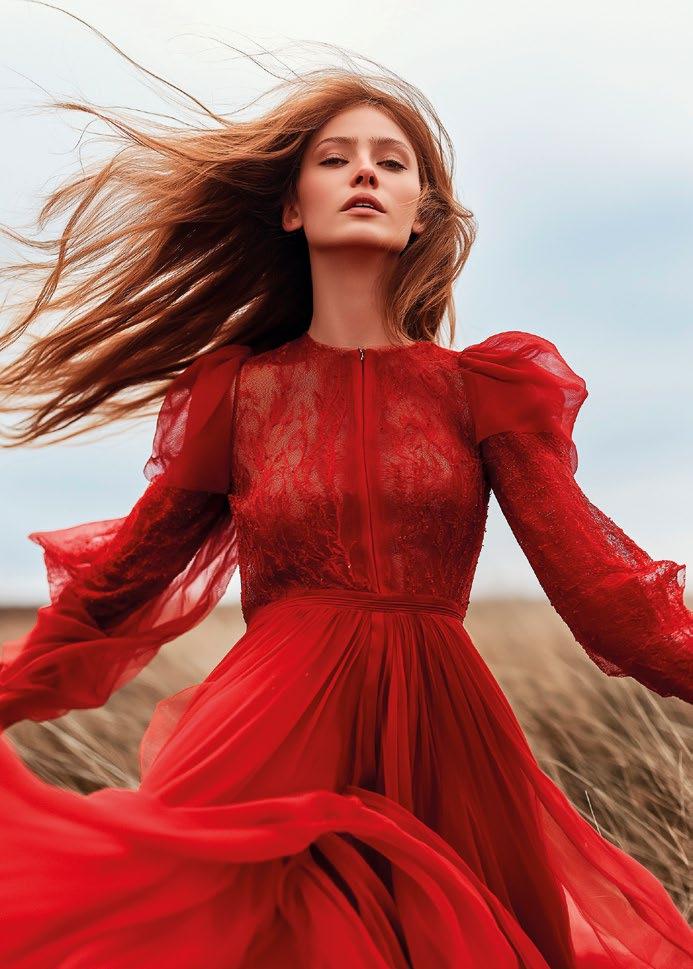

“People have realised that doing things your own way and not following a formula often makes for a much more special day”
formality that I never really liked.”
The artist and her husband certainly did this for their wedding, incorporating their shared love of Star Wars into their day, with a Stormtrooper pageboy and Darth Vader in the DJ booth. Going DIY with the decorations is another way to add an element of personality, particularly if you are of a creative persuasion, with Harris hand-painting the platters used to serve the wedding supper. Couples are also hosting multiple events to cater to different guests, finding the one-size-fits-all approach of a church ceremony followed by a reception to be lacking. “We decided to get married with just immediate family and then have a celebration with friends separately,” explains Penfold, who hosted a three-day extravaganza in the Moroccan desert for friends months after her intimate English countryside nuptials. “We did not
want to have the ceremony as a spectacle, I wanted to ensure the focus was on the ceremony and the marriage commitment itself.” Modern families do not look the same as they did a few decades ago, with step-parents and siblings far more common, so it is unsurprising that couples want their wedding days to reflect this too. “I had both my dad and stepdad walk me down the aisle,” shares creative director Imogen Snell of ISSTUDIO. “My younger brother married us in a nontraditional ceremony and my mum and multiple friends gave speeches. I find the traditional framework often does not reflect all our varying relationships and our modern lives any more. Families and relationship dynamics are complicated. I think it is so much more expressive and creative to think outside the box and do what suits and represents your life and story authentically.”


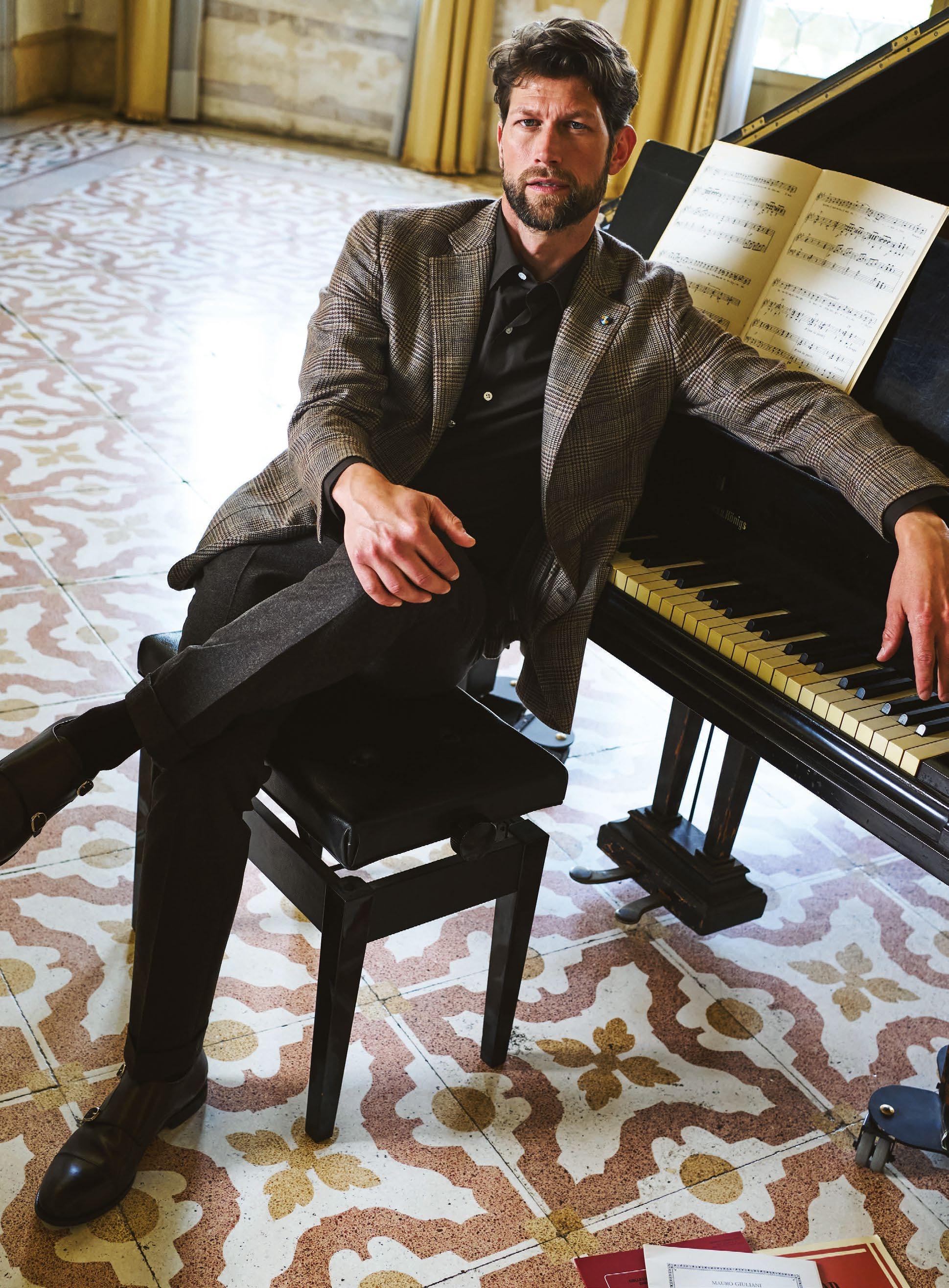

As radical breakout brand Monpure brings its unique
hair and scalp science
into Iconic Luxury Hotels, we ask its CEO, Nate Bigger, why it’s a gamechanger
The inspiration for Monpure was born out of a growing demand for hair-loss and scalp care solutions. To what extent are you leading an education-driven revolution?
We firmly believe that education is just as vital as innovation. The inspiration for our brand came from a glaring gap in consumer knowledge and available solutions regarding scalp health and its critical role in overall hair vitality. Our approach has always been education first; we aim to enlighten our customers about the scalp’s health just as one would care for their skin. With the knowledge that the skin on your body is very different from the scalp skin, we offer real specialist education. This empowers customers to make informed decisions about the products they use, ensuring they understand the science behind our ingredients and their benefits. By providing this knowledge, we are not just selling products, we are changing how people think about and care for their hair, from the root to the tip.
You’ve spoken about empowerment and shifting the focus from styling to health. Is this why Monpure is different?
Exactly. Monpure stands out because we empower our customers to take control of their hair health by focusing on the root of the problem. Unlike traditional haircare brands that concentrate on cosmetic styling, our products are designed to nurture the scalp, thereby enhancing the hair’s natural growth and vitality.
My inspiration came from being raised by a single mother who was a model during the 1990s supermodel era. I spent my childhood backstage at fashion shows across the globe. While the fashion world glittered with glamour on the surface, I also witnessed the harsh realities models faced behind the scenes, particularly the damage inflicted on their hair by relentless styling and harsh chemicals. Season
after season, models suffered noticeable hair loss and degradation. Recognising a gap in the market for products that focus on both hair and scalp health, I established Monpure to shift the haircare conversation from mere styling to comprehensive health and wellness.
In an industry dominated by big legacy brands, do you see yourself as a disruptor?
Yes, I do. When I started this company, it was in response to the stagnation I observed in the haircare sector, where big legacy brands often recycled old ideas without focusing on genuine innovation or consumer health. Monpure challenges this status quo by merging dermatological science with traditional
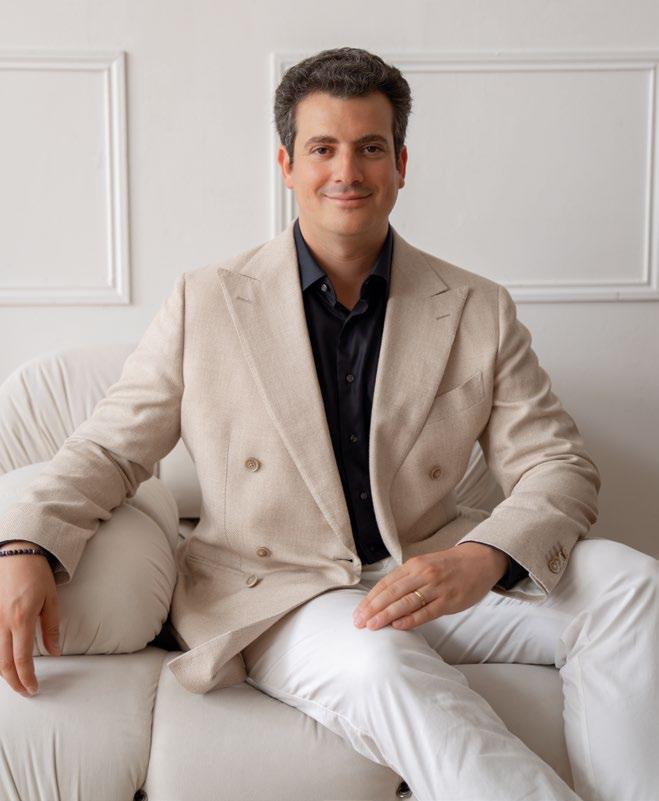
haircare, which has introduced a new paradigm in a market ripe for change. We have embraced a role that not only challenges but also reshapes industry standards around health, efficacy and sustainability.
Harnessing the power of science? What does that entail and how does it work?
Harnessing the power of science involves integrating dermatological research with our product development to create formulations that address hair and scalp health at a cellular level. This means choosing bioavailable and micro penetrating ingredients that can effectively remedy scalp issues and improve hair growth. For example, our products feature ingredients such as retinol and lactic acid, which are typically found in skincare but are excellent for stimulating cell renewal on the scalp as well. This scientific approach ensures that our products are not just effective but also revolutionary in promoting hair health.
What’s your approach to ethics and sustainability?
Our commitment to ethics and sustainability is integral to every aspect of our operations. From sourcing ingredients to packaging, we strive for transparency, sustainability, and ethical practices. Our belief is that luxury brands should lead, not follow, in promoting industry standards for ethics and sustainability. We are a certified B-Corp, a status
that recognises our commitment to high standards of social and environmental performance, accountability and transparency. Our products are vegan, cruelty-free, and sourced within the UK and Europe to minimise our carbon footprint and support local industries. We do not overly publicise our sustainable practices because, for us, advancing sustainability is a fundamental aspect of our operations, not a marketing strategy. We believe that true luxury seamlessly incorporates these principles as a given.
Tell us about Monpure’s partnership with Iconic Luxury Hotels – what does it mean for guests?
We are proud to partner with Iconic Luxury Hotels, bringing Monpure’s specialised scalp and hair health treatments to some of the most beautiful settings in the hospitality industry. Guests can enjoy exclusive treatments that leverage our expert formulations, enhancing their luxury experience with a focus on wellness and self-care. This partnership allows us to introduce our innovative scalp-care philosophy to a wider audience, providing treatments that align perfectly with the sophisticated environments of Iconic Luxury Hotels. It is a privilege to offer these unique services, ensuring guests not only enjoy their stay but also leave with healthier, revitalised hair and scalp. The partnership aligns perfectly with our mission to transform everyday routines into luxurious, health-focused rituals.

“OUR BELIEF IS THAT LUXURY BRANDS SHOULD LEAD, NOT FOLLOW, IN PROMOTING INDUSTRY STANDARDS FOR ETHICS AND SUSTAINABILITY”

The McLaren story reads like something out of Boy’s Own
Founded 60 years ago by a young but doomed genius, it builds both legends and astounding futuristic supercars at its space-age Surrey HQ
Inside the restaurant at McLaren’s Woking home the atmospheric pressure is kept lower than everywhere else in the building. This prevents the smell of food from spreading. Throughout the complex, every screw head is tightened to the vertical, not the horizontal, so they do not attract dust. The supporting blades on the building’s façade look like an F1 car’s suspension wishbone, the glass lifts resemble a piston. There are half a million Italian tiles on the floor, but none was cut to fit – the building was created around them.
Such obsessive attention to detail befits a construction that was briefed to architects Norman Foster & Partners as “90 per cent NASA, ten per cent Disney”. The fastidious, exquisite way they set about realising that brief 20 years ago would certainly have been appreciated by the man whose own obsessive genius started it all back in 1963 – Bruce McLaren. This uniquely gifted young New Zealander came to Europe aged just 21, and created from nothing a race team and, later, supercar maker that revolutionised the world of automotive high performance, taking on and beating the mighty Ferrari.
On the track, McLaren’s roll of honour has included 12 F1 Drivers’ Championships, eight F1 Constructor’s titles, 184 race wins, a total domination of America’s thunderous Can-Am series, and victories at Le Mans and the Indy 500, making legends of names such as

Senna, Lauda, Prost, Hunt, Häkkinen and Hamilton. On the road, Bruce envisioned injecting racing know-how into a road car by creating the radical M6 GT in 1969, which paved the way first for the world’s finest road car (1992’s McLaren F1), and later for the creation of countless astonishing cutting edge supercars inside the Woking dream factory…
Bruce was just 26 years-old when he started his eponymous racing team in 1963, but he had already packed a lot into those years. He won his first race, a hillclimb in New Zealand, aged 15, and at 21 was selected for the ‘Driver to Europe’ scheme, joining the Cooper F1 team. A year later, victory at the US Grand Prix made him the youngest ever F1 winner. But driving was not enough – Bruce wanted to build his own cars.
By 1966 he was racing in an F1 car he had designed himself, and two years later became only the second driver in history (after Jack Brabham) to win in a car bearing his own name. But it was quickly obvious that Bruce was an even better designer, engineer and pioneer than he was a driver. In 1967 he invented ground effects aerodynamics on the Can-Am conquering M6A, and a year later helped pioneer aerodynamic wings in F1, establishing a principle that has held good to this day: science rather than aesthetics is the key to winning on track. Bruce’s

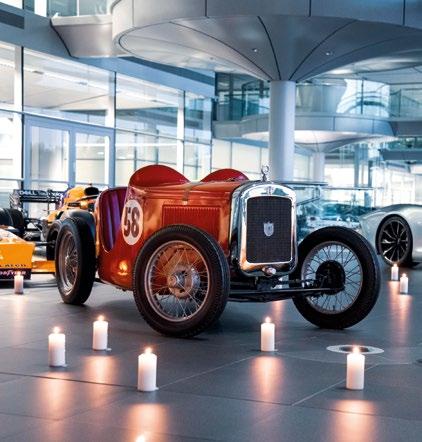

story had a tragic end. In 1970, aged just 32, he was testing the new McLaren M8D at Goodwood circuit when the rear bodywork failed, spinning the car into a trackside bunker and killing him instantly.
Prophetically, six years earlier Bruce had written about the death of teammate Timmy Mayer: “The news that he had died instantly was a terrible shock to all of us, but who is to say that he had not seen more, done more and learned more in his few years than many people do in a lifetime? To do something well is so worthwhile that to die trying to do it better cannot be foolhardy. It would be a waste of life to do nothing with one’s ability, for I feel that life is measured in achievement, not in years alone.” It was as if Bruce had penned his own epitaph.
Bruce’s death might have been the end for McLaren, but it was just the beginning. Such was his gift as a leader he left behind an organisation even more determined to fulfil his legacy after he had gone. The team’s first F1 title came in 1974 with Emerson Fittipaldi, followed by James Hunt’s infamous 1976 triumph over Ferrari’s Niki Lauda, immortalised in Ron Howard’s movie, Rush. Then, in 1981, the team merged with Project Four Racing, run by another obsessive genius: Ron Dennis.
It was Dennis, a skilled race mechanic and shrewd businessman, who supercharged the team, changing the game by introducing carbon fibre, a substance so strong and so lightweight it quickly became unimaginable to design a race car without it.
“When I came into motor racing so many things were a black art,” said Dennis. “But black art was a cloak for ‘we don’t really know’. It was intuitive engineering. I decided to make it a science. We
will develop science to make winning a certainty.”
Carbon fibre technology not only led to racing success, but enabled McLaren to astound the car world with the roadgoing F1, the first production car to use a complete carbon fibre reinforced polymer monocoque chassis. The F1 packed a raft of innovations including ground-effect aero, an arrow-shaped three-seat cockpit configuration and a magnesium substructure, and with its 240mph top speed still remains the world’s fastest naturally aspirated road car.
Dennis’s infamously fastidious approach to everything was behind the building of the Woking factory in 2004. Officially called MTC (McLaren Technology Centre), it was a masterclass in macro vision meets micro detailing, a swooping fantasy in glass and stainless steel which, when viewed from above, forms a perfect circle with its surrounding lake. Every room in the building was set to precisely 21degC, deemed by Dennis to be the optimum working temperature.
But although MTC was a stunning HQ, it could not cope with Dennis’s ambitious plans to turn McLaren into a major supercar manufacturer when McLaren Automotive was born in 2010. So, a second building, equally ambitious, equally minutely specified, was built next door. Called MPC (McLaren Production Centre), it had to be built half-buried underground to meet planning stipulations, and had to be delivered in just two years – a third of the time MTC had taken.
A dozen years after its opening, MPC is a car factory with the feel of an operating theatre, where 2,000 skilled technicians have hand assembled more than 30 different McLaren models to date, including
“IT WOULD BE A WASTE OF LIFE TO DO NOTHING WITH ONE’S ABILITY. I FEEL THAT LIFE IS MEASURED IN ACHIEVEMENT, NOT YEARS ALONE”




modern legends such as P1, 750S, 765LT and the McLaren Senna – cars that lead the world in 2025.
And then there is the newest McLaren, Artura, a car which looks even more futuristic than the factory in which it was built. Like every McLaren road car before it, Artura is a ferociously quick, deft-handling, achingly beautiful supercar, unthinkably lightweight due to its carbon fibre chassis, visually dramatic, thanks to its dihedral doors and rapturous curves. But unlike every McLaren road car before it, Artura is a petrol/electric hybrid. It can run silently on electric power for more than 20 miles, produces barely 100g/km of CO2 and achieves 60mpg. It is the future of the supercar.
Creating the future has defined McLaren since day one, its relentless innovation constantly challenging the accepted norms both on the racetrack and on the road. In 2012 the breathtaking P1 became the first hybrid hypercar, and in 2019 the teardrop-shaped Speedtail ‘hyper-GT’ took the technology to new heights, using a groundbreaking high-power cylindrical battery cell, active rear bodywork and static carbon fibre aero front wheel covers. At 250mph flat-out, Speedtail became the fastest hybrid, and fastest McLaren road car, ever made. These innovations demonstrate McLaren’s commitment to clean green ultra-performance, which will lead to fully electric supercars in years to come. But the one thing that every McLaren,
past and future, has in common is innovation – in design, technology, engineering, performance and driving experience. “From the very beginning of the Artura project, designing and engineering the car has been all about challenging ourselves to innovate, pushing and pushing to achieve everything we knew a next-generation, high-performance hybrid McLaren supercar had to be,” says Phil Mockford, McLaren’s supercar line director. “As a result, the Artura is all-new; the carbon fibre monocoque, the electrical architecture, the body and interior are all new. So too is the V6 engine, the transmission – which also integrates a new type of electric motor for the industry – as is the rear suspension concept and our first ever electronic differential.”
McLaren stands for different things to different people, but this story has a lot of everything –courage, ambition, excitement, tragedy, achievement, vision, heroes, legends… All of it tucked away behind the 100,000 trees that have been planted on the 50-hectare Woking site since MTC was started. Begun by a Kiwi, but today a thoroughly British, future-facing success story.
“McLaren started as the dream of one man,” said Dennis. “It’s since grown to encompass the hopes and dreams of more than 2,000 men and women. The cars that our children and grandchildren will be driving in the future will be greener as a result of high-tech lessons we’ve learned.”
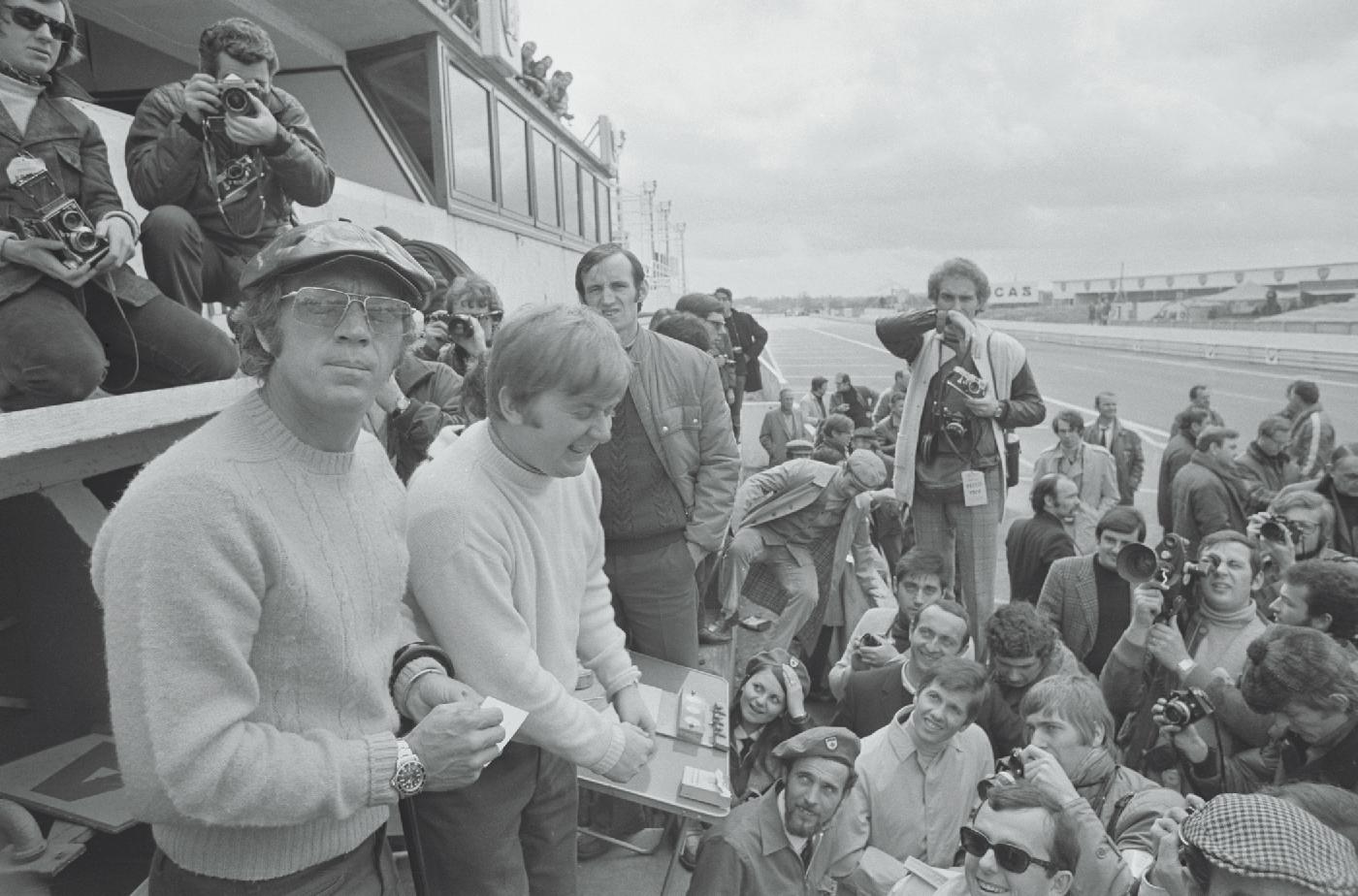
In 1970 McQueen embarked on a cinematic passion project as executive producer and lead in the cult classic film Le Mans®. During the project, McQueen wore a distinct and much-loved pair of sunglasses. This season, working closely with McQueen’s family Renauld have faithfully reimagined a limited edition collection of McQueen’s exact sunglasses.
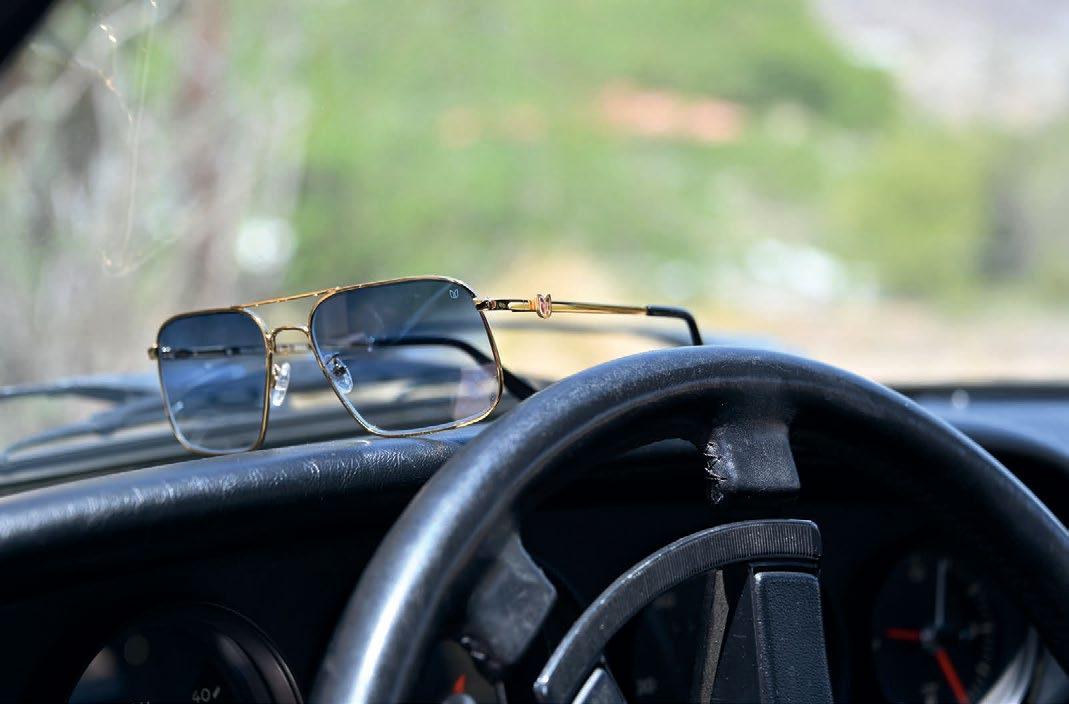

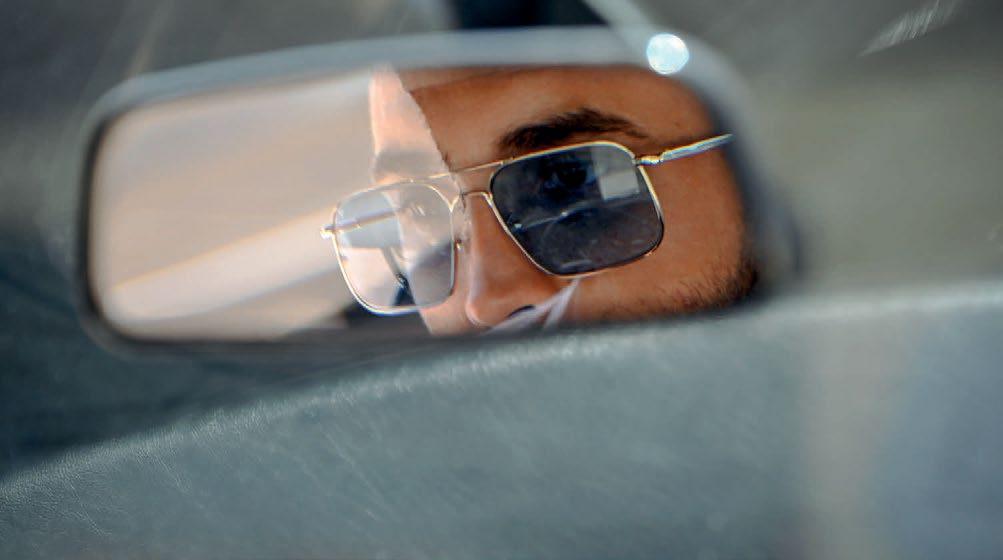
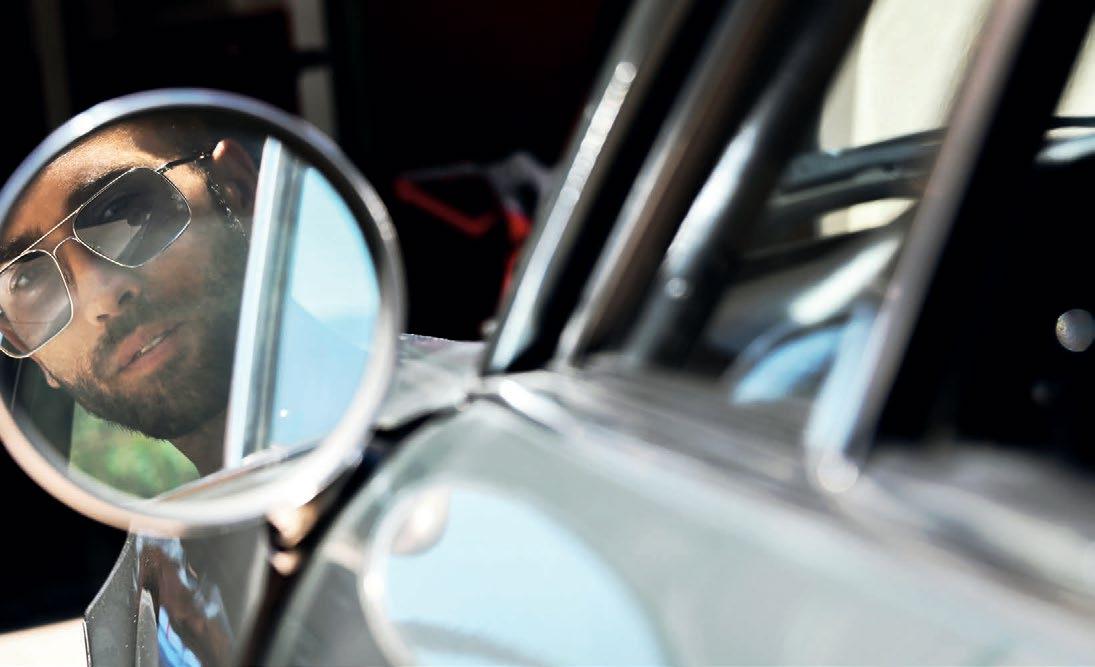
The ‘Car 20’ sunglasses house an authenticated part of McQueen’s own Porsche 917 race number 20 encased in the Renauld Keepsake Marque. The Steve McQueen® Le Mans® sunglasses are presented without the addition of a Keepsake.
This has been an incredibly personal project for all involved. The passion for automotive vehicles and racing is as much in the blood of the McQueen’s as it is in Renauld: “Racing is life. Anything before or after is just waiting”, Steve McQueen
Steve McQueen by Renauld is the first sunglasses to house ValueBond. ValueBond is a pioneering way of establishing authentication and verification of Renauld sunglasses with a smartphone.* It also permits gateway access to exclusive Renauld VIP content to inspire and educate. *Available with select sunglasses.


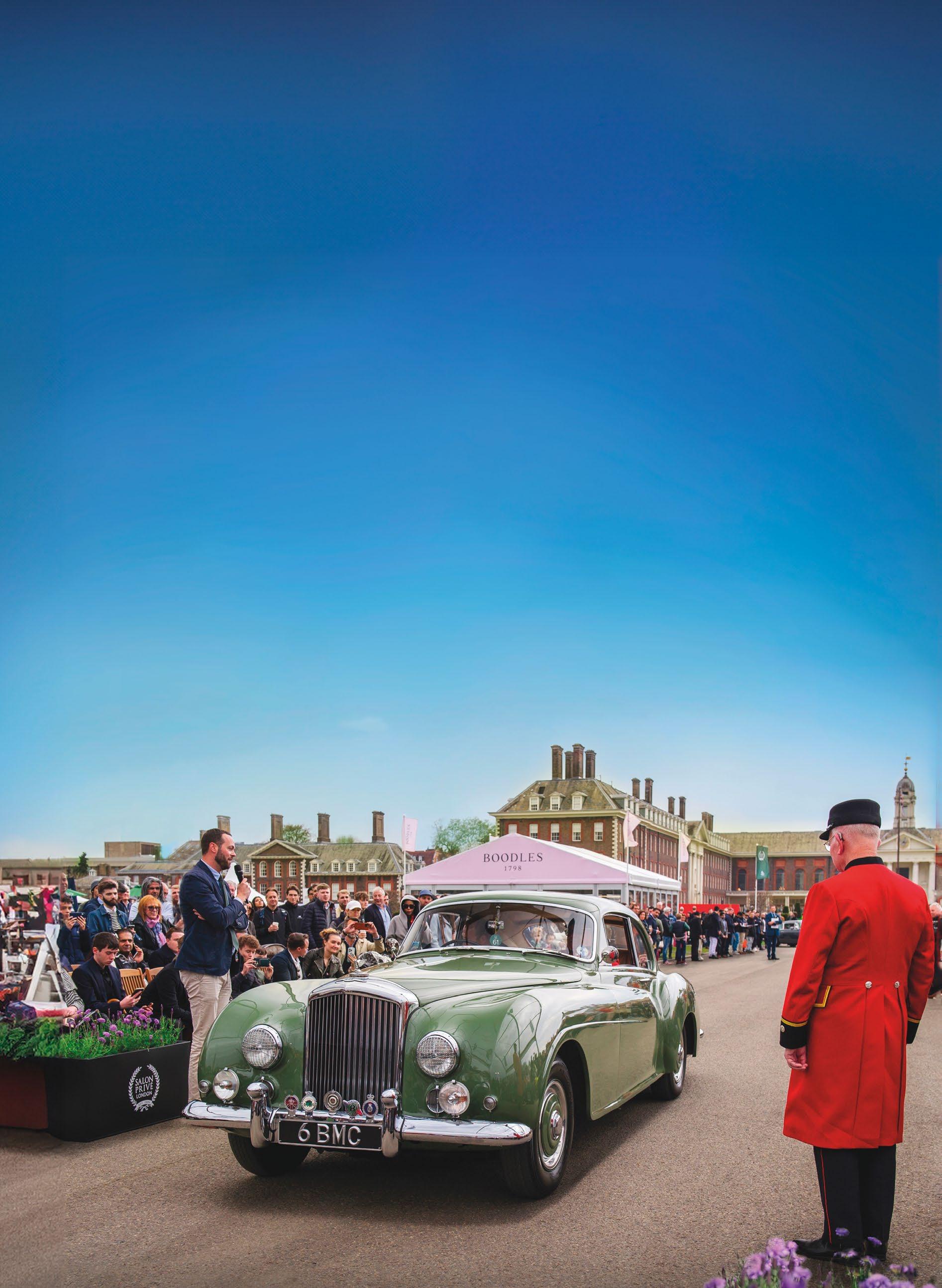
Art, flowers, horses, cars… all are celebrated annually on the fabled lawns of the Royal Hospital Chelsea
Steeped in history and tradition, the Royal Hospital Chelsea is a London landmark of noble distinction. Nestled amid lush green trees and lawns on the banks of the River Thames, this eye-catching establishment is perhaps most famous as the home of the Chelsea Pensioners, whose smart scarlet uniforms are part of the great British tradition. But the hospital has taken on
a new status in modern times, becoming synonymous with a highly selective range of events, each celebrating the pinnacle of luxury, quality and the finer things in life. Comprising four annual events, including the globally renowned RHS Chelsea Flower Show every May, the RHC’s exquisite roster has made it the go-to destination for luxury in West London.
Its beautiful lawns lend themselves to a chameleon-like flexibility, being transformed in turn into a show-jumping arena, an art gallery, an automotive concours and, of course, a horticultural extravaganza. The hospital’s original purpose back in 1682, when it was founded by King Charles II, was to provide a home for those “broken by age and war”.
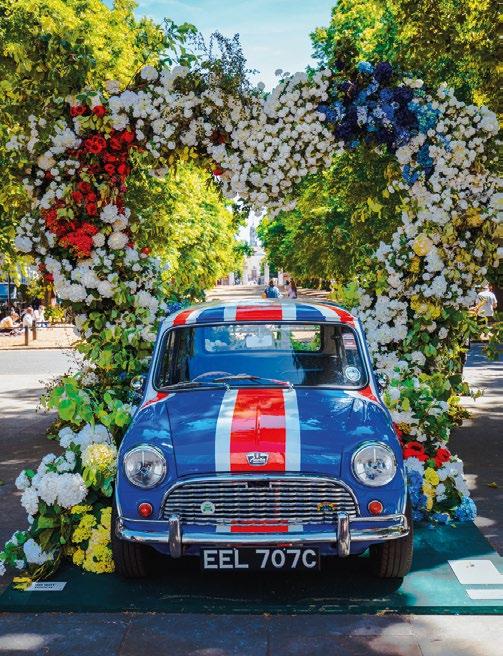

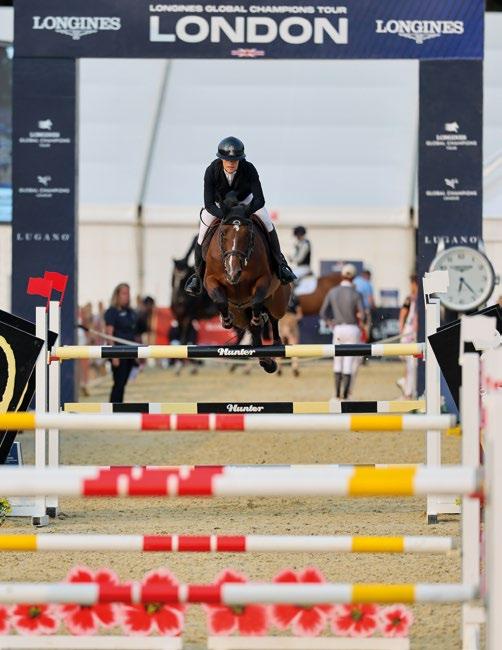
Designed by renowned architect Sir Christopher Wren, who was inspired by the Hôtel des Invalides in Paris, the hospital welcomed its first 99 pensioners in 1692. Today, the building has around 300 residents – veterans of the British Army who have chosen to live at the hospital as part of a unique community, surrendering their Army pension in exchange for full board and lodging.
The Great Hall features a magnificent mural of King Charles II on horseback and every May, on Founders Day or Oak Apple Day, the pensioners wear oak leaves to honour the time when, after the Battle of Worcester in 1651, the future king hid in an oak tree.
The Royal Hospital suffered significant damage during wartime and was directly hit in the Blitz. Its historic buildings have been meticulously restored over the years. The Soane Stable Yard recently opened to the public after three years of refurbishment. It was designed and built between 1814 and 1817 by architect Sir John Soane, who was the hospital’s Clerk of Works for 30 years.
In 1698, the hospital’s extensive grounds were transformed into the Ranelagh Pleasure Gardens by
“Salon Privé London showcases the finest in classic and modern vehicles, concours-quality cars offered not just for judging but also for sale”
The friendship between the UK and Australia has been celebrated at The Ceremony of the Christmas Cake since 1949. Each year, an Australian state donates an intricately decorated cake, which is cut using a ceremonial sword. The pensioners sing both national anthems and Waltzing Matilda
Richard Jones, 1st Earl of Ranelagh. A young Mozart performed at the spectacular Rotunda concert hall, which was demolished in 1805. Traditions are central to life at the Royal Hospital, especially at Christmas time. During 80-yearold ceremony The Stirring of the Christmas Pudding, residents help to prepare a giant pudding for Christmas Day. The Ceremony of the Christmas Cheeses dates back over 300 years. A large British cheese is cut by a pensioner, after which residents enjoy canapés and bubbly and sing The Quartermaster’s Stores
The year of luxury events at RHC begins in spring, when the grounds roar into life as the capital’s most prestigious automotive occasion, Salon Privé London, showcases the finest in classic and modern vehicles. The show is a mix of concours-quality classic cars offered not just for judging but also for sale, plus numerous UK debuts for the world’s most exotic and desirable new cars, and attracts an audience of discerning customers. Visitors to the 2024 event witnessed a record-breaking gathering of 14 Aston Martin Valkyrie hypercars, as well as 50 Porsche 911 Turbos, one for each of that model’s years in production. Concours de Vente prize-winners included a 1930 Bentley Speed Six and a 1983 Lamborghini Countach 5000S, while a 1966 Rolls-Royce Phantom V Touring Limousine won the hearts – and votes – of the
Chelsea Pensioners. Salon Privé London 2025 is on 10-12 April.
May sees the fast and furious replaced by the fragrant and floral as The Royal Horticultural Society (RHS) Chelsea Flower Show takes root. The world-renowned show celebrates the best in horticulture with its award-winning gardens and stunning floral displays.
Visitors can stroll around the show gardens, each depicting its own unique theme.
The Great Pavilion hosts the finest of floral art and the best of seasonal produce, painstakingly ripened to the peak of perfection in time for the show. His Majesty the King became Patron of the RHS in 2024. RHS Chelsea Flower Show returns on 20-24 May 2025. In late summer, the South Grounds hosts the London leg of The Longines Global Champions Tour (LGCT), where world-class show jumpers compete for prizes and prestige. Last year’s competition took place in 16 destinations in 13 countries, across three continents from the Americas to the Middle East. With more than €36 million in prize money, the LGCT brings
“Natural wonders on display included the fossil of a 180-million-yearold pregnant Ichthyosaur, meteorites and the hind leg of a mammoth”
can marvel at the beautiful, the historic and the cutting-edge over six days. The 2024 fair featured an eclectic mix of artefacts –everything from a Cycladic figurine dating from 2700-2300 BC to a sculpture walk with works by 20th- and 21st-century British women artists. Natural wonders on display included the fossil of a 180-million-year-old pregnant Ichthyosaur, meteorites, giant gems and the 2m-high hind leg of a mammoth. The Treasure House Fair returns from 26 June to 1 July 2025.
together the top 30 riders in the FEI Jumping World Rankings. Fifteen Olympic show jumpers, including all four gold medallists from Paris 2024, hotfooted it to London to compete, and 25-yearold Brit Harry Charles took the LGCT Grand Prix title on 11-yearold horse Sherlock, which he has ridden since he was five years old. In late summer, the hospital grounds become a magnet for art lovers at The Treasure House Fair. Exhibitors, collectors and visitors
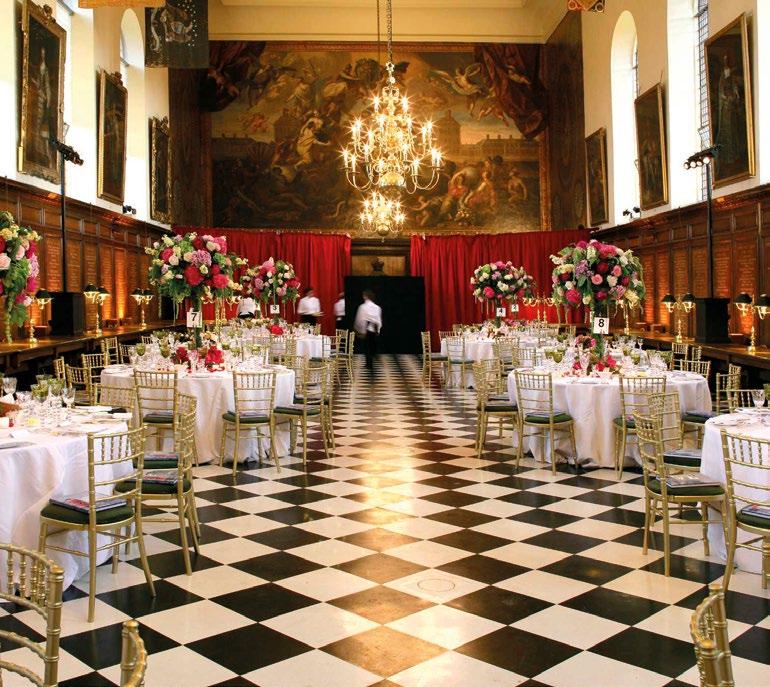
Aside from hosting special events, the hospital welcomes visitors year-round. If you are staying at The Chelsea Townhouse, 11 Cadogan Gardens or The Mayfair Townhouse, you might like to find out more about its fascinating history and traditions at the Chelsea Pensioner Museum. Admission is free, but booking in advance is strongly recommended. See chelsea-pensioners.co.uk/ museum
Visitors can also pay for a guided tour of the hospital led by a Chelsea Pensioner. See chelseapensioners.co.uk/tours



